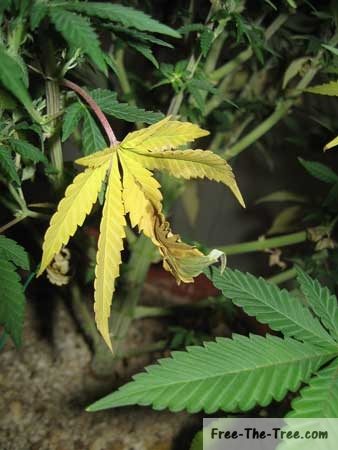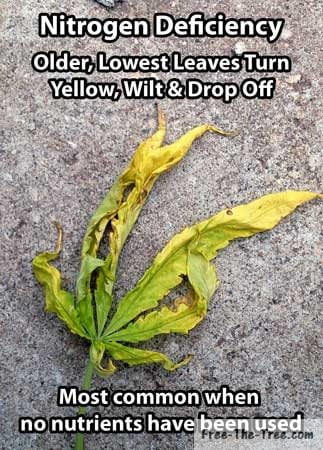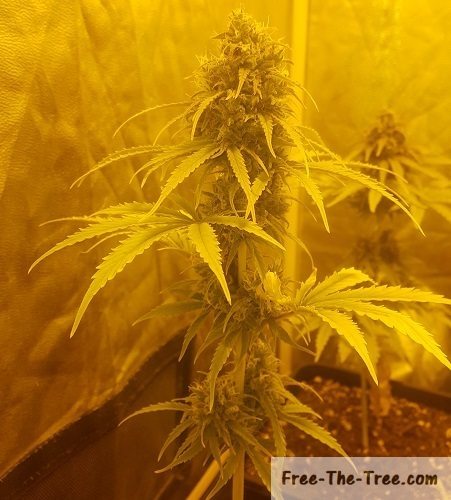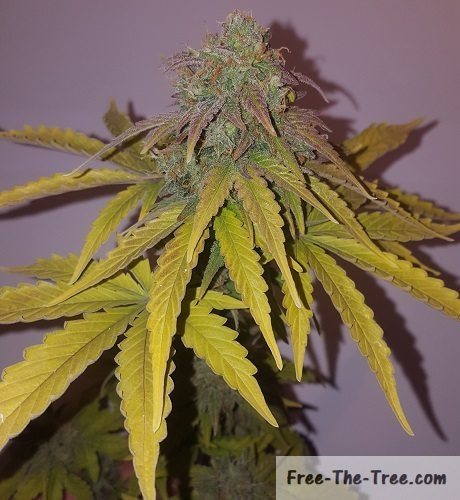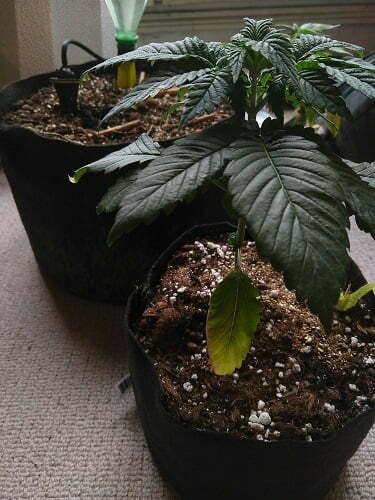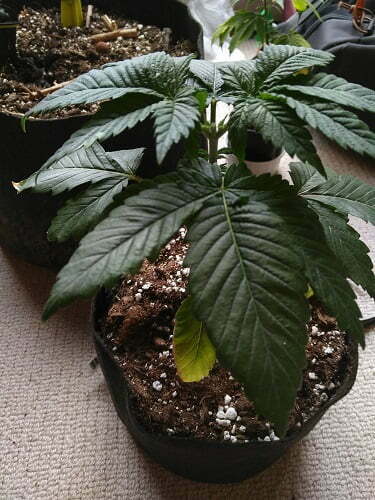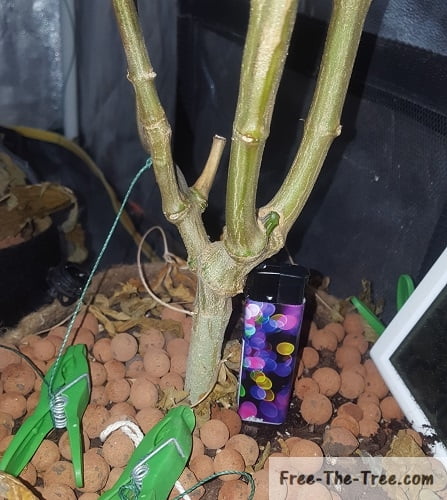During the vegetative stage your going to need to transplante you plant at least once. The question is when to do it, and how to do so.
The second thing you will encounter are nutrient issues, most likely Nitrogen deficiency. It is the most common issue during the Vegetative stage, luckily easy to fix too.
Let’s get into it
Transplanting your Marijuana plant
Here we’re going to cover
When to transplant your plant
You want to transplant to a new pot when the roots have fully invaded the soil and are ready to grow into a new space.
How to find out when to transplant easily?
I find that the best way is to track how often you have to water your plant. If you’re watering every day or two then the roots have invaded the space and you should be transplanting soon.
How to transplant your Marijuana plant
- Make enough room in the soil for your plant.
If use one of your current pots to make the whole your plan will fit juuuust perfectly 😉 - Tap with your nails along the sides of the pot, on all 4 sides and all levels. This will get the roots loose in case they’re stuck to the pot
- Turn the plant up side down and try to slide the pot off, it should come easily. If it doesn’t don’t force it, just go back to step 2.
- Place the roots into the space you’ve made in the new pot.
It’s important to note that the best time to transplant is between 2 waterings, when the soil isn’t too humid, but not all dried up either
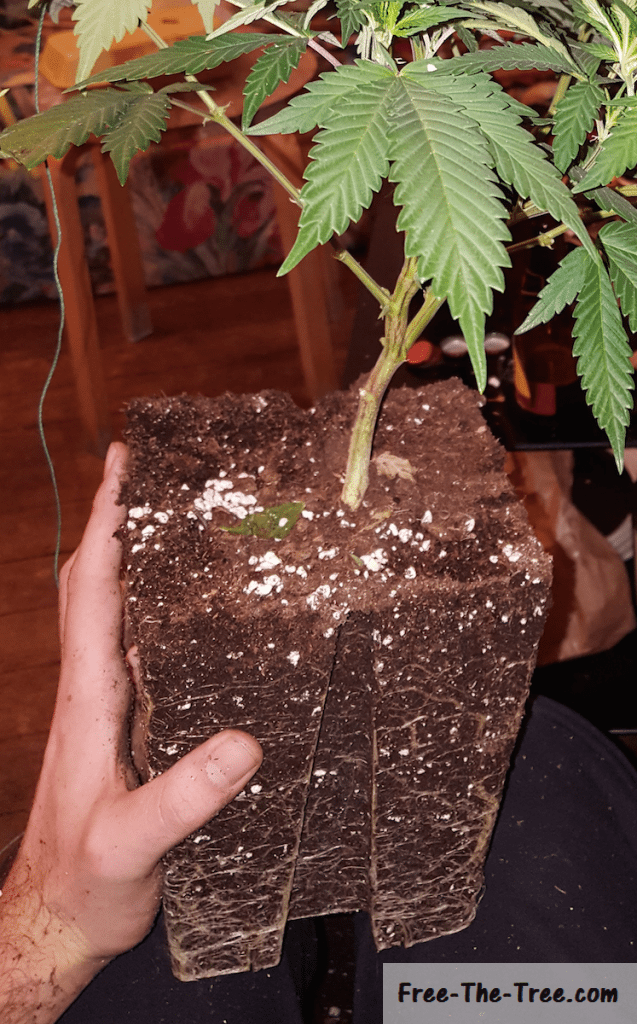
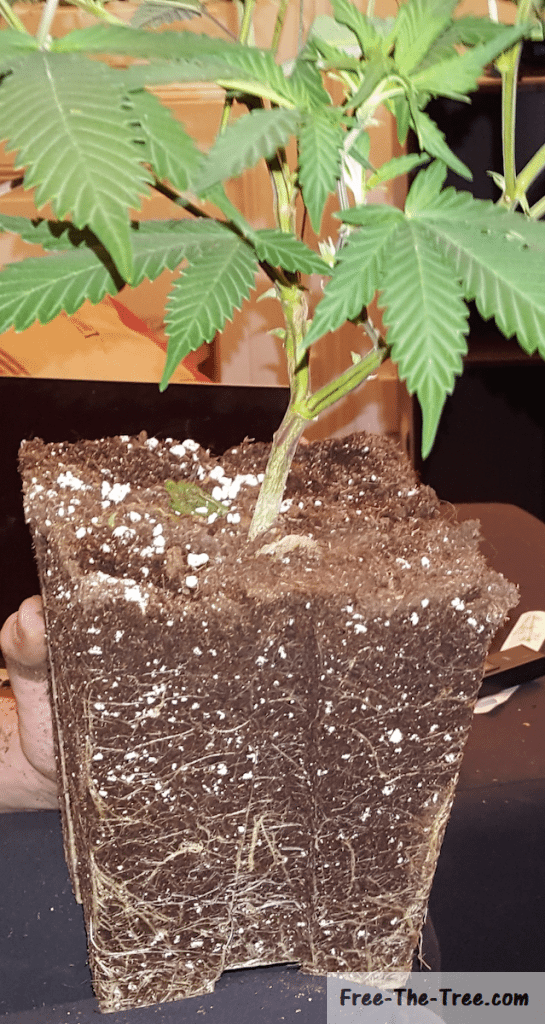
What to do after transplanting your plant
The most important thing here is to mainly water the new soil. Just like when you got the cuttings into the soil, you want your roots to invade the new soil as quickly as possible.
The best way to do this? Keep that soil more humid than the older one, so when you water your plant focus on it.
I find that adding a little more root booster at this times give a nice little boost to it.
During the next week or two you will see the effects of having more room, she’s going to love her new home!
Now that you know how to transplant you Cannabis baby, let’s get into the deficiencies and other issues we encountered during her vegetative stage.
Deficiencies during the Vegetative Stage
During this time period we got 2 main issues. The first, Nitrogen Deficiency, is one of the most common deficiencies during growth. The second, Nutrient Burn, is pretty common when you’re a noob, and even not so noob, when you don’t know your strain.
Here’s how to spot each and recover:
But before we start, ask your self these 3 questions:
- Has you pH been around 6 and 7 your last waterings? (N°1 source of problems)
- Has you’re grow space been under 30°C (85°F)?
You’re good on both fronts? Alright let’s get going.
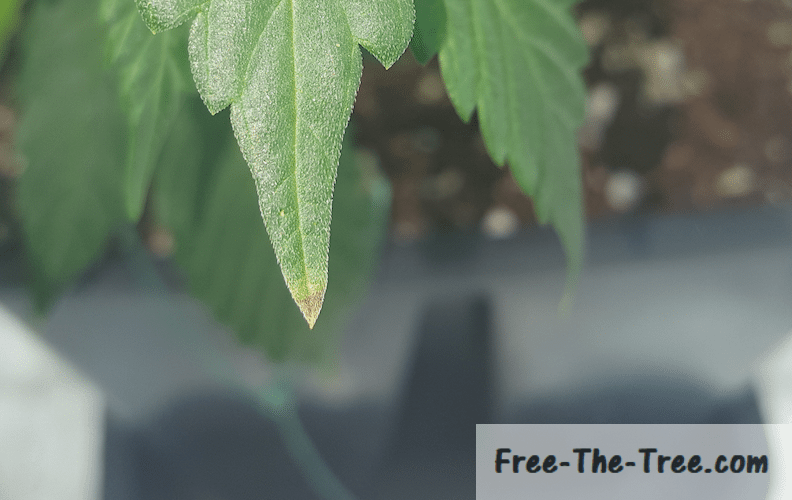
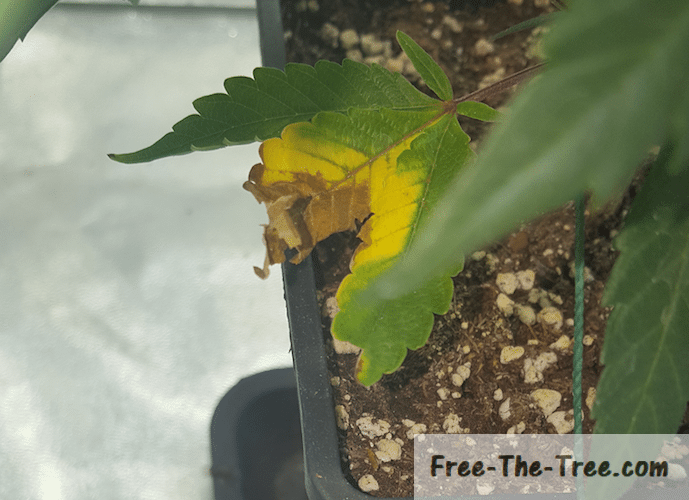
In this section we’re going to cover:
- How to spot Nitrogen deficiencies
- What is Nitrogen deficiency
- How to fix Nitrogen deficiencies
- How to spot Nutrient burn
- How to fix Nutrient burn
- What is Nutrient burn
How to spot Nitrogen Deficiencies?
- Are the bottom leafs dying first?
- Are the leafs turning yellow then brown before dying?
- Is it starting from the tips of the leafs, center first?
If you’ve said yes to all 3, it’s most likely it!
So why does this happen?
Basically you’re plan needs nitrogen to make new leafs and branches. If she doesn’t have enough in her environment then she’s going to take in her stock, the leafs.
Since the bottom leafs have less chances to get direct sun light, they’re the first one’s to go (makes sens).
Now during the Vegetative Stage this is definitely something you want to avoir, you need her keeping as many leafs as possible! During the mid/late flowering stage it’s actually normal and something you want.
Wondering what all the stages of marijuana’s life are? Check out our article about it
How to fix Nitrogen Deficiencies?
- Get Vegetative stage growing mix
- At you’re next watering add a little more than the minimal brought forward on the label to your water.
- Check the pH of the water. As long as your pH is over 5.5 nitrogen will be absorbed, but remember that the sweat zone is between 6 and 7.
- During the next days keep an eye out, if the spreading has stopped you’re good.
Now remember:
- Check the pH after adding the ingredients but before you thoroughly shake the mix, although you should have mixed it with a stick a wood or so.
- The leafs that suffered damage won’t recover. Although you might want to remove them I wouldn’t do so except if they just fall off.
Why you say? They still have some stock in them, so the day your plan has another deficiency she’ll take from this one instead of attacking one of your clean leafs.
Now at the other end of the spectrum, nutrient burn… I’m covering this right after the Nitrogen Deficiency since that’s how it happened, by fixing that issue I had open a whole other one, and what a pandora’s box
How to spot Nutrient Burn?
- Did you recently water your plant with extra nutrients?
- Are the tips of the middle of your leafs starting to become black/brown?
- Does it progress from the middle down through the leaf
- Do you start to see it appear at different area’s of the plant and spreading quickly?
If your saying to yourself, yeah that’s exactly it, chances are you’ve given her too much nutrients, and now they’re killing her.
Do you feel like all is lost? No worries here is how to get out of the situation.


How to fix Nutrient Burn?
In order to fix nutrient burn you’re going to need to flush your soil, that’s the only way. What do I mean by flushing your soil? I mean at least getting 2 times the volume of you’re container in plain, pH’ed water through your soil.
You heard me right and it’s important, you can’t just add a couple of liters in there, or else you’re actually just going to let more nutrients out, causing more harm then good.
So, what do you need to flush your soil?
- A recipient that can hold 3/4 times the volume of your container in water
- 3 times the volume of your container in plain, pH’d water. Get your pH around 6.5
- An area where you can have everything near
Once you’ve got all of this ready get flushing.
How to flush your soil:
- Place your plan within the empty recipient
- Poor 3 times the volume of your container with the pH’d water you’ve prepared
- Get your plants back into the grow room
During the next few days you might see your plant get droopy with signs of over watering but it’s normal. They’ll get better as the medium dries out.
Now that you know how to identify and fix this issue with your Marijuana plant, let’s look into what this is exactly
What is Nutrient Burn?
Just like taking too many vitamins is harmful to us humans, too many nutrients in the soil is harmful for your plant.
The roots, doing their job, will take in all these ingredients and send them up to the “out of the ground” section of the plant where it is used for different tasks, if the plant doesn’t need it she stores it in here leafs. When there’s no more “room” within these leafs, well that’s when the issues arrive. The access ingredients having no where to go from there start killing the leaf.
This is the reason why we see it start from the extremity of the leaf and slowly grow inward.
Well folks that’s all for this one, be safe and grow easy!
Hey there and welcome to this weeks grow report!
The end is near 🙂 This week was pretty cool, we harvested our first Big Buddha Cheese bud, the Blue Kush started to put her purple dress on, and globally the buds are getting preeeetty close to being ready for harvest.
Let’s get into it
Harvesting the first BBC Cola
Since the Big Buddha plants are pretty far back it’s been hard for us to monitor the trichome situation. We’ve cut off little sections of the flowers to look at is closer, but to be honest it’s hard to get a full picture and we can’t do it too often.
As much as we’ve seen the trichomes were milky all around with some amber ones coming in, in order to get our mind set we cut down the bud closest to the Blue Kush. Best case scenario, it’s perfect timing and we go for a full harvest, worst case it’s a little early but our Blue Kush has more room to breath and the Thrips can’t move around as easy. Basically, win win ^^
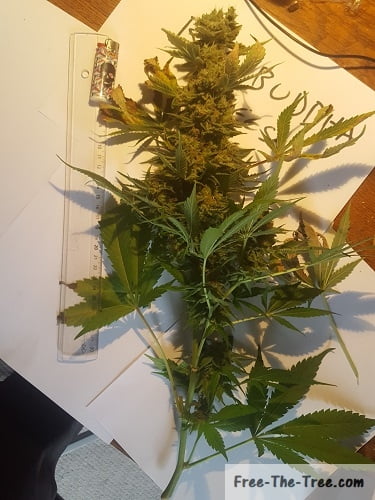
Freshly Harvested Ganja Flower
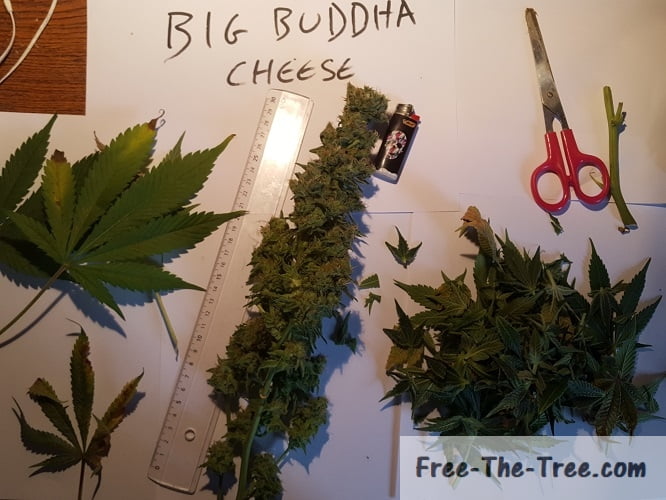
Leaves are pruned off, Bud is ready to go dry

Trichomes on the Buds – Mostly Milky but some are still clear, others going amber.
Nice bud isn’t it? 🙂 But as you can see in the trichomes it’s still a little early to go ahead with a full harvest, a lot of the trichomes are still clear. We’ll go ahead and wait a couple more days before harvesting all the other BBC Cola’s
Thrips all over the harvested bud
Since we have a known problem with Thrips during this grow we decided to go ahead and shake the bud to see if any thrips would fall, and fall they did..
We probably killed 4/5 adults and a bunch of larvae’s crawling around. I really hope they won’t damage the buds while drying.
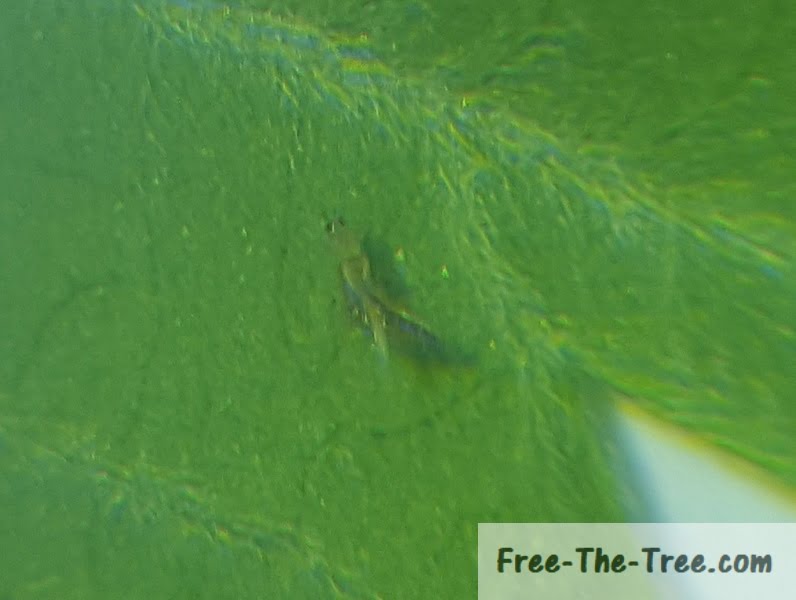
Adult Thrips spreading its wings
Blue Kush’s Foliage turning Purple
During this week the Blue Kush totally transformed, I really didn’t think it would go this fast. At the beginning of the week the first leaves started to show purplish colors and just a couple days later there she was with a (near) total purple foliage, a beauty.
Here’s some pictures of the evolution, as always click on them to get the full view
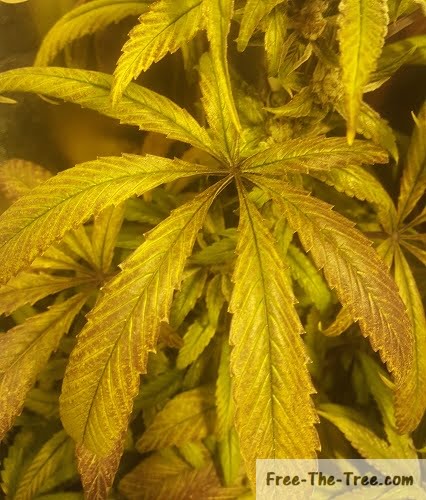
First Purple colors starting to show

Purple color growing on the foliage
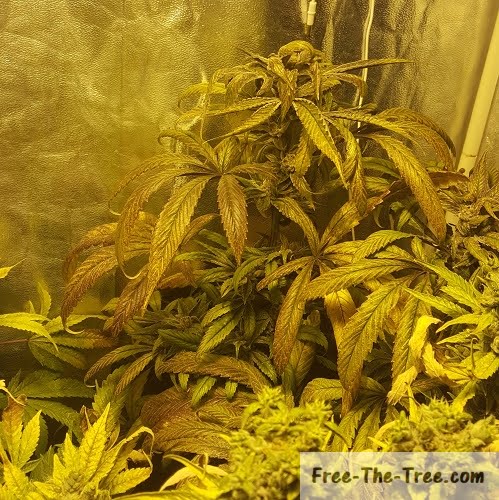
Foliage totally turned purple
Getting the Buds Standing Up
A couple of our buds were falling over due to the weight of their own flowers. The main problem with this is that the leaves aren’t getting the maximum amount of light and she’s leaning over onto her neighbor. We had to get a little crafty in order to get her back and standing by tying a (very) lose knot on the leaf stem.
It’s important not to tie it tight, we need the plant to be able to pass the sugars back down for use ^^
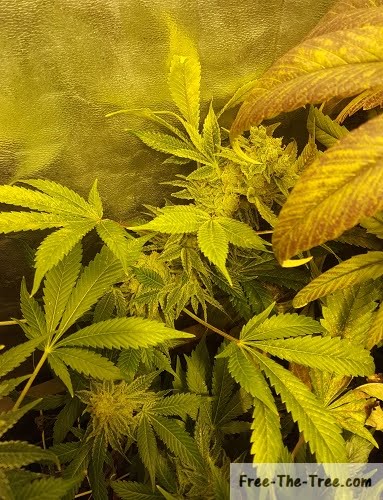
Bud falling over due to the weight of the flower

Loose knot made around leaf stem to keep the bud standing

Bud standing up and not bothering her neighbor anymore
Buds Ripening Up
Be aware, the picture need to be seen with weed available around you haha.
On a more serious note, by the end of the week these buds have gotten unbelievably nice, the smell is overwhelming, we’re constantly wearing a “marijuana perfume” on our clothes, it’s crazy. Can’t wait to taste these babies 😀
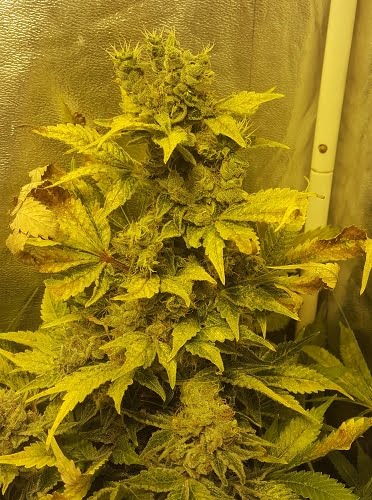
Main BBC Cola – Real fat but the Calcium deficiency makes a weird looking Apex
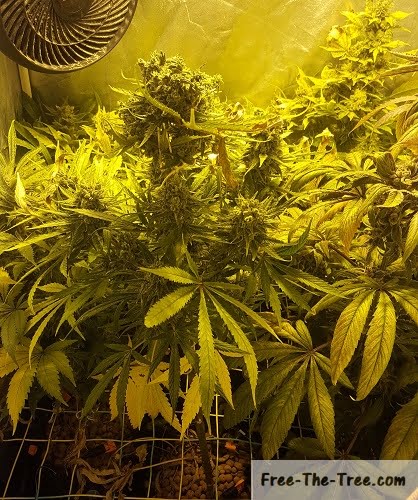
3 Foot Cheese plant with fat buds

In the middle of the colas jungle :p
Aren’t they beauties? I really which I could pass on the smell to you, it’s mind-blowing haha. We’ve had to take strong counter-measures since our neighbors were getting the smell all the way to their houses. I think it’s the cheese’s stanky smell that is to taking and pungent.
Next round of seedling chillin
The 3 Blue Kush and Critical seeds that we germinated last week all survived and are now nice little seedlings 🙂 We’ve got them under a small ~80W light since they don’t need much at this stage, most of the activity is going on under-ground with all that root growth.

Main BBC Cola – Real fat but the Calcium deficiency makes a weird looking Apex

3 Foot Cheese plant with fat buds
Although we still have a little time, I think we germinated these little ones a little too early, we’re close to harvest but, in the best of worlds, these little ones might need to get in there sooner than possible.. We’ll see how it goes.
Alright folks that’s it for this one! Next week we’ll most likely be harvesting most of the buds 🙂
Until then, be safe and grow easy!
Miss a couple episodes? Here’s all our other Grow Reports
Read up on our Indoor Growing Tips!
Hello Community! 🙂
For my first post here I decided to share why, in my opinion, you should grow your own weed at home. I’m really excited of joining u, hope you’ll find this first piece useful
The (Surprising) Reasons Why You Should Grow Your Own Cannabis
In the advent of worldwide legalization, cannabis is becoming more and more available to the everyday consumer. Dispensaries are springing up like mushrooms in legalized states in the US, making a billion dollar industry.
Despite this boom, more and more people are growing at home. The benefits of growing your own are obvious: economical, social, knowing (and choosing) which strains you’re going to smoke, quality control and just because it’s fun!
If you look just at the economical side, with a modest grow room, which averages between 300 and 500 bucks, can get you a grow-op setup that will pay for itself in as quickly as one harvest.
Other benefits, which you may discover as you become a habitual grower, are not so obvious. Here are a few:
Strains, strains, strains
Even with the recent trends in decriminalization/legalization, chances are you live in a city where you have to depend on your local dealer for your weed. If you ask him/her what strain you’re buying, most likely you’ll get an answer that basically means: smoke what I give you and don’t be fussy.
Ask about the THC/CBD/CBN ratio of the baggy you’re buying, and you’ll probably get a blank stare.
However, as a habitual smoker, I know that certain strains are good for certain needs, and the wrong strain can have the opposite effect.
You’ve heard that cannabis is great for insomnia, but a high THC sativa could raise your brain activity to hyperdrive, therefore making you count sheep until dawn.
You want to use cannabis to push your focus and production on a creative project; however the heavy indica your dealer was able to sell you has you unable to get off the couch eating a bag of potato chips while watching nature documentaries.
If you’re lucky enough to live in a city that has legal dispensaries with qualified staff to advise you on the exact type of strain you need, that’s great. But most of us don’t, and so growing your own will allow the choice and the autonomy of getting the right kind of effect or medicine.
You will drink less
I have noticed my need for alcohol has greatly decreased. Whether it’s to unwind at the end of the day, or at social occasions, if you are pleasantly buzzed with a weed high, you’ll find you don’t have to drink at all.
Over the years I’ve helped many friends cut back on alcohol consumption by substituting with cannabis. The “Dry Month of January” doesn’t sound so dreary if you allow yourself to take the edge off with a joint now and then.
And if supply and cost isn’t an issue, who wouldn’t choose an evening socializing with an uplifting weed high and a nonalcoholic cocktail, to a forgetful and clumsy boozy night followed by a hangover the next day?
Bottom line is, if you have a lot of weed, you’ll drink less. Even if you drink a couple of beers, you won’t feel you need more.
You will be richer:
If you are living in most of the developed world, cannabis runs at around an average of 10-15 USD per gram.
The cost benefits are therefore obvious even accounting for personal use alone. But what about the your surplus harvest? You can’t play the local weed Santa for long before you realize the “moochers” -or the people outside of your close group of friends- who don’t merit your continuous generosity. So, what to do with the rest?
Even with my humble 4 sq meters grow space, I cultivated my growing skills to produce much more than my close friends and I needed. You’ll inevitably come to a time when friends of friends of friends start to hit you up.
At 10-15 bucks a gram, and a surplus of a only a couple of ounces, you’re on your way to a little savings pot for that annual vacation or that little luxury gadget you always wanted.
You will be healthier:
I once had the chance to talk to a big time dealer. He didn’t move a kilo at a time, he moved tens of kilos. I asked him if he indulges in his product himself, and his answer was “I wouldn’t touch the stuff”.
The reason, he said, was commercially grown cannabis is almost always sprayed. By this he meant not only are the plants sprayed with pesticides, but he knows that lower-quality harvests are sprayed with Fentanyl (this has been debunked in the media as an urban legend, but there I was, chatting with a drug lord who admitted to the practice).
Fentanyl and carfentanyl are worrisome enough, but what about those pesticides? Even with a seeming harmless and organic-sounding pesticide like neem oil, your health is at risk. There have been links to neem oil and a terrible condition called Cannabis Hyperemesis Syndrome, although doctors are just now beginning to understand it. Because so little is known, it’s very hard to diagnose.
Even if you don’t take into accounts these 2 examples, by growing your own weed you know exactly what you’re giving her and (not) spraying the buds with making the product natural, safer and of a much, much, much better quality.
You will be more popular
When I started growing, I had just moved to a new city in an entirely new country. In fact, that was the reason I started growing: I wasn’t in any social circles where I could casually ask for a connection to a dealer, nor did I feel comfortable to venture my luck in unknown streets unequipped with how things worked and with my bad grasp of the local language.
Once I started growing, I used my discretion to choose who I shared my crop with. It took only a little while after to make friends.
Sharing cannabis is an immediate show of trust, and is great for social occasions. I was invited to more parties, which was both a blessing and a curse. It took a while for me to distinguish the moochers from real friends.
Cannabis, I found, was something “moochers” were drawn to, and I realized that some of my new popularity was due to people taking advantage of my supply of generosity. I learned to be more discriminating about the people I chose to spend time with; going from a phone that never rang to choosing which rings I would answer was a strange, but I realized I was learning to distinguish the people I really got along with from the people who weren’t worth my time. It was social scene luxury.
Oh my god, I wish I had learned to grow cannabis when I was in high school ^^.
You will have a wonderful, rewarding hobby
Agriculture –humans growing stuff – has played a huge role in the development of human civilization.
The immense pride and pleasure we get taking care of our crops is probably embedded in our DNA.
Have you ever been to someone’s house for a meal and your hosts beam with pride over their homegrown tomatoes? That’s how you’ll feel about your homegrown harvest buds.
As you hone your skills in horticulture, you’ll learn the basics of plant biology, perhaps get a little handy with electrical wiring, and maybe even simple DIY construction (like this automated watering system).
It doesn’t stop at the buds; you’ll learn to make edibles with the rest of the plant and perhaps try your hand at cooking and baking. Cannabis cultivation has almost infinite learning opportunities, and you’ll constantly be finding new tricks and tips.
There is also a friendly online community where people are generous with advice and support. And the best thing about it is that first high buzz you’ll get from a new batch… Each harvest is a sweet reward of your hard work and diligence. It really is a hobby that keeps giving.
Of course these are just a few of the many, many reasons one can think of, hope it’ll help you start your own grow!
If you do, or you’re already growing, send us a message and share you experience here with everyone here 🙂
Check out the Communities Grow Reports
Have a problem? Have a look at our Indoor Growing Tips
Hey there and welcome (back) to Free The Tree!
We’ve now arrived at the final post of this grow, it was short but intense! But don’t worry we’ve already got 5 seeds that have germinated and 4 Big Buddha Cheese clones going, next series is going to be even better 🙂
But we’re getting ahead of ourselves, today we’re going to cover the harvest and curing of our 2 Fruit Auto flowering Marijuana plants, the 2 others aren’t ready yet.
As you will see, the 2 we’re about to cut are are super small, but the 2 one buds are looking ok considering, especially one of them. Regardless, as soon as those autoflowering plants started flowering on their own we knew that this would be a small one;
Let’s get into it!
Day 59 – Holding back on harvesting
By now we had been observing the trichomes every day or two for the past 7 days or so, the two plants on the left were entering their 3rd and last cycle of browning pistils and most of the trichomes were milky. Furthermore they had been in a Nitrogen deficiency state for awhile now, so we new those buds were going to be super light, but suuuper tasty.
So really at this point they were ready to be harvested, but so small that we wanted to give them as many more days as possible to fatten..
The two one bud plants (on the right) were no where near ready, many trichomes were still clear, they had little or no signs of Nitrogen deficiency and they hadn’t even entered the 2nd round of browning pistils. We figured we had at least a week left on those two.
Here’s a couple of pics of these babies at this stage, as always you can click on them to see the full screen version.
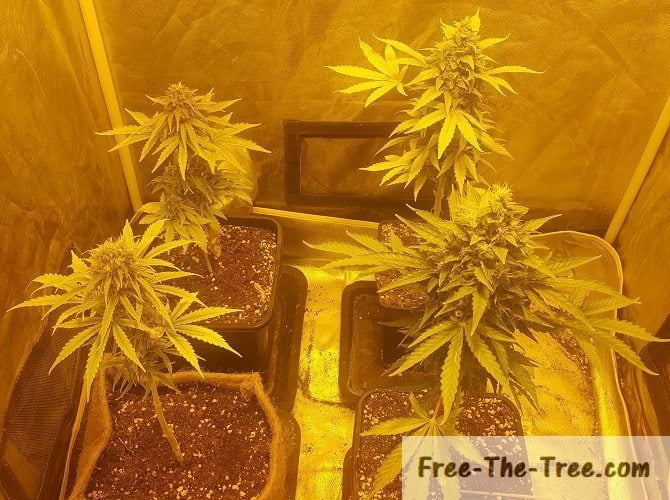
4 Fruit Strain plants at the end of the flowering stage

One of the 2 One Buds
Now to show you with more detail what we meant when we said that the one buds still had white pistils and the other 2 plants were entering the 3rd phase of browning pistils here’s 2 close-ups on one of each
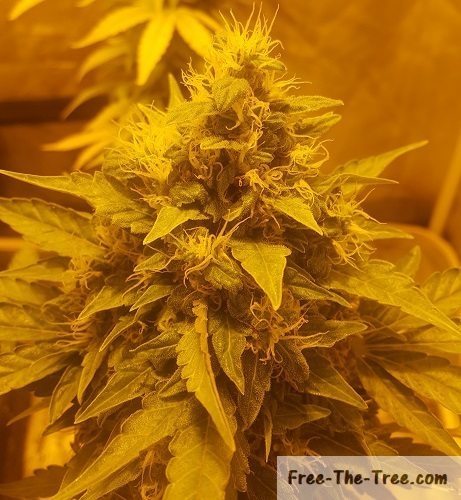
Mostly white pistils on the buds

Marijuana Pistils have started to become brown
Day 61 – Harvesting and curing the 2 first plants
By this time we started seeing some trichomes starting to turn and golden/brownish color, which is a sign that the THC levels are reducing and the CBD is rising. Depending on the type of plant and what you want as a high you might want to wait more, but since this is a Hybrid we don’t want her indica side to come out too much, it’s chop chop time.
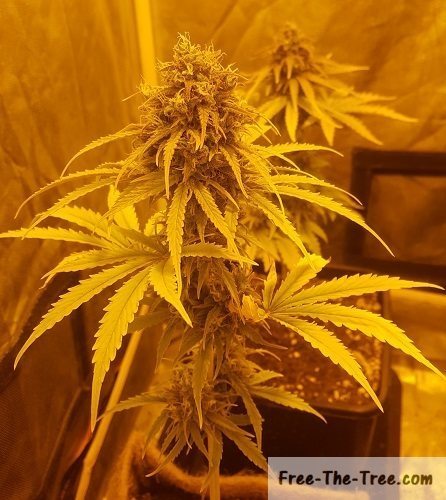
Fruit ready to be harvested
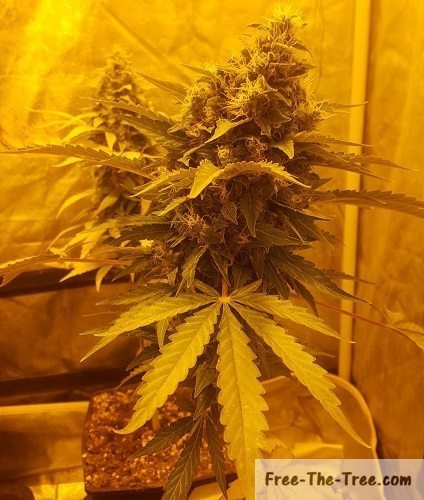
One Bud leaning under bud weight
As you can see once out of the grow room her colors finally show on camera 🙂 Her strong nitrogen deficiency is a sign that her taste should be great, and those purple hints on the top of the buds just make her sexy haha.
We also placed a little picture of our one bud in the middle. As you can see her root system and stem aren’t strong enough to hold the weight of the bud. We had to strap her up a little in order to help her stand up straight.
Getting back to the harvest, now that the plants are cut we need to get to curing them, we covered that with more detail in our previous article so we won’t go in detail on how to do so, but here are some picture (don’t expect the fattest buds..)
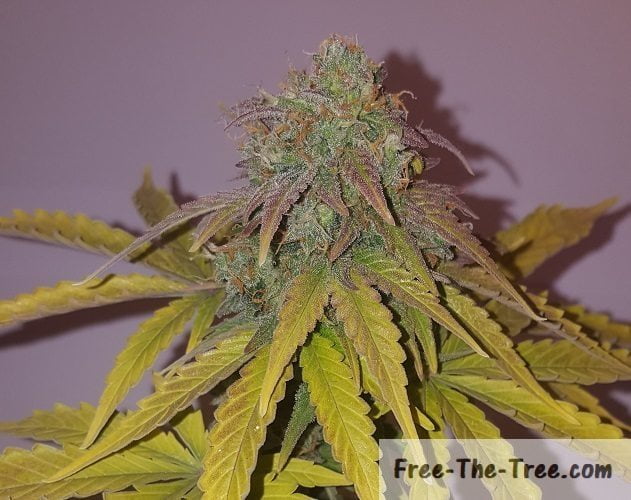
Purple bud
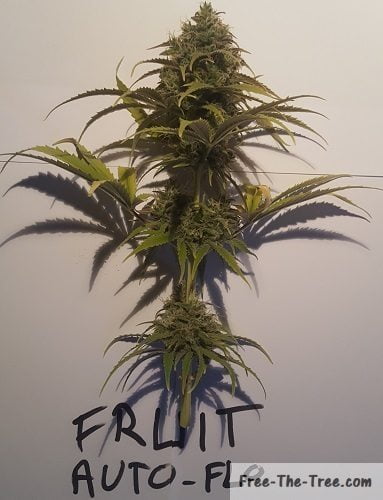
Fruit plant before curing
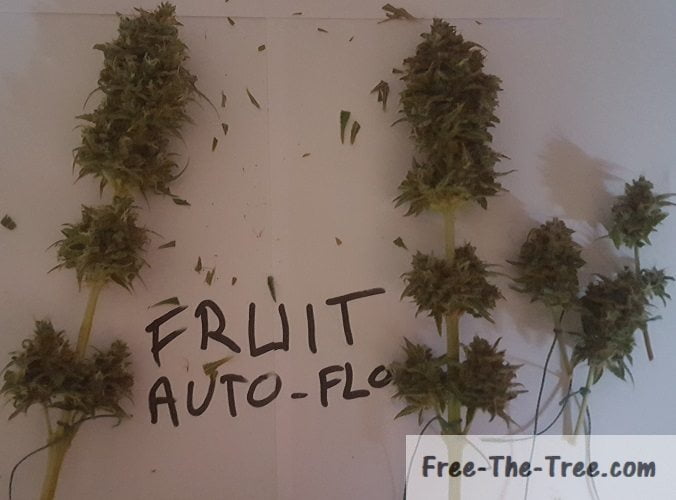
2 Fruit plants after curing
Crazy how much size they lose before and after curing them no?! Now it’s time to get them to dry for about 10 days.
[su_quote]Reminder: As we said in our previous article, don’t throw out your stems and leaves, you can reuse them for many things, from Hash with the leaves to Tea with the branches; (how to make hash over here) [/su_quote]
Day 63 – Nitrogen Deficiency kicking in
In just 2 days the Nitrogen deficiency had started to advance, the bottom leaves started drying and were almost ready to fall off and the symptoms started spreading further up the plant.
Here’s a couple pictures of the 2 last plants of this cycle
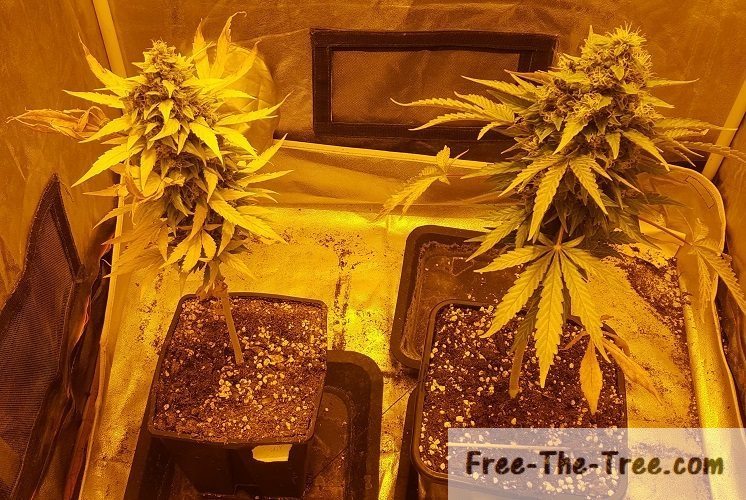
Nitrogen deficiency spreading upward
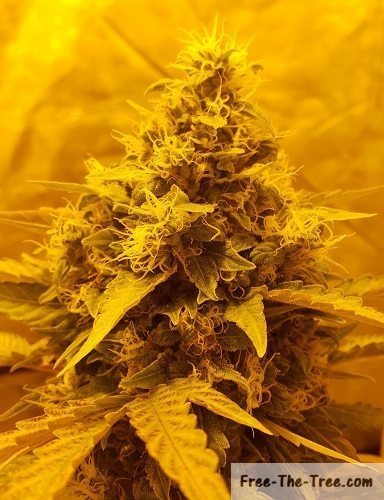
Close up on bud on the right
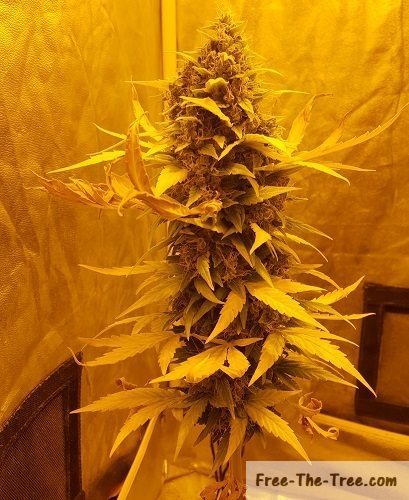
2nd plant about a week short of harvest
Day 68 – Harvest and Curing the last plants
By now the nitrogen deficiency had advanced well, the pistils had started to brown for their 3rd time and the trichomes were all nice and milky, time harvest these last babies! Here’s what they looked like
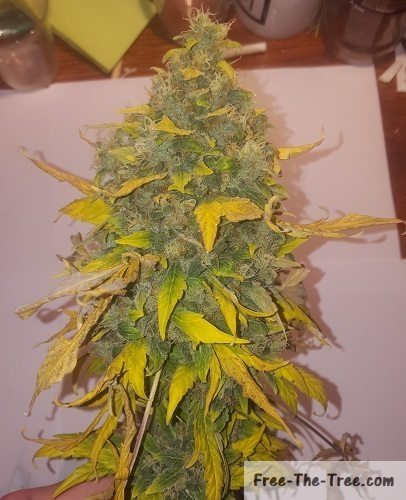
Plant 1

Plant 2
As always, after this we got to get curing, here’s a couple more picture
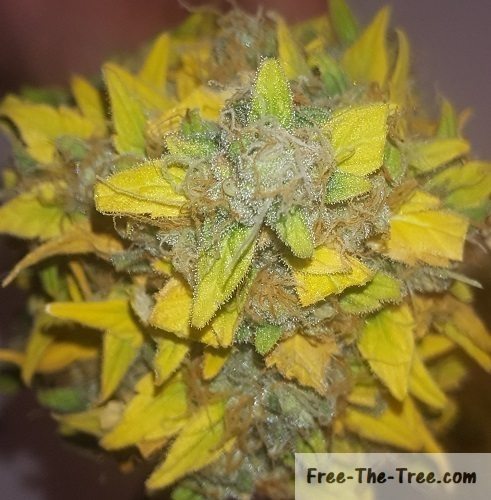
2nd plant about a week short of harvest

Close up on bud on the right

Plant 1 and 2 after curing
Now that we’ve cured them we got to get them drying. As we’ve said in the previous post, we just tie them upside down either in the grow room or in a cupboard. Since we’ve already started germinating new seeds this time they’re going in the cupboard!
Here’s what the 4 plants look like in there, you’ll be able to see right away the different in size and in color. The color difference is due to the fact that the 2 smaller plants are now in their 8th day of drying. Actually a little of the size difference is also linked to this, since while drying they loose in mass.
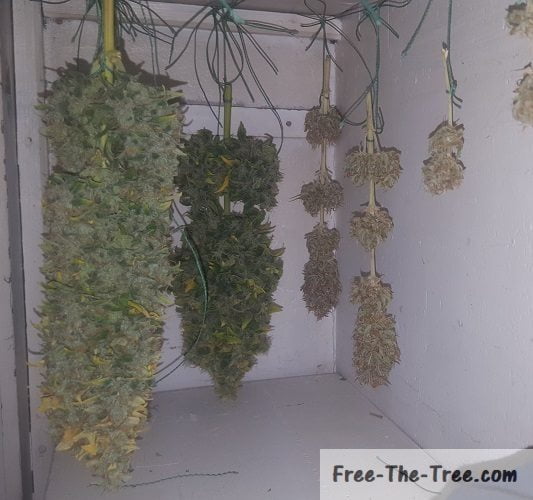
Fruit Plants drying in cupboard

Scissor full of resin and pistils
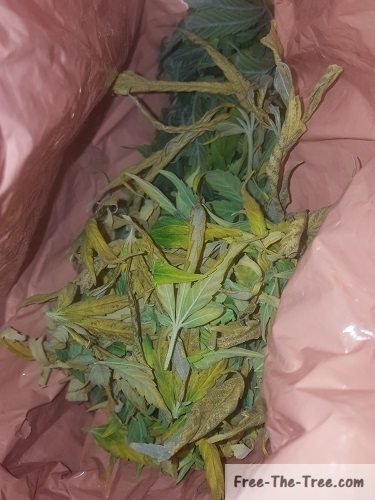
Leaves ready to go into the freezer for later use (home made hash soon!)
Well that’s it for this one guys, next time we’ll cover the germination of the Blue Thai, Blue Kush and the Cheese seeds, can’t wait 🙂
Until then, be safe and grow easy!
Don’t want to leave just yet? Check out our other grow reports and indoor growing tips!
Grow Reports
Indoor Growing Tips
Hey there and welcome (back) to our growing guide! This has been a turbulent session with these auto-flowering plants, it was our first time with these types, full of learnings! We’ve actually grouped it all together in an in-depth article if you want to know more.
During these couple days so many things happened, we started noticing some weird white marks on a couple leaves of our plants, had to prune some branches and pop-corn buds off and started seeing some nice bud growth getting started.
Before getting into it here’s some pics of the plant during these days, don’t hesitate to clic on them so see the full picture.
Day 36
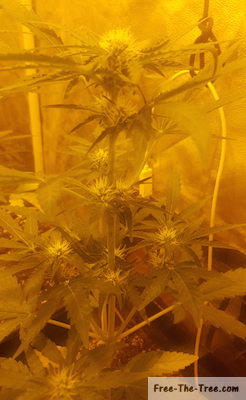
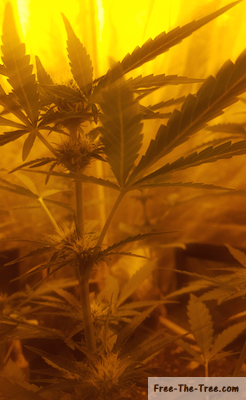
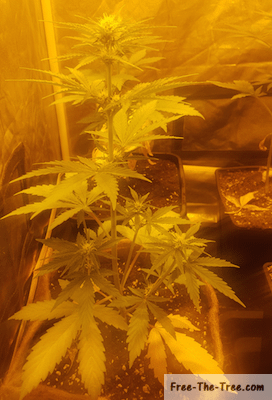
Day 37
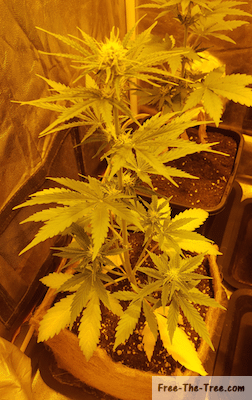
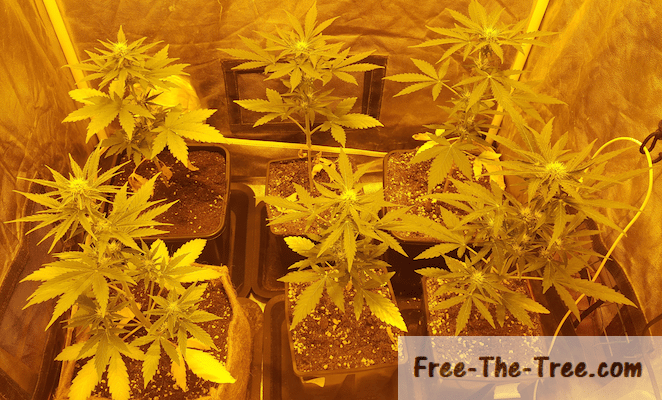
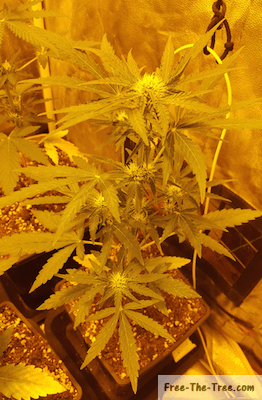
Day 38
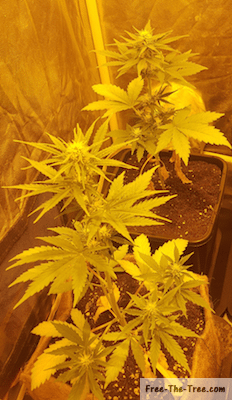
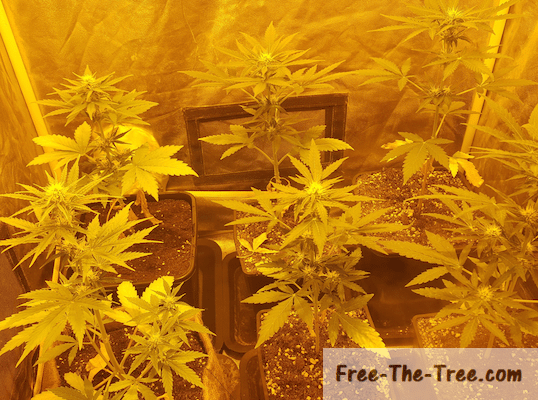
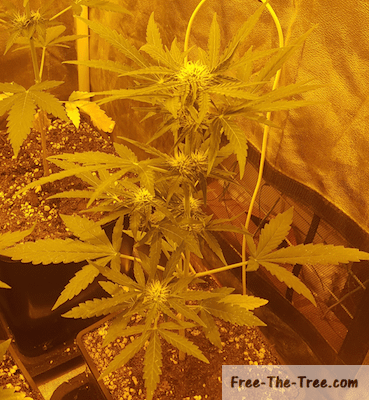
Day 39
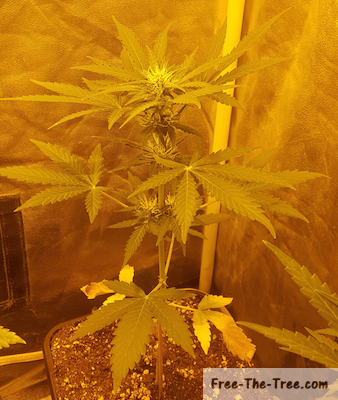
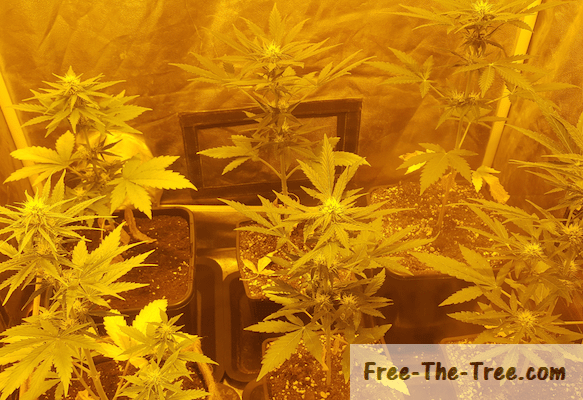
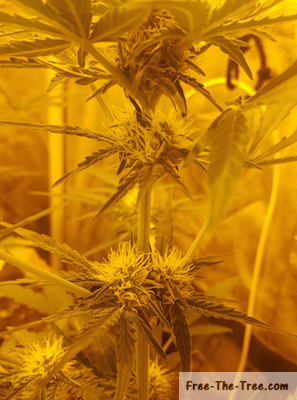
Day 36 – White marks on leaves and pinching the stem
On day 36 two things really went down.
The first concerns pinching the stem of the plant where we are growing multiple side branches (bottom right one). The objective of this is to reduce the amount of nutrients going to the Apex and redirect it to the side flowers.
It should also create a knot on the stem allowing the plant to store more nutrients. This is something that should be done during the flowering stage, but as we said in one of our previous posts these babies started their flowering stage a little early.
The second is that we started noticing some white marks on a couple leaves of one of our Critical+ 2.0 flowers. At that time we though it was some kind of deficiency, just couldn’t believe we had spider mites. We decided to see how would evolved over the next couple days before acting (worst thing to do ever!!); We should of just cut of those leaves right away..
If you want to now more on those little suckers and what they can do to your plant, check out our article on Spider Mites (aka the Tetranychidae Family)
Pinching the stem of Marijuana
As we said earlier, pinching the step of your cannabis plant will:
- Reduce the nutrients brought from the roots to the area after the pinching area
- Increase the nutrients brought to the rest of the plant
- Create a knot allowing her to stop more nutrients
- Should balance out the nutrient distribution on all branches or bud area’s
Here’s more on this
How to pinch the stem of Cannabis
- Identify where to pinch. This will depend on your goal.
- Place your index on one side of the stem and your them on the other
- Squeeze the stem until you fell/hear a clicking noise. You will know it when you feel it.
In our case we wanted to increase the amount of nutrients sent from the roots to the side branches, so we decided to pinch the stem just under the first level of buds.
This does not mean that the top of the plant won’t have any food, remember that plants produce their food through photosynthesis, what comes up from the roots are “just” extra nutrients. Furthermore, nutrients will continue to flow, just not as much.
In case you squeeze way too had and you’ve broken the outer layers of the plant place some tape around it until she fixes herself up.
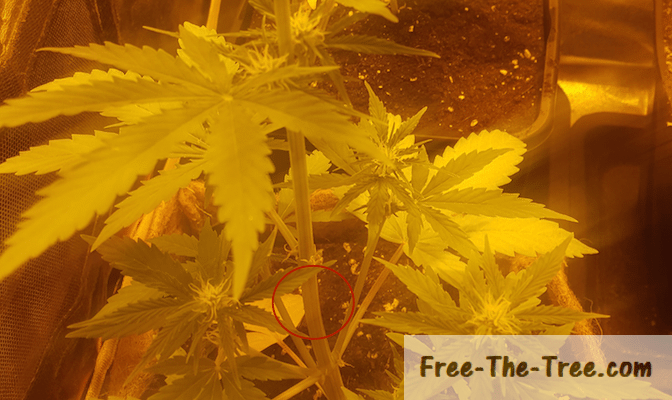
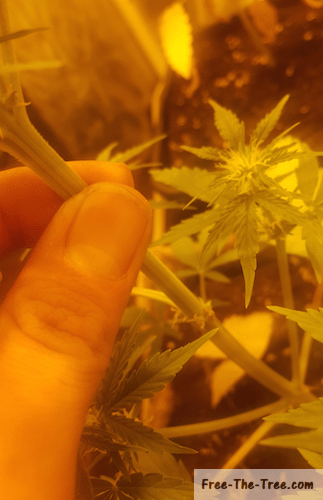
Appearance of White Spots on the leaves
We started noticing that a couple leaves of one of our Critical + 2.0 plant started to have a couple little white marks grouped together on them.
You can see on the images on the right that each leaf has more or less marking on them.. Little did we know but that was the start of our infestation and the leaf with the most marking was the base leaf of it all.
At this point we didn’t really know what it was and thought it was some type of deficiency. As most first people first encountering spider mites.
In that spirit we at the next watering we decided to increase the amount of nutrients given, which didn’t hurt but didn’t help out for the infestation.
To make matters a little worst we also decided to lower humidity levels to about 45% since the flowering stage has begun. As we’ve covered in our guide, spider mites hate humidity and love hot dry weather (which we learned after hand..) so this made matters worst.
Spoiler alert: We were able to survive this but lost a good amount of leaf mass and spend a good amount of energy in management of the infestation. More on that in our next posts 😉

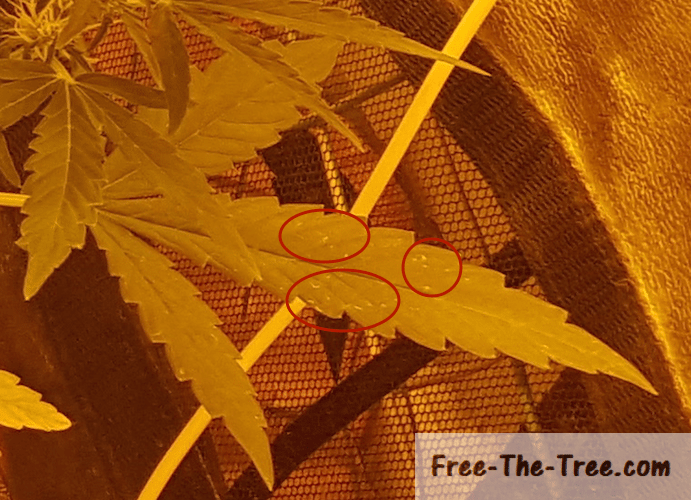
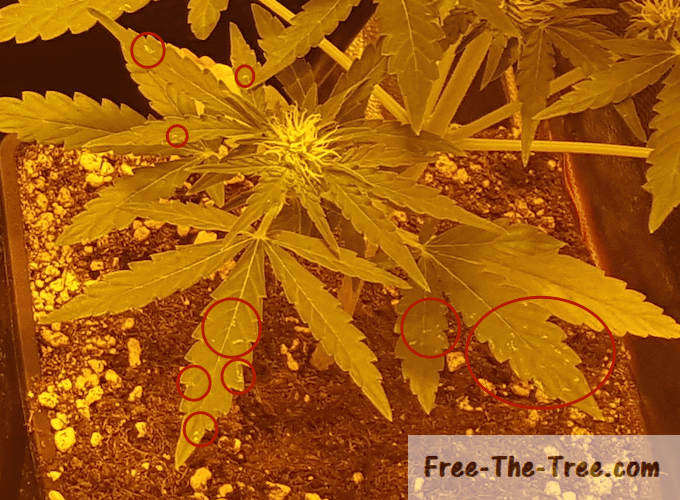
Day 37 – Trimming Pop Corn Buds
Now that our plants have well entered the flowering stage we can identify the bud sites that we want to keep and those that need to go (aka pop corn buds)
This is also the “last” opportunity to cut branches that are not receiving direct light, thus taking energy produced by photosynthesis of other sections of the plant.
What are pop-corn buds?
Basically Pop-corn buds are those small buds growing low of at the middle of your stems.
These area’s will generally produce low quality buds while taking a lot of energy to produce. It is much better to remove these buds in order to keep the energy for the buds higher up on the stem.
The earlier you are able to identify and remove these pop corn buds the more energy your plant will place into your main buds.
You might need to repeat the procedure once or twice if your plant sprouts new bud area’s but this shouldn’t be the case.
What might happen though is that you notice that you’ve missed a couple further down the road, at which point you’ll have to make the call.
Are they going to produce anything worthy or are you getting a blunt or two out of it? In the second case, get her to go.
(if you’re far enough down the line get it drying, it’ll be an early, lower quality taste of your harvest)


How to cut pop corn buds?
- Identify what branches to remove
- Take scissors or a cutter (optional but recommanded)
- Place your fingers or cutter at the base of the flower
- Pinch/Cut off the bud
As you can see this is pretty simple and very similar to removing branches off your marijuana plant. Be careful not to damage the outer layer of the branch or stem.
As you can see in the last picture, by doing this with your fingers the cut isn’t very clean, since a clean cut will heal faster, it’s better to use a blade or scissors in order to trim your marijuana plant.
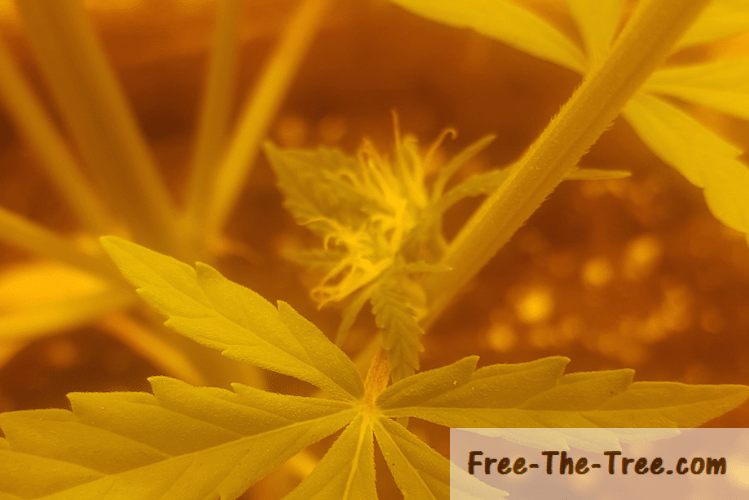
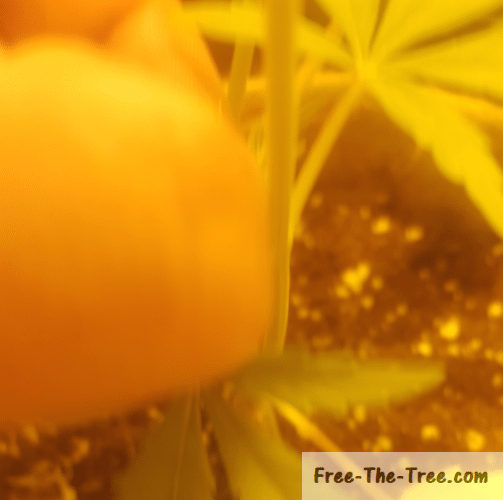

Our trimming session included pop corn buds and a branch of one of our Critical branches.
Why would we cut off a full branch? It was being covered by a large leaf over head so it was either that leaf of the branch, normally it’s pretty straight forward, the leaf has got to go, but in this case we already had pruned too many top leaves so we decided to cut the branch itself.
Here’s some pictures of a plant right before and after a pruning session
Before Pruning Marijuana
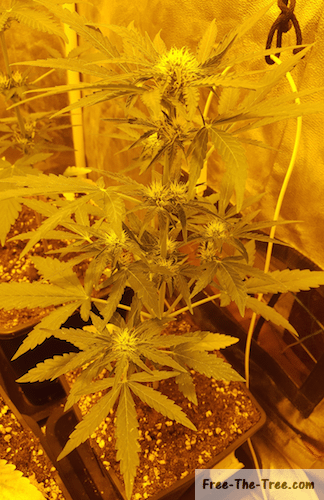
After Pruning Marijuana
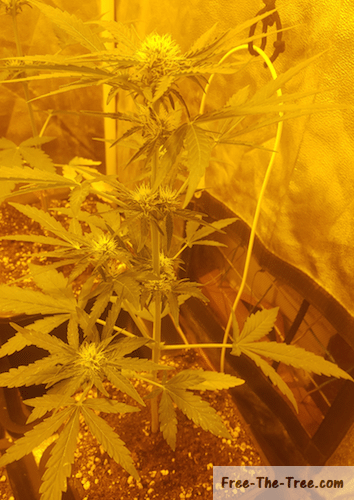
As you can see a large amount of buds are gone and this is good! Instead of having a bunch of small buds the plant will be able to focus on the remaining flowers to make them big and beautiful.
Our pruning was pretty late, as you can see in the images of what we’ve removed the plants had already started producing trichomes, so we lost a good amount of energy.. although in this case I think it’s better late than never
Here’s some of what removed and a focus on what a early marijuana flower looks like. As always click on the image to view it fully
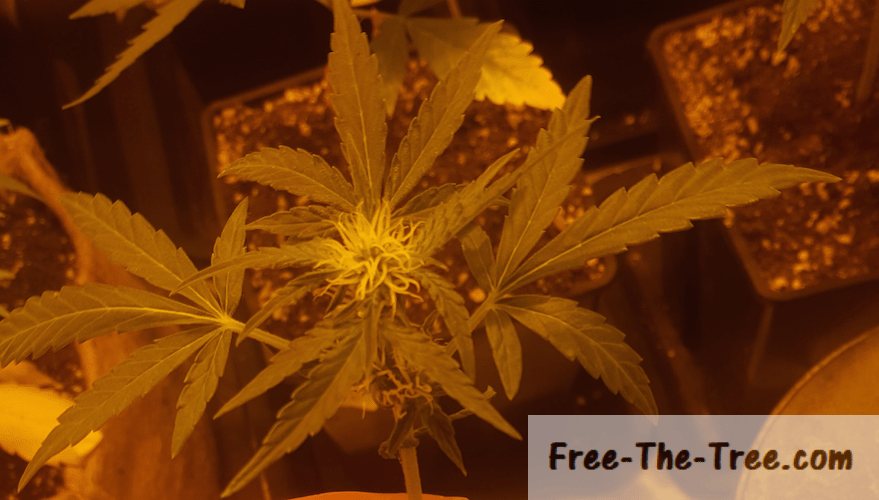
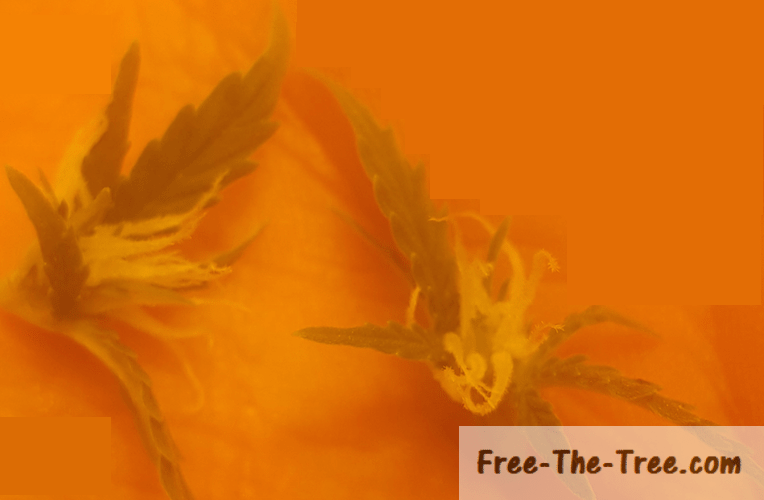
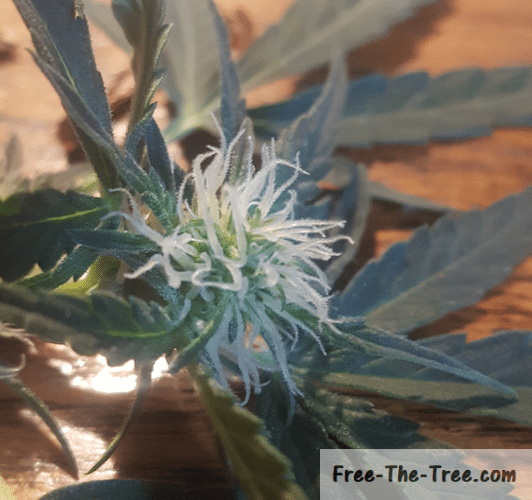
Day 38 and 39 – Calm before the storm
After those 2 pretty active days, day 38 and 39 was pretty calm. We watered out plants with some more nutrients in order to see if the white marks was some type of deficiency (so wrong) and let the plants recover from the recent pruning.
Little did we know that while we though our plants were recovering from an attack they were also being infested by some nasty bugs… But that’s for the next post of our indoor grow journal.
Until then, be safe and grow easy!
Want to share your indoor grow reports?
Send us your email and we’ll get back to you. After that you can start sharing your own experience and help others!
Hey guys and welcome (back) to Free The Tree!
This week is pretty weird. On one hand we’ve got 2 plants that are growing real quickly (the 2 BBC’s) and 2 plants growing reeeal slow (cheese and Blue Thai). We’re already trying to figure out how we’re going to deal with the different sizes in time in order to avoid issues during the flowering.
That said, in this post well go over the plant training that we did in order to prepare for the SCROG, as well as the reasons why these two little one’s have been growing slowly.
Let’s get into it!
Training Marijuana Plants for ScrOG
Setting up your ScrOG is something you need to prepare for pretty early on in the life of your little one. I’m not saying that you can’t decide later on, but the best moment to start training your plant is at the 3rd stage of leaves.
Little pointer before we get into it, we won’t have the last step on the training since it takes a little more than a week to grow. The last step will be in our next post 😉
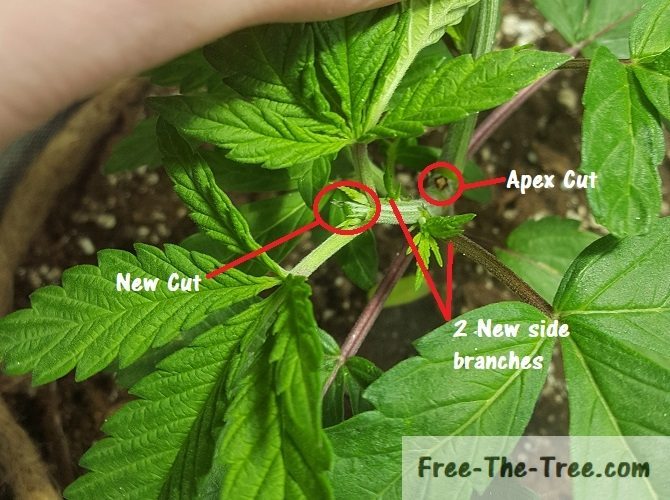
Training Weed for a Scrog Easily
So we’re going to go through each step in order to train your Marijuana for a scrog.
As a reminder, these are the steps before setting up your screen. If you want to go to the screen set-up check out our ScrOG guide.
The first picture will show the plant just before we started to train her, after which we’ll get into each step.
Plant 1 – Young Blue Kush Weed Plant

You want to wait until the 3rd stage of leaves before doing anything. In the picture above we must wait a little before starting to train this one.
Step 1 – Pruning the Apex
Once your plant has grown her 3rd stage you’re going to want to cut (prune) the top section of the plant with a pair of clean scissors or a blade.
As we show in the picture below, you’ll want to do this just above the knot, be careful not to damage the side branches that are forming!
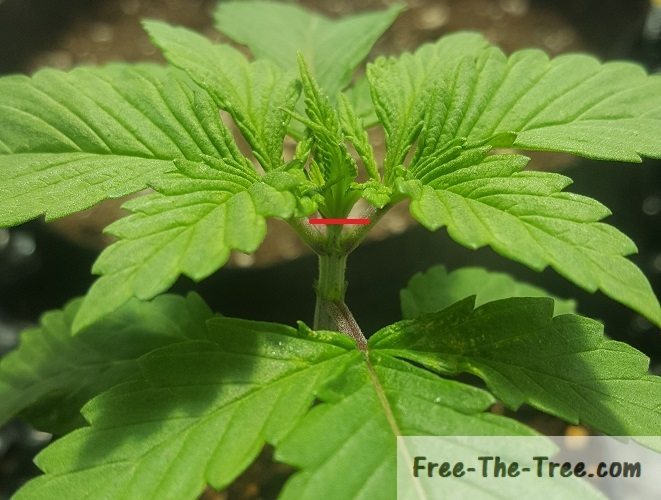
In the next step you will be able to see what it the plant will look like without the Apex. If you’re worried about the fact that the Apex is supposed to be her strongest and best bud, don’t worry, you’ll get that bud x10 😉
Step 2 – Let the 2 new Branches Grow
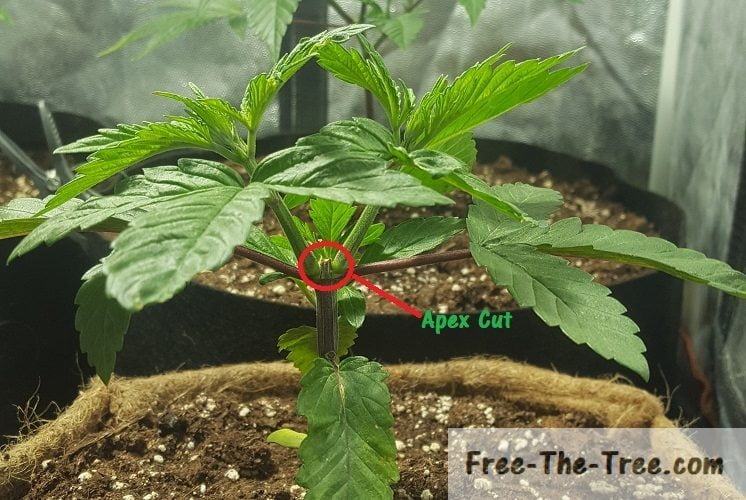
After cutting the Apex you’re going to want to wait until each side branch has developed a new stage of leaves.
Step 3 – Prune Tip of the 2 new branches

Now as you can see we waited a little too long to cut the tip of the side branches. Generally you’d want to cut it before the growth of the next stage in order to avoid any waste of energy. With that in mind, we’re still going to keep the 1st stage branches, in time we’ll prune the 2nd stage growths and that top leaf that’s shading the branch.
Step 4 – Let the new sets of branches grow

Once you reached this stage you’re going to wait a little until those 4 branches have grown enough to start training them. As you can see above, at this point in time they’re way to small to start doing so. We need to wait a couple days, so the second half of this section will be on the next post 😉
Slow Growth during the early Vegetative Stage
As we started saying in the beginning of the article, 2 out of the 3 plants originating from the germinated seeds have been growing really slowly, especially compared to the third.
After reading left and right, this is due to the fact that we planted them straight into the final pot, whereas the other plant was in a small pot before being transplanted into the final one.
We didn’t know this at first, but a weed plant in that it in a pot that’s too big for it will grow much slower since it’s focusing on root development. This means that the root system will be well developed, but there’s definitely some time lost.
Here’s a couple picture of the growth during this week.
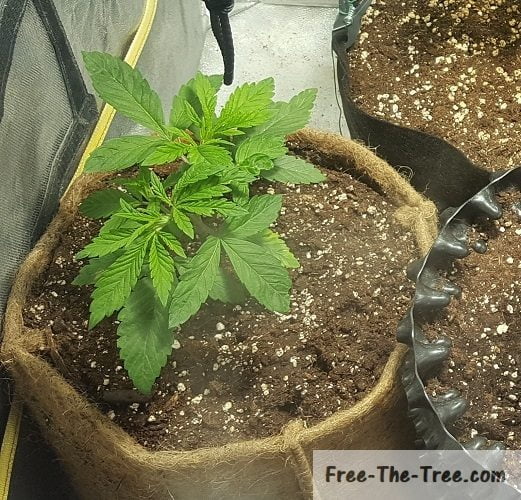
Normal Growth – Blue Kush planted in small pot than transplanted to larger pots.
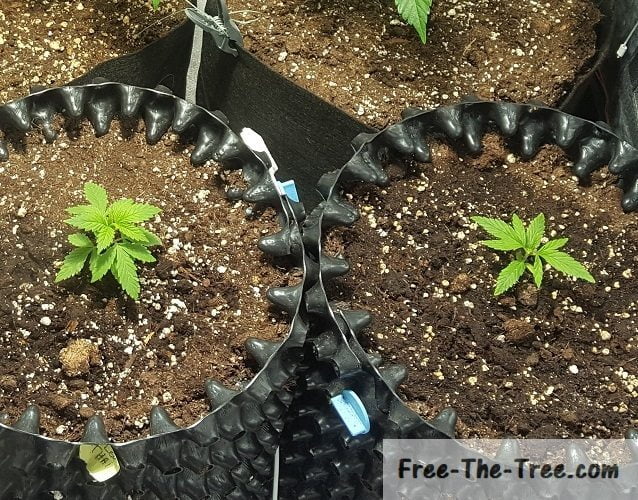
Slow Growth – Blue Thai and Cheese planted straight into the large pots.
Just with these 2 pictures you can easily see the huge difference. Keep in mind that these seeds germinated at about the same time! (couple days delay for the Cheese plant on the far right).
Crazy how big of a difference in growth there is no? Thankfully this week the 2 slower plants started getting there growing on, but they’ll never catch up the other plants.
As we said earlier, the reason for this is the fact that a marijuana plant that’s planted in a large pot will grow slower during the early vegetative stage.
On the upside, these plants won’t have any transplanting stress and once the root system is well developed they’ll get growing strongly.

Blue Thai – Apex just pruned for ScrOG preperation
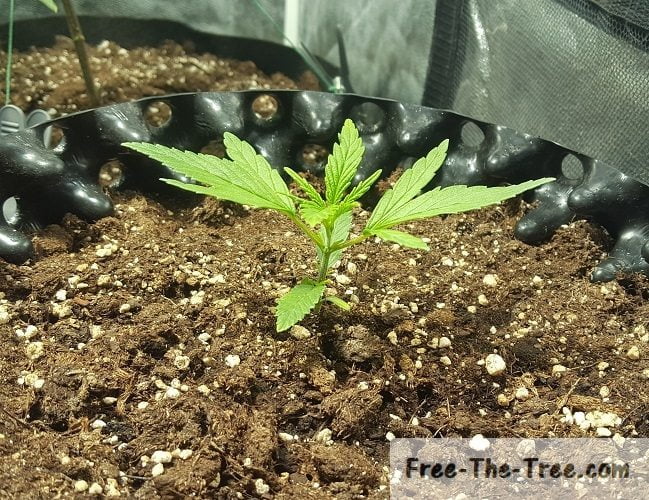
Cheese plant event smaller – 2nd stage of leaf growing
As you can see in the two images above, by the end of the second week they had grown “a lot”. The Blue Thai had grown the 3rd level of leaves so we decided to cut the Apex on this one.
On her side, the Cheese is still hanging back. We decided to cut all new side branches in order for her to focus on vertical growth.
I’m not too sure what we’re going to do with her, if she catches up we might do a small scrog, or else we’ll just keep a couple side branches and work her more when we get into the re-vegetation cycle (spoiler ^^).
Before we let you go, here’s a couple last pictures of them at the end of week 5, as always click on them to see the full picture.
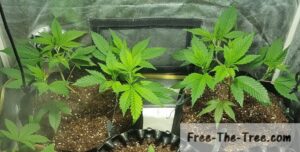
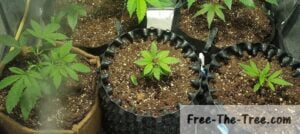
Hopefully these 2 little ones are going to get their grow on.. Next week we plant to make the cutting of the Blue Kush for a friend and place the screen, so they need to hurry up ^^
Alright Folks, that’s it for this one.
Until next time, be safe and grow easy!
Don’t want to go yet? Check out our other Grow Reports
Check out all our Indoor Growing Tips
Hey guys and welcome (back) to Free the Tree! This past week was full of events, this might be a long one.
We validated the fact that we had a Thrips invasion and not a Spider Mite one, thank god! (How to tell the difference? We did a guide here 😉 ) These suckers are much easier to kill than spider mite.
Also, since we’re in the late flowering stage we can’t really use anything on our flowers without taking the risk of spraying anything, even Neem oil could leave a taste and ruin the harvest.. So again, thank god it’s thrips and not Mites.
During this week we also saw some crazy Thrichome and bud growth 🙂 They’re smelling beauuuutifully
Let’s get started
Day 48 – Trichomes all over the place!
Our Critical + 2.0 has been growing more and more Thricomes on her buds, they’re all white and powdery, i’m loving this! here’s a couple pictures (which we had a microscope to show you what they looked like up close)
As always click on the picture to see the full screen version
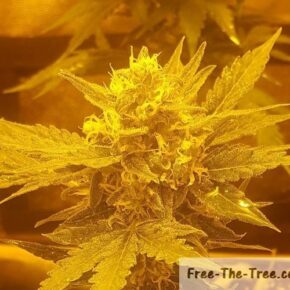
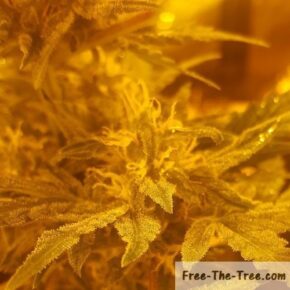

Can you see all those little white specs? Those are the trichomes 🙂
You may be wondering what the fuss is all about, we’ll do a full article very soon on this but basically here’s the deal.
Tricomes are what contain, at a specific moment in the plants development, a molecule called TetraHydroCannabinol, aka THC. Tricomes contain many other molecules such as CBD, produced by the Tricomes once they deteriorate (become gold like color)
At this time under the eye glass we can see that they’re totally clear which means that they’re not quite ready, we want them to be a nice milky color in our situation.
Trichomes are important to track since they’re the best way to know when to cut, so if you don’t have one yet buy a magnifying glass!
Day 49 – Fattening buds, Browning pistils and Nitrogen Deficiency
The flowers have been growing more and more with almost daily evolution, it’s really a pleasure to watch these plants grow, although we’ve been fighting these thrips (we’ll cover that in the next section).
As you can see the 2 plants on the far left are showing mid to late stage Nitrogen deficiencies with all leaves impacted. They seem to be further along the flowering stage than their 2 fruit strain counter-parts. I think this is due to the fact that their soil in much less compact, thus their root systems aren’t as solid.
On top of that we kept side branches to make an A/B test between this style and One Bud technique (What are the Different types of cultures? Here’s a guide).
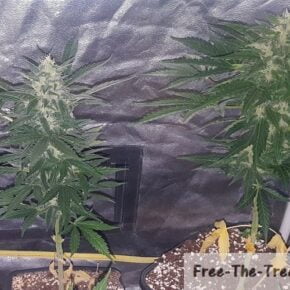
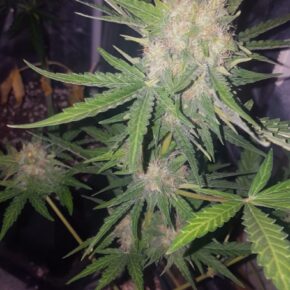
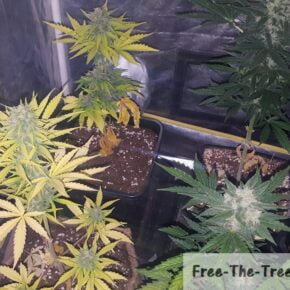
Browning Pistils – Round 1
In the middle picture you can see that the pistils have started browning, and as you may have read this can mean that the plant is ready, keyword being can.
Marijuana flower pistils will turn brown 2 or 3 times during the flowering stage so do not harvest here, you’ll be cutting yourself short of up to 50% of your harvest!
Those different rounds of browning pistils followed by the flower opening back up (white pistils) is her way to grown and increase the size of the flowers, you’ll notice those buds getting bigger and bigger as it goes on, but don’t wait too long! 😉
(If you’re wondering, the best way to identify when to harvest is by observing the trichomes.)
Day 51 – Confirming the presence of Thrips
As you may be aware, we’ve noticed signs of a Thrips or Spider mite invasion, we were leaning for Thrips since the white marks were spread out all over the place but we we’re positive.
In order to be sure we decided, for an hour or so, to drop the humidity levels, take the fans off the plants and raise the heat making the perfect environment for Thrips, hoping they would show their faces.
And sure enough, after leaving it for a little while we could see a couple of those suckers, both on the larva and post-larva stage (no adults though, suspect I killed it couple days ago).
If you want to know more about Thrips and Spider Mites we’ve liked to our articles below.
Here are a couple pics of these suckers, in total we had to have killed about 10 of them across all our plants.
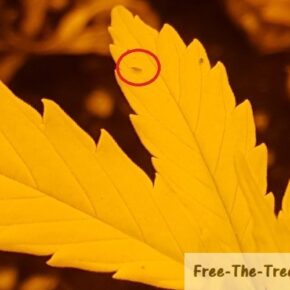

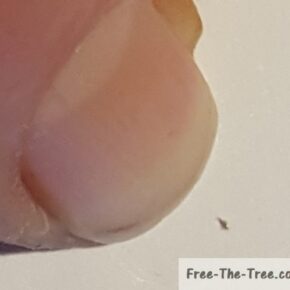
As you may know, Thrips are between 0.5mm and 1.5mm long, so they can be pretty hard to spot but it’s defenitly . In comparison to my index finger nail its super tiny!
If you’re wondering if you spotted one or not, move the leaf around you’ll be able to see if it moves or not. If it does than that sucker is a pest, kill it! (I used my fingers when I spotted some).
As we’ve said in our previous report, since we’re so far along within the flowering stage we can’t use any treatment by fear of leaving a taste in our buds, so we’ve been hunting them by hand and keeping conditions as unfavorable as possible for them.
Thankfully the infestation isn’t that bad and our plants are surviving it fine, showing healthy signs, smelling beautifully so we’re not too worried.
Day 51 – Cutting Side Branches
As we said further up, we tested different styles and one of are buds is really small, so we decided to cut the side branches in order for her to focus on the Apex for the end of her life.
It’s really late in the game to hope for a real impact of this, but we still decided to cut the for satellite branches, hopefully the main bug will get somewhat bigger.
Cutting the side buds
Here’s a couple pictures of how we cut the branches. It’s pretty straight forward, you place you scissors at the intersection of the branch and the main stem and make a clean cut.
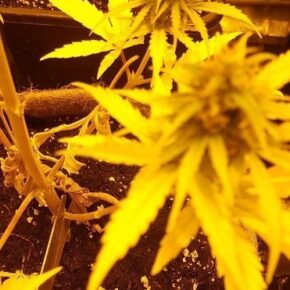
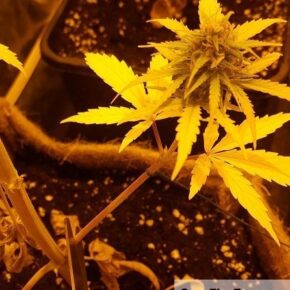
Curing Marijuana Buds
As you can see on the pictures below, these buds are real small, but they still look and smell beautiful, can’t wait to taste this Fruit strain :p
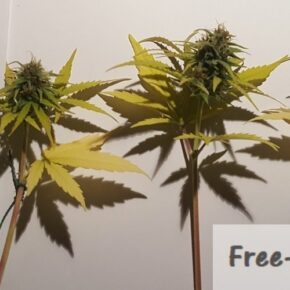

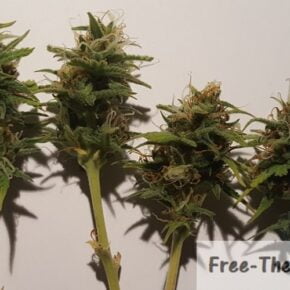
Curing the buds are one of the most important steps, the aim is to cut off all the main leaves and as many of the small leaves as possible.
Since this is personal consumption, and the small leaves near the buds have so many trichomes, we decided to just trim them; but if you’re intending on selling your harvest it’s more aesthetic to just keep the flowers.
Side note, keep your leaves and stems! we’ll do a full post on what can be done with them, from tea to hash you can do a whole lot with everything so don’t toss it out.
Day 53 – Fattening Buds and first signs of readiness
Although our plants are objectively small, which we were prepared for, some of these buds are getting nice and fat 🙂 The beautiful smell is all over the room and their shining with trichomes. It’s going to be a small but tasty harvest!
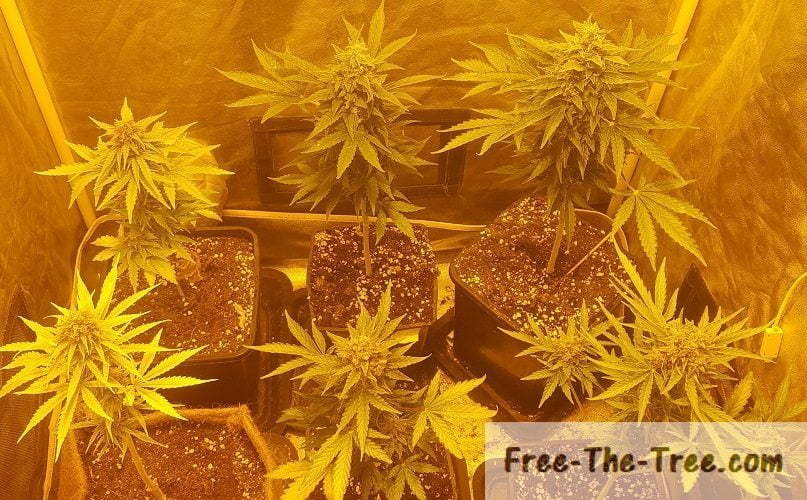

Curing Marijuana Buds
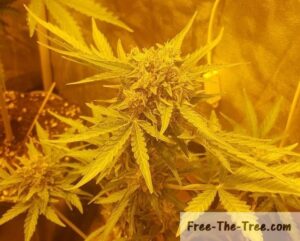
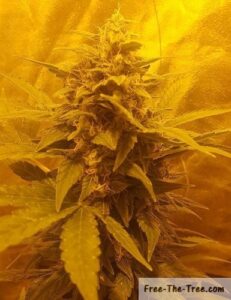

Alright guys that’s all for this one!
Until next time, be safe and grow easy 😉
Don’t wanna wait? Check out all our other Critical+ 2.0 Grow Reports
Check out all out Indoor Growing Tips
Hey everyone, hope everything’s going good. On our end we had a bad surprise after transplanting these babies… They started flowering…
Now, if you’ve been following you see how tall they are right? You’ll agree that we definitely needed more time in the vegetative stage. This got us going with deficiencies and possible light burn, still not sure.
Let’s get into these past couple days. Unfortunately I don’t have any pics for day 26, so we’ll start on day 27.
Here’s what we are going to cover:
- Day 27 – Deficiencies and First signs of the flowering stage
- Day 29 – Watering the Critical + 2.0
- Day 30 – Transplanting the last plants
Day 27 – Deficiencies and First signs of the flowering stage
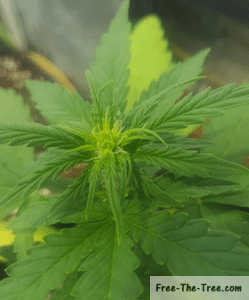


On these pictures you can clearly see a couple issues.. Let’s decrypt them together.
On the one on the left you can start seeing the first pistils of the flower showing up on the Apex. These one’s are much less advanced than the one’s visible on the article’s main image, but nonetheless you can see the starting to sprout up.
Within the middle picture you can see than most of our plants are showing signs of deficiencies. As we started suspecting during the previous days, this is most likely Nitrogen Deficiency.
It would make even more sense due to the fact that they are entering the stretch phase, time at which the plant consumes a large amount of Nitrogen in order to grow.
This means that the next watering definitely needs a good amount of Nitrogen, especially since the cannabis plant stop intaking Nitrogen after the Stretch.
I might actually have to pulverise some on the leafs one of these nights.
On the last image you can see the leafs facing upwards. This is a sign that our lights are too close and need to be brought up.
Light burn can do a lot of harm to your plants, even ruin your harvest! So be careful and make sure you have at least 25cm (10inch.) between the light and the Apex’s of the plants.
If you’re wondering why these plants started to flower without a shift if photoperiods here’s the quick answer, we’ll put a link below to our article if you want to know more.
Since these plants are auto-flowering plants they don’t depend on photoperiods in order to get into the flowering stage, so what do they depend on?
Auto-flowering plants start the flowering stage when the main roots have hit bottom. Meaning that when the main root cannot go deeper, the plant will start going into the stretch phase.
Don’t make the mistake I made and pot your auto-flowering seeds directly into your final pots. That way you’re sure they won’t flower early
Day 29 – Time to Water the Critical+ 2.0

Here we are again to a watering time. Now if you look well you can see that not all the plants are showing signs of thirst. I suspect this is our fault, after the transplantation we must have watered some plants more than others.
The other possibility is root development. If the root system of these plants isn’t as developed as their sisters than they cannot access what they need within the new soil. Meaning that the humidity is there, she just can’t get it.
You can also see that the deficiencies have continued to spread across the leafs, showing that we haven’t fixed the issue yet..
It might be due to the fact that they haven’t taken in the nutrients yet, so we’re going to have to wait it out, or else we might go from nutrient deficiencies to nutrient burn.
Apart from that, it’s really time for our 2 last plants to be transplanted, it’s been almost a week since the 4 others are in their new pots, if we wait too much longer we’re going to have problems with them, and they’re are best one’s out of the bunch so that really would suck
Day 30 – Transplanting the last Critical + 2.0 Marijuana plants
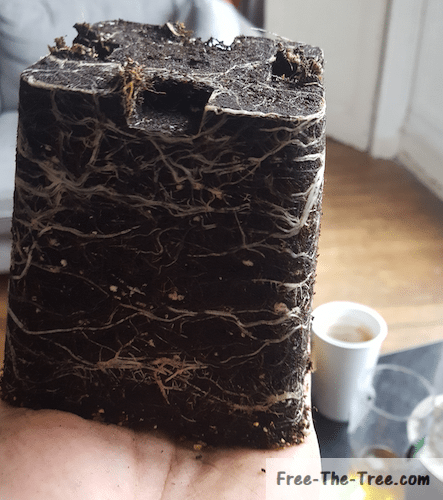
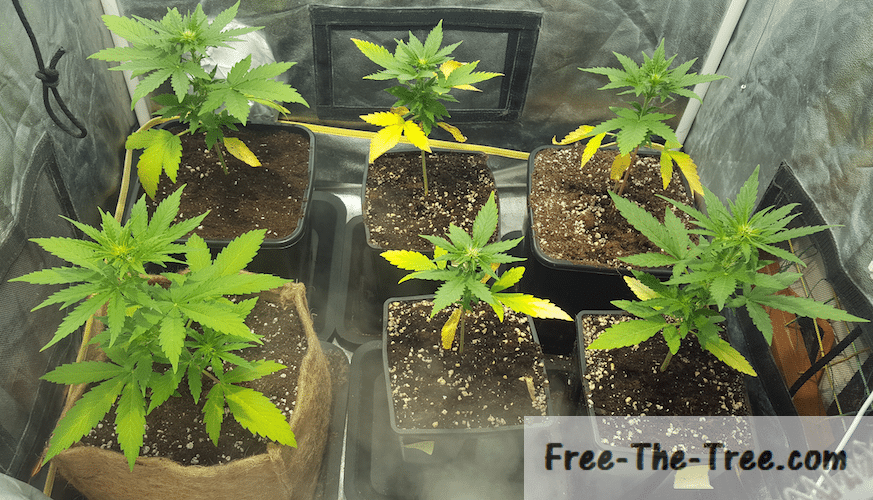
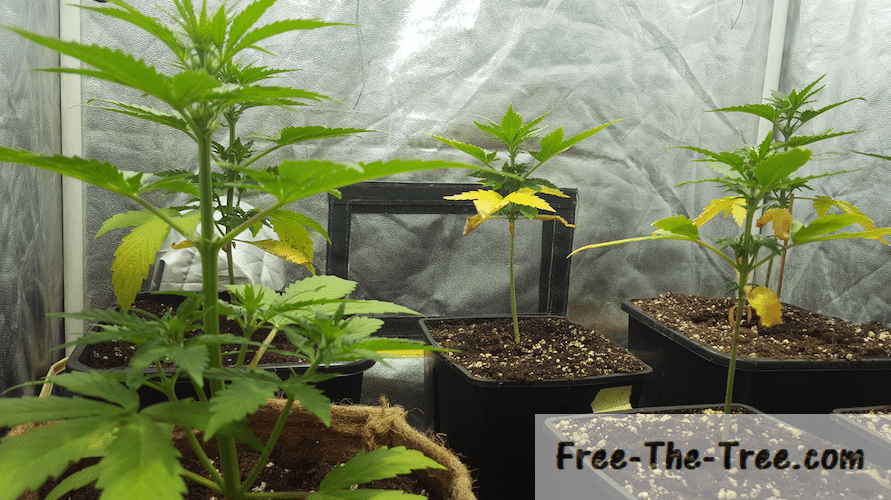
So we finally got these last one’s into their new pots. They weren’t supposed to be their final pots, but since these babies have started to flower I don’t really have a choice here..
You can see on the left picture that they had well invaded the ground. If you look close you can even see some roots starting to exit what used to be the bottom wholes of the pot. This is definitely a sign that I should of transplanted earlier.
In the middle picture you can see that our issues just keep going, have some leafs starting to go white on the tips, other already dead, it’s just not looking good.
On top of adding some more Nitrogen during the last watering, I started to add so P and K (Phosphorous and Potassium) as well as raised the light a bit.
Hopefully that will do it will stop spreading.. the one’s the most hurt are the one’s with the less leaf mass which is a big problem, their going to concentrate of leaf growth during the flowering stage, where we want them to be growing some fat buds.
On the last picture you can clearly see the differences in our late plant vs the earlier one’s. The earlier ones have week stems, their first stage is much higher off the ground and they have much less branches and stages.
It’s crazy how a small difference during the first 2 days of their lives can make such a big difference later on.
Now you might also be wondering what that brown looking thing is. It’s actually an “eco pot”, made out of organic material.
A friend gave it to me and we’re testing it, it’s supposed to be better for the roots since they can grow into the sides of the “pot” instead of being stuck to the sides of the plastic one’s. We’ll see how it goes.
That’s it for this one folks! In the next post we’ll start talking about cutting your branches and leafs in order to keep just what you need
Until then, don’t hesitate to give feedback on this post, or if you’ve had similar situations, we’d love to hear about it.
Be safe and grow easy!
Hey there and welcome (back) !
Much has happened since the last grow report, from dealing with our fungus gnat infestation to germinating a new little strain, we had a lot of fun 🙂 Let’s get right into it
Grow Report n°4 – Table of Content
- Fungus Gnat vs Nematodes
- Phytoseiulus persimilis protecting our babies
- Sex Bud – New strain germinating
- Topping our Laughing Buddha
- Blue Thai showing problems
- Curing the Blue Kush
Nematodes vs Fungus Gnats – Get eeeem!
This week we finally got the Nematodes, these little worms are a natural predator for Fungus Gnats eggs and larvae, perfect to go hunt and kill these suckers and protect our babies root system 🙂
We’ll do a full article on fungus gnats shortly, but basically the nematodes enter the larvae or eggs and develop in there, feeding on the insides of the fungus gnat.
Within a couple days, the effected larvae is dead hehe.
On top of that, nematodes keep the soil healthy, eating through the soil and adding nutrients to it, so it’s also a long term investment.
Nematodes in soil (jammin’ to the black eyed peas)
Phytoseiulus Persimilis protecting our plants
If you’ve followed our previous grows, you’re aware that we’ve had some intense battles against spidermites and thrips.
We’re sure that there’s eggs left, just waiting for the right weather to hatch and start back up this infestation (yeah these suckers can hibernate for months).
With that in mind, we decided to go ahead and get some phytoseiulus persimilis in order to introduce them to near our vulnerable plants.
Hopefully, this year will be one without spidermites!
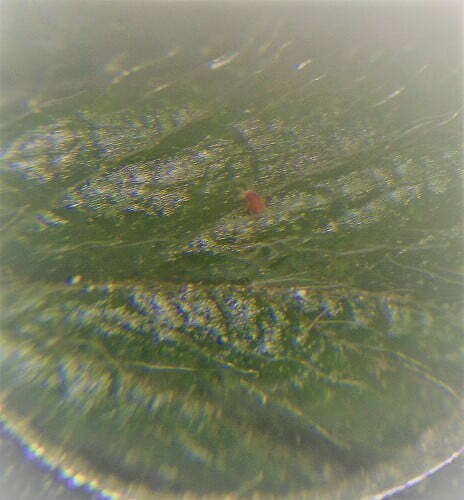
Phytoseiulus persimilis on strawberry leaf
Phytoseiulus persimilis hunting Spidermite – Credit to Kopper Biological Systems
Sex Bud Germinating
Sooooo exited about this, here’s our first full sativa, the SexBud by Female Seeds. Her parents are the C99 and White Grapefruit, giving a fast flowering sativa (8/9 weeks), with a stimulating, creative and energetic social high. Can’t waiiiiit to see her grow.
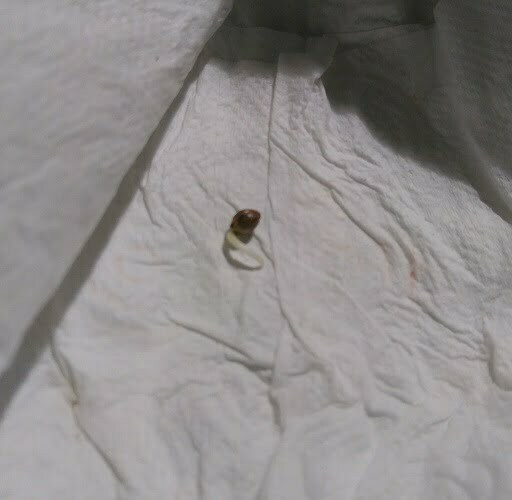
Seed germinating in paper towel
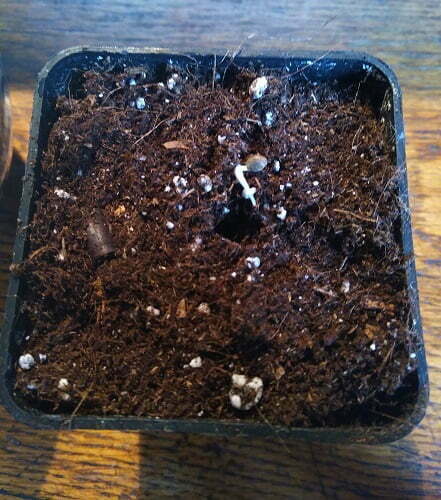
Germinated seed going into the soil
She germinated within 24 hours, although we left her in the paper towel a big longer in order to let the tap root grow a bit.
As we speak the cotyledons have opened up and the first fan leaves are starting to show hehe
Topping the Laughing Buddha
This baby has been growing so nicely, originally we were scared she would get top heavy, but nope, she grew a nice stem and is now growing faast!
Although we’re not sure that we’re going to scrog this round wedecided to top this baby in order to get multiple Apex’s. From there we will make a cutting off one of them for a mother plant, than get this beauty to flower 🙂
Blue Thai showing problems
For the past week the blue thai is showing issues. We though it was linked to the fast that she was still in a small pot, but the leaves are still turning yellow..
We’re hesitating on a nutrient or light burn situation.. To be safe, we flushed the soil and lifted a bit the light.. hopefully the situation will improve
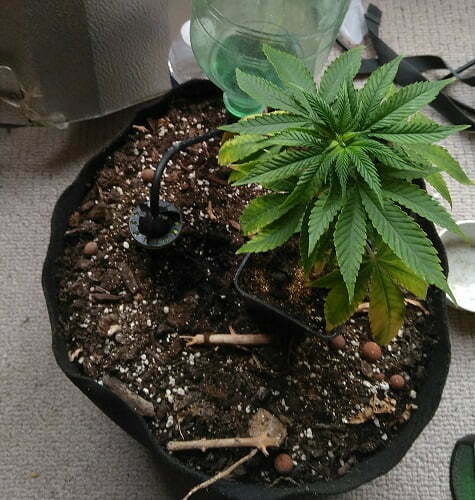
Leaves starting to turn yellow
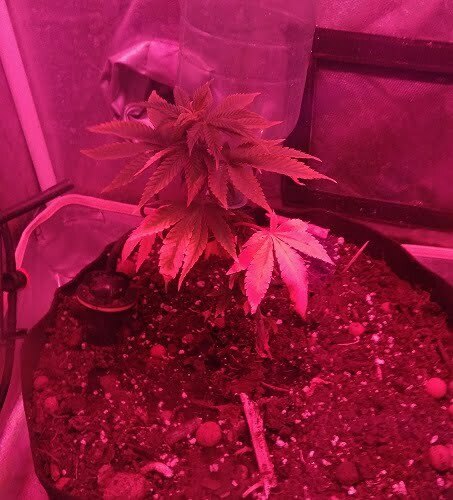
Issue is spreading
Curing the Blue Kush
Sooo we didn’t share this grow on here (too busy on the citizen lobbying tool crowdfunding at that time), but we just couldn’t resist sharing this little beauty

Blue Kush – Ending her flowering stage

Dried flowers curing it a container
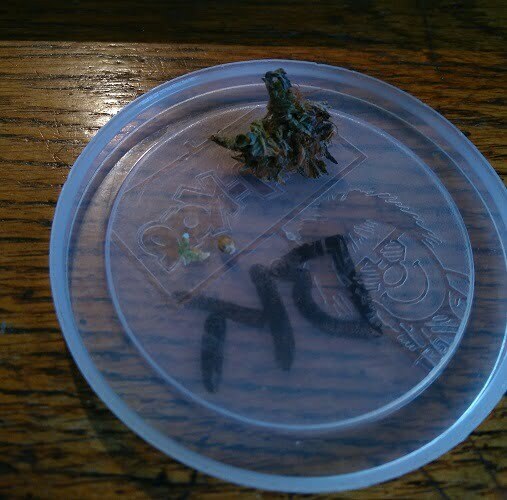
She gave a seeeeeeed!
We harvest her couple weeks ago, she’s now curing and soon ready to be smoke hehehe 🙂
Honestly we didn’t even weigh the final yield, as a g*d d**n spidermite attack impacted strongly her development around the middle of the flowering stage…
That said, isn’t she beautiful?
Alright folk that’s it for this one! Until next week,
Be safe and grow easy!
Hey there, welcome back to another edition of the Big Buddha Cheese series!
On this post we’re going to go over:
Being my first I was really exited at each new stage of this plant, and really just reading all over the place to try and find answers to all my questions.
So let’s get started
The vegetative stage of Big Buddha Cheese
As we say in the previous post we had just gotten out of Nitrogen deficiencies and Nutrient burn, so needless to say we we’re being veeeery careful on nutrient levels.
Basically our mix was of about 5ml of vegetative grow for every 2L of water, given every other watering. She seemed to react pretty good to this so we kept it going.
If you’re looking for tips on watering you’re marijuana plant check out our article right here
She was also growing a large number of new branches and leafs, I made the mistake here to let them all grow, when really I should of cut down the leaf and branch mass.
This is what she looked like at this stage
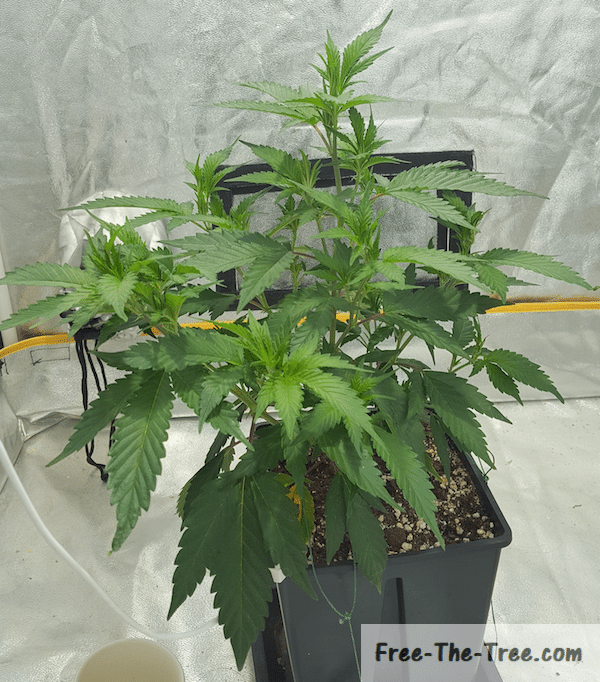
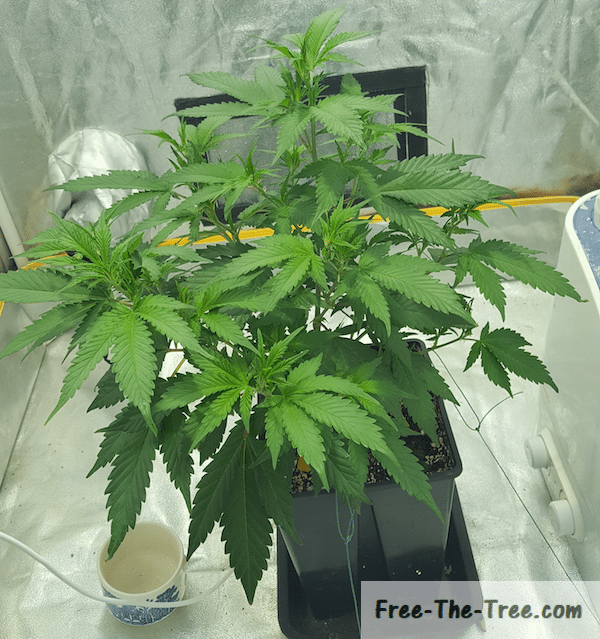
In the left picture she’s 20 days into the vegetative stage, the one on the right is 2 days later.
You can see that we’ve chosen a couple branches and that we’re pulling them with string to the side. The objective for this was to get them growing laterally so that they would get direct access to light.
The second idea behind it is to have multiple branches “invading” the screen during the next steps. This actually worked out pretty well!
Once you have chosen your branches, don’t hesitate to cut unwanted starts once in a while.
I should have also gone for a big trim here, cutting of all branches and leafs that are useless so that she could focus on the growth of the rest.
At this point, we decided that the next day was the day to install the screen (drumroll)
Installing the Screen Of Green
So we did this over 4 days.
On day 1 we installed the screen and starting pulling the branches towards the whole we wanted them to go to. Each day we would lower the screen a little bit, that way we would gain space to start weaving her, without stressing her out too much, I call the “the acclimatation phase”
By day 4 they had reached high enough for us to start weaving the branches on the screen, let the invasion begin!
If you want more info on installing a scrog, check out our tutorial over here
Here’s how it went step by step:
day 1 : Installing the screen
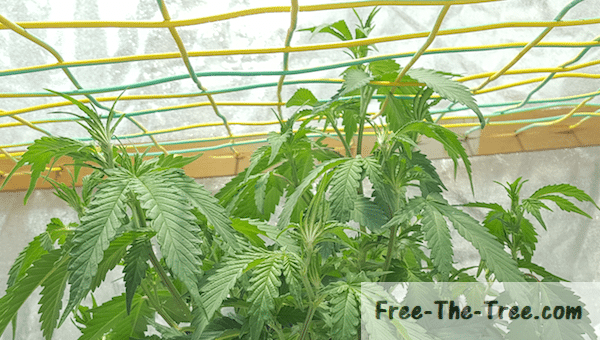
At this point all we did was get the screen in and slide it down at her level.
Now I strongly advise installing the screen high up and slide it down slowly. If it falls you might just brake your plant.
After getting it at the Apex’s level we got some of those top leaves laying on the screen so that they would get as much light as possible, but also so that she started getting used to the screen.
day 2 : Branches going through the screen
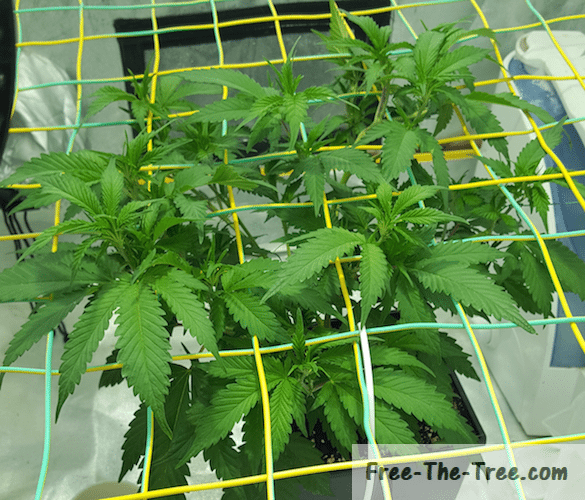
By the end of the second day we we’re pleased to see that the branches had grown and started passing through the screen.
In order to take a little more advantage of the previous growth we also brought down the screen a little, which went pretty well. As you can see we also started bending the Apex over the first screen
day 4 : Weaving the branches onto the screen
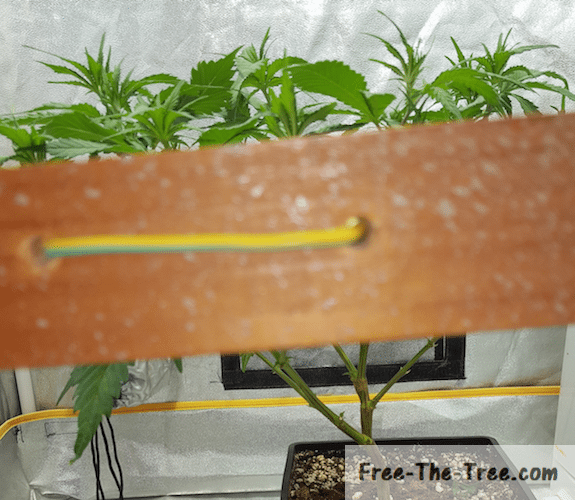
As you can see by the 4th day after installing the screen, the branches had well passed over the level of the net, meaning it’s time for the first session of weaving :).
Here’s how to weave a marijuana plant for a scrog in image:
How to weave your branches for your SCROG
- Identify the direction you want each branch to go in. This planning step is important, you want to make sure that each branch has at least one free space to its left, and one to its right
- Bend the top of the branch over the first line and under the next one.
Don’t hesitate to tie down the branch onto the netting so that it holds.
In the first image on the side here you can see how we tied the apex on both nettings in order to pass her under and over the screen. - Cut any leafs making shade to a spot where a branch could come out. You should also cut the branches that are to close to each other. At each not you should have tops 1 branch growing vertically.
- Take a string, on one end tie it around the top of your branch and the other tie it in the direction where you want you plant to go on the screen. Don’t hesitate to pull well on her she can take it.
You can see on the last image of the set how each branch is weaving over and under the screen, as well as the green string pulling them in the direction we want her to go.
Thanks to this technique, with just one plant you can actually fill up a whole grow room! the only thing is that you’ll keep her in a longer vegetative stage.
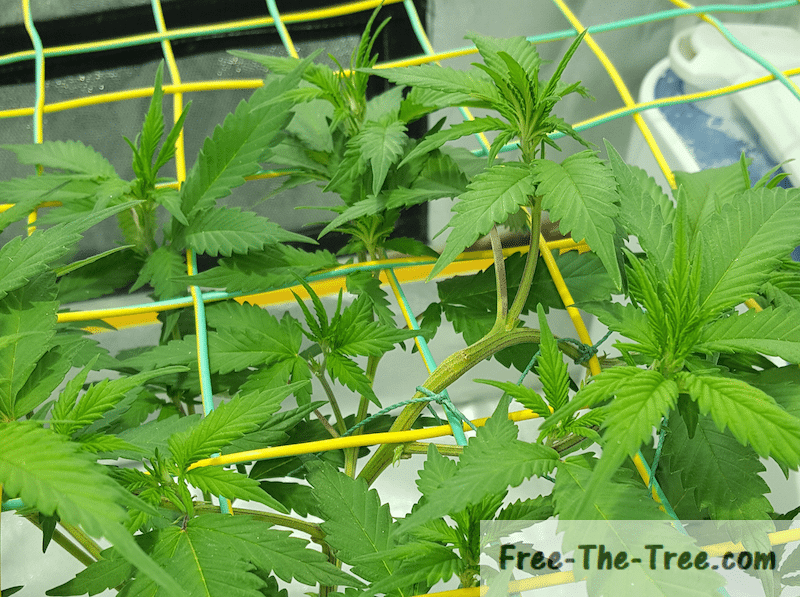
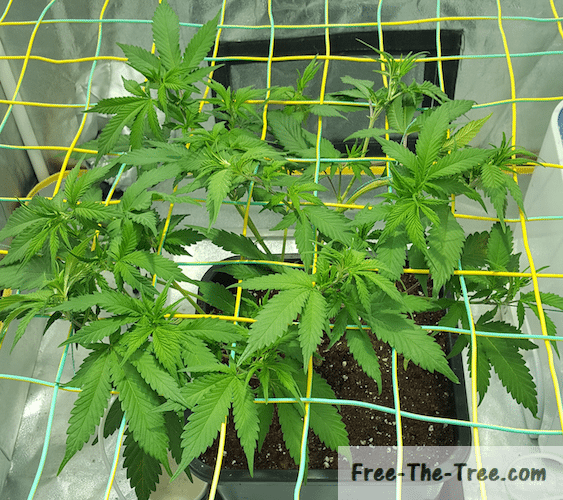

That’s all for this one guys! On the next article we’ll go over her invasion on the screen, it got pretty dense hehe
Until then, be safe and grow easy
Hey there and welcome (back) ! 🙂
Here we are, back at the beginning of a cycle! Can’t wait to share these upcoming weeks with all of you
Couple changes since last grow, so to start off clean here’s a recap of the strains and equipment we’re using
Grow Report 1 – Equipment & strains
- Strains: Critical+ (cuttings) & Laughing Buddha
- Seed Type: Feminized
- Seed Bank: Barney’s Farm
- Nutrients or Additive Used:
– Bio Grow NP and PK mixes
- Grow Lights:
– Vegetation Stage : 75W LED table
– Flowering Stage : 400W LED table - Grower experience: 6th grow
Alright, now that that’s out of the way, let’s get into the first steps of these little one’s lives 🙂
We’ve divided this article in 2 sections starting with the cuttings and end with the seed germinating
Critical+ Cuttings – Rooting process
As some of you are aware we’ve had a critical+ mother plant for a little while, this is our 3rd round of cuttings with her.
Here’s a couple pics of the process but, in full honesty, we slacked off a little and left them in the cups for too long, which made us lose 2 little ones and a bunch of time. If you want to know more on how to make a cutting, check out our how-to article over here 😉
Picking and cutting the branches
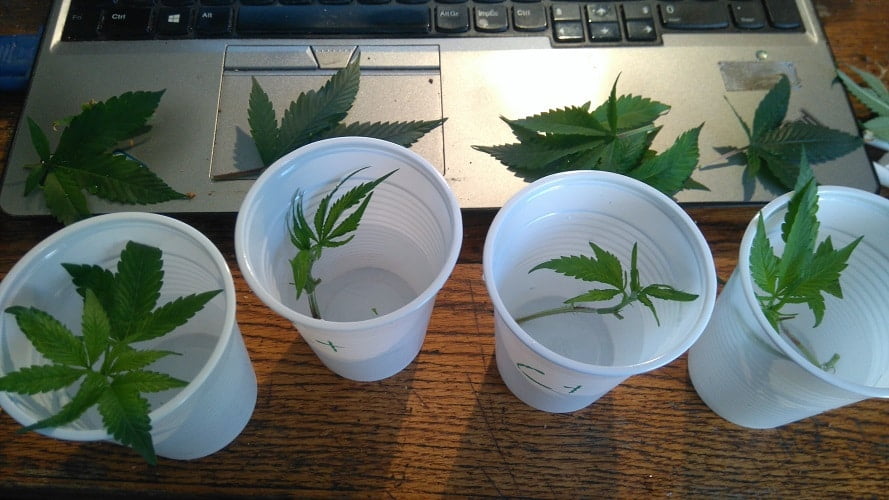
The first step to making the cuttings is obviously picking and cutting the right branches from the mother plant ^^
This round we started with 7 branches, planning that we would lose one or 2.
As we detail in our how-to article on making cuttings, the branches don’t need much light in order to root, what they do need it NOT to sweat, so don’t hesitate to chop off most their leaves (the left one still has way too many leaves) and place them in a very humid environment (aim for at least 90% humidity).
Cuttings rooting in the vegetation tent
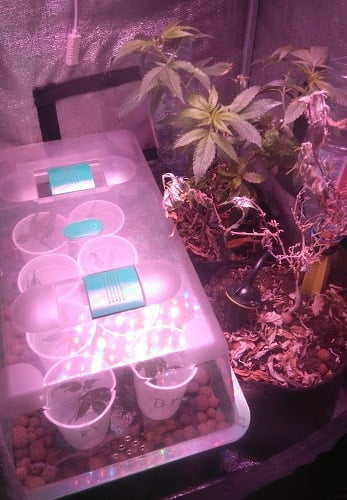
We left the little one in the cups of water for about a week, the time for some roots to grow.
At this point we lost one of the little ones, we had left the top latch open, it wasn’t humid enough and she didn’t make it… (told you we were slacking off :/)
As you can see on the pic one of our mothers isn’t looking well at all, all dried up and dying… We were so focused on the citizen lobbying tool that we didn’t water her enough and lost her :'(.
Passing the cuttings from water to soil
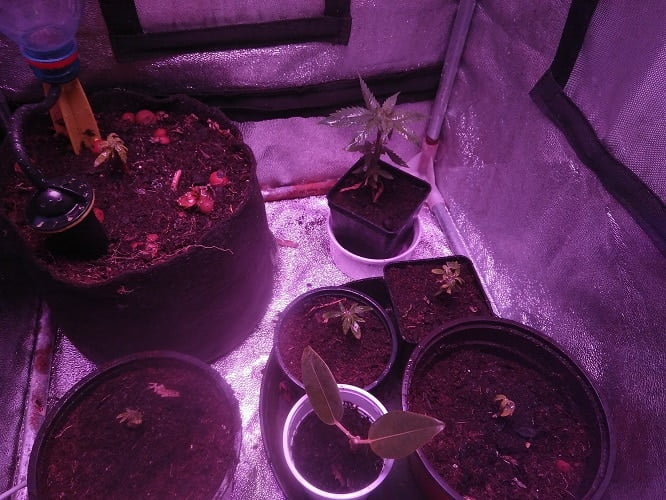
Once we had some nice roots we went ahead and transferred the cutting into our pots.
As you can see we have them in different size pots. The idea here is to keep one as a mother plant (top left). The 4 others we will re-pot and transfert into the flowering tent once they’re ready to stretch.
(Yep, we lost another little one between the 2 steps… we took wayyyy too long to transfert them into the soil)
That’s it for these little ones! As we speak they’re getting growing nicely, but we’ll tell you all about that in the next post 😉
Laughing Buddha Seed Germination
Here’s a little one we’re really excited about! First time growing it and really curious to see what it’s all about.
For a long time it was a best seller at Barney’s Farm, a coffee shop & seed bank in the Netherlands although now, unfortunately, a bit it’s harder to find these days.
Luckily, during our last trip in Amsterdam we were able to get a little seed! 🙂
(check out the trip on our insta account)
Alright, enough said, here’s some pics of the germination process of this little one
Seed Germinating – A humid and dark environment
Just like for the cuttings, we’ve made a full how-to article detailing the best ways to germinate your seeds, if you want to know more on that check it out over here

We set the little one in a humid paper towel between two bowls. At first it was wayyyy too humid in there, so we left a little crack between the bowls in order to let some humidity out.
5 days later, the tap root has broken the shell
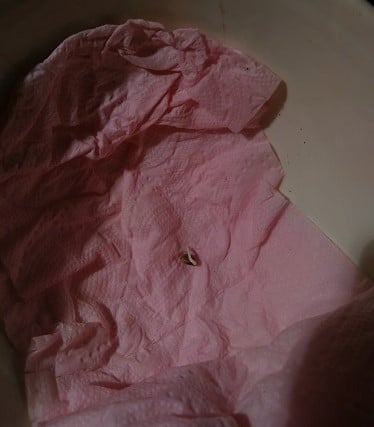
The morning after leaving the crack between the bowls we saw the tap root starting to break the shell; The picture above was taken that night and, as you can see, it’s big enough to plant 🙂
Seed you soon cotyledons 😉

With the tap root about a centimeter long we planted the soil, about 1.5 cm deep. This depth gives it enough room to break soil and deploy the cotyledons with little effort, while the tap root can get comfortable in her new home.
As soon as we covered the seed, we set the pot in a bowl of water in order to humidify the soil without disturbing the seed.
48 hours later – Soil has been broken and the cotyledons deployed
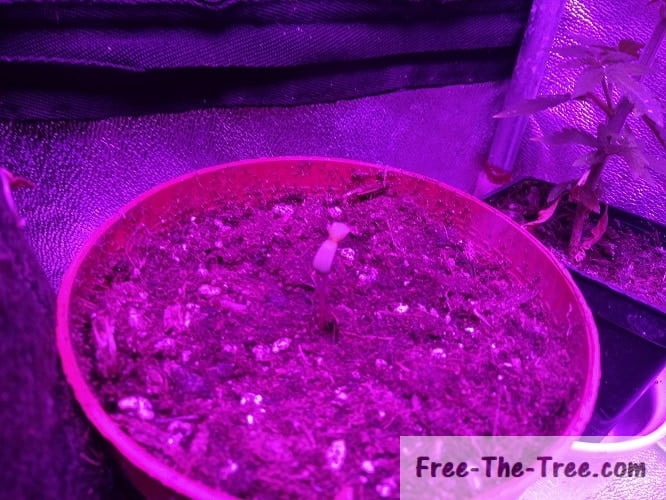
A little under 48 hours later she had broken the soil and deployed her cotyledons and, you can’t really see it but, the first leaves are starting to grow.
We actually missed the ground breaking process which sucks… so awesome to see ’em say hello to the world for the first time.
As we speak the first leaves are starting grow more and the cotyledons are starting to die out; We set the pot on a box in order to get the Apex closer to the light in order to avoid any early stage stretching, we don’t want her to get top-heavy ^^
Alright folks, that’s it for this one!
Until next week, be safe and grow easy 😉
Hey there and welcome (back) to Free The Tree!
This week we finally started the Stretch 🙂 The Potassium deficiencies we were seeing totally stopped spreading which means they now have sufficient levels so we’re good to go!!
On the top picture you can see that out canopy is far from being even which isn’t great, we’re planning to do some FMIing and pruning during the stretch to get that all evened out 🙂
Here’s what we’re going to cover:
- Starting the Flowering Stage
- Vegetative growth during the Stretch
- Pruning branches and leaves
- Super Cropping the top colas
18/6 to 12/12 – Starting the Flowering Stage
In order to get the flowering stage going we need to change the photo-period from 18 hours of light to 12 hours, triggering the wanted change in behavior.
All we’re doing by changing the light cycle is imitating nature, where by the end of the summer the number of daylight hours start being as close as the number of night hours.
The most important thing here is to make sure that they’re in full darkness during the night hours, irregular lights may produce hermaphrodites, which no-one wants (except for seeds)
The days after you change the light period you’ll see your plants starting to grow strongly. By the end of the first week some pistils should also start appearing.
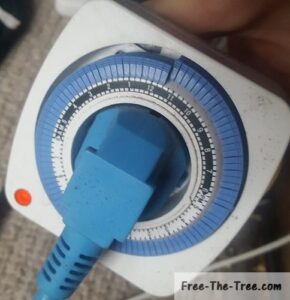
Mechanical Timer for Photo-period control
Week 1 of the Stretch – Strong Vegetative Growth
Over just 7 days they’ve all grown a whole lot but I think the most impressive is the Cheese plant, she’s doubled in size which is pretty cool since she was the smallest plant.
It might just be a visual thing though, since she only has 1 main coals whereas the others have multiple.
Here’s a couple pictures of the stretch

Day 0 – Tonight the light will shut off earlier
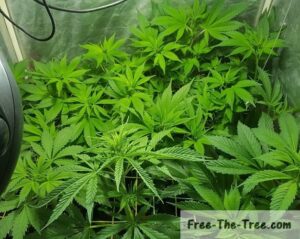
Day 6 – Strong Growth, grow room is full
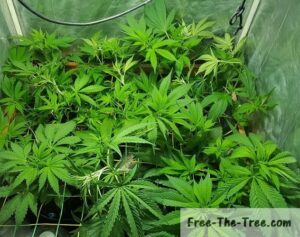
Day 7 – FMIing, Pruning and Pinching
On day 6 and 7 we decided to start pruning a whole bunch of branches and leaves (mainly branches).
Let’s get into why we did this
Pruning leaves and branches during the Stretch
Since there was such a strong growth during this first week we decided to go for a round of pruning on the 2 Big Buddha Cheese plants.
These 2 gals have produced just to many side branches. If we had kept them this way we would have a bunch of small buds instead of a nice and strong ones. In order to avoid this we’ve removed all the small branches that didn’t show potential.
Whether it’s because they had no direct access to light, better looking branches next to them had more potential or the bud sites were too far apart, they’re gone, without going overboard of course.
Here’s a couple pics (as always click on them for the full view)
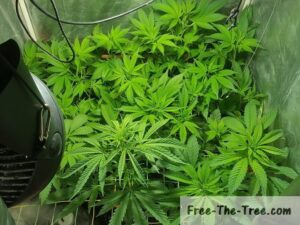
Day 6 – Before first round of branch pruning
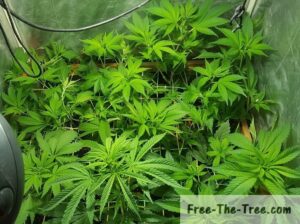
Grow Room after pruning

About 10 branches removed
There’s another reason for this pruning we didn’t mention above and this is the room around the Colas.
If you’re colas don’t have enough room around them they will basically race each other to the light source. This will make some lengthy and weak stems, which won’t be able to transport many nutrients, thus producing smaller buds.
You want the leaves of your different plants to overlap or touch as less as possible.
Super Cropping the top colas
As you may have noticed our Big Buddha Cheese plants are much, much bigger as the others and some of those cola’s are way taller than the others, which is an issues for the light balance..
In order to keep our canopy as even as possible we’ve decided to super crop the top Colas. This has 3 advantages
- Folding the cola reduces its height
- While she recovers growth will be slowed on that colas
- Once she recovers she’ll be able to store more nutrients within the stem.
We started writing a guide on super cropping : check it out if you have questions on super cropping weed.
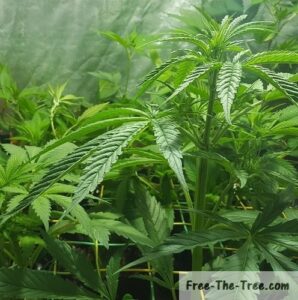
Cheese plant before super cropping
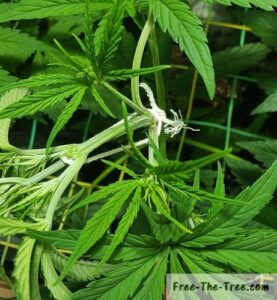
Apex Folded and tied horizontally
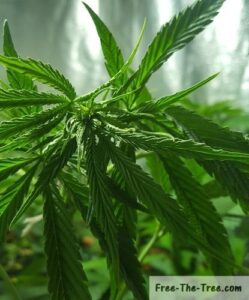
View of the Horizontal Apex
We repeated this process with every auxiliary branch that we decided to keep. She will be working at repairing these sections, making them more resilient.
Alright folks that’s all for this one!
Until next time, be safe and grow easy 😉
Don’t want to go yet? Check out our other Grow Reports
Check out all our Indoor Growing Tips
Heyheyy everyone, it’s been awhile since the last little grow report!
We’ve been real busy improving the strain comparison tool available (check it out!) as well as the citizen lobbying tool that will be deployed on free-the-tree.org, so some exciting times ahead, but it leaves little time to write about our babies ^^
In this grow report we’re going to cover the past month of the grow. The little ones have grown nicely, we’ve got different levels of development as well as different strains, it’s going to be one interesting flowering period with all their different needs.
We’ve also still been dealing with these pests which has delayed us starting the flowering period. The hesitation comes from the fact that we’re mainly dealing with fungus gnats and these suckers attack the root system. Once we start flowering we want the plants to be in good condition so that they can focus on bud growth, not survival… sooo decisions decisions.. Anyway, here’s what were going to cover today
Table of Content – Grow Report n°5
- Big Buddha Cheese clones rooting
- SexBud early vegetation stage
- Fungus gnats… and other pests
- Making cuttings
- Laughing Buddha vegetation stage
- Blue Thaï Scrog Setup
- Round of transplantions
Big Buddha Cheese clones rooting
Last grow report we told you a friend brought us some clones of one of our faaavorite strains Big Buddha Cheese 😀
We had had a mother of this strain for awhile but she didn’t survive last year’s crazy heat (RIP) and we were all out..
The little clones started rooting nicely, although we had a freaking stink bug-type insect lay eggs (ty to Bannana_bin for helping ID it). The larvae seems to have fed on the foliage of the cuttings, killing the weakest clones..
Luckily we noticed quickly and were able save one individual. As you can see in the pics below, the bugs larvae is chillin (and feeding) on the leaf, leaving black scaring behind.
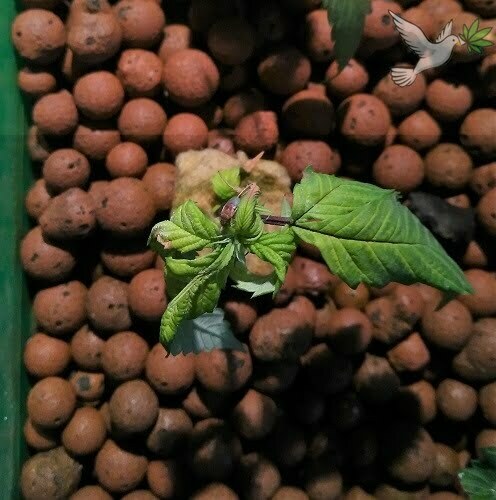
Beetle type pest on BBC clone
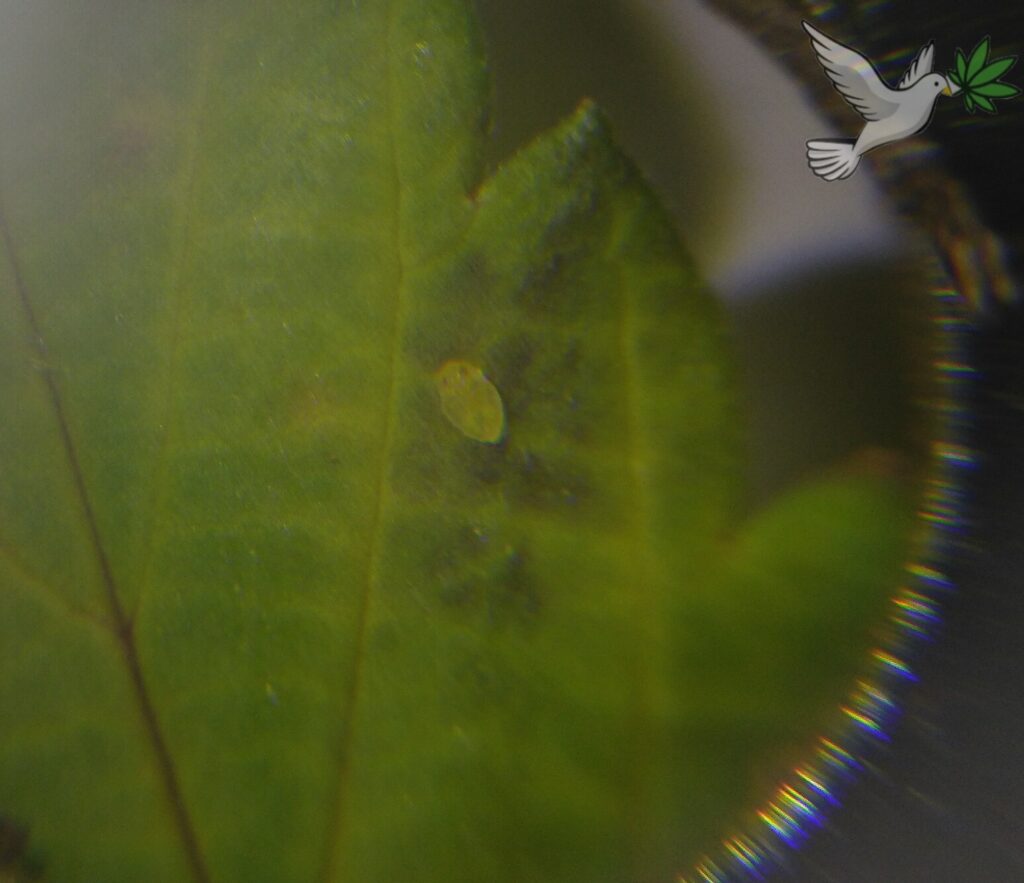
Pest larvae feeding on leaf
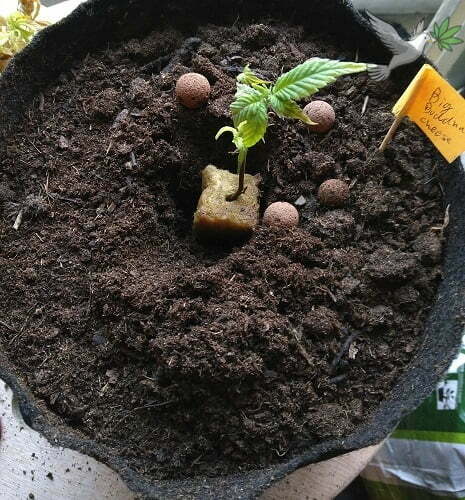
BBC survivor planted into soil
That said, she’s now fighting the fungus gnat larvaes and pupas… If/when she survives all this, we will have one stroooong mother plant!
SexBud going through the vegetation stage
Now this little SexBud, by Female Seeds is growing real nicely although our humidity levels aren’t optimal at aaaall 🙂
We had just germinated her when we wrote the last grow report and look at her now. We haven’t given her any nutrients so far, although we’re going to start adding some NP in the next feed to prepare her for the stretch

SexBud cotyledons freshly deployed

First stage leaves fully grown

Second stage leaves grown, third level coming in
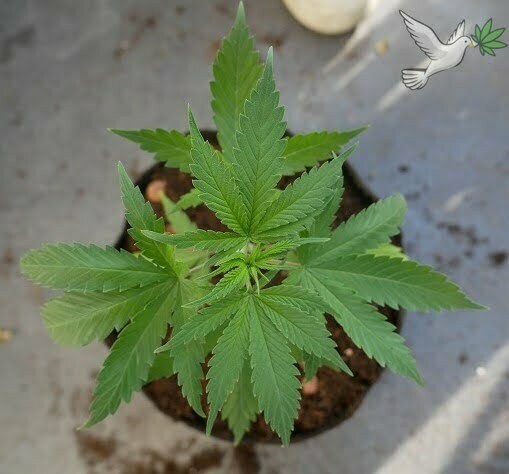
SexBud just before being topped
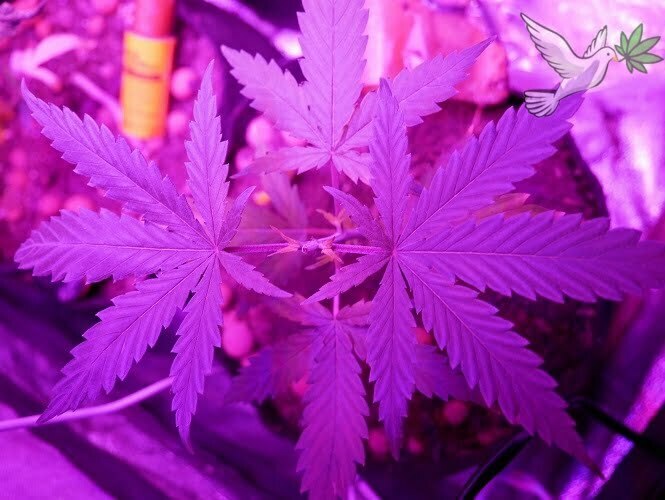
Auxiliary branches growing in
We topped her before writing this piece and are still hesitating on on scrogging her or going for the same LST training as the laughing buddha (see below).
Until we decide we’re going to let her grow a little and then place her in the special little spot we got for her in the flowering tent. Just before the stretch we’ll decide if we place her on the smaller screen or not.
Can’t wait to see go through the cycles of the flowering period!
Fungus gnats persiste and signs of other pests
Once introducing the nematodes into the tent everything started getting much better, we really though we had jumped through this hoop..
Turns out, we had forgotten a pot in the room and a little female laid some eggs in there. We were gone for 10 days, when we got back found a couple individuals within the grow room soo… here we go again..
We also had the pleasure to discover a blackflie and spidermite nest within our outdoor “garden”… hopefully we will be able to manage them well enough out there, avoiding any indoor issue
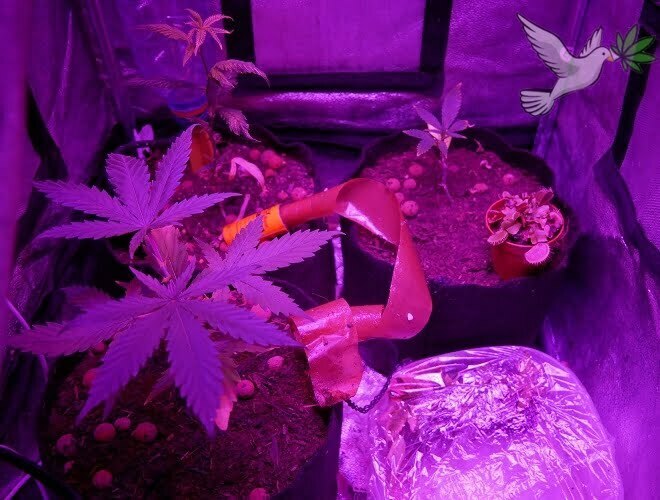
Sticky traps deployed to catch adult fungus gnats
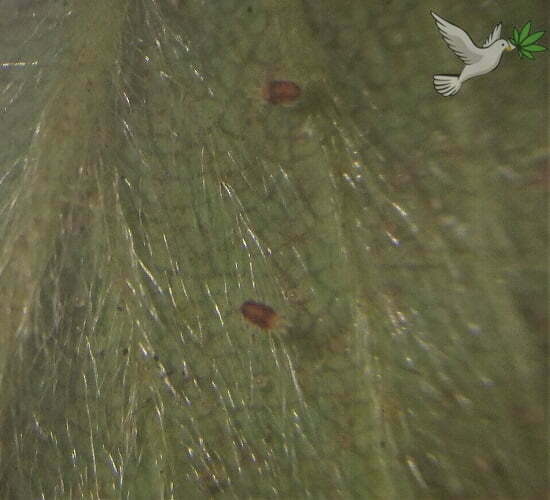
2 spider mites (and a couple eggs) under strawberry leaf
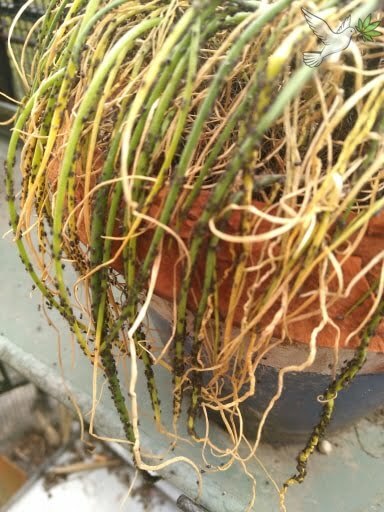
Hundreds of blackflies feeding on lemongrass
Making some Laughing Buddha and Blue Thai cuttings
For these 2 strains we popped our only seeds and wanted to keep the strain around just in case so we decided to go ahead and clone them hehe
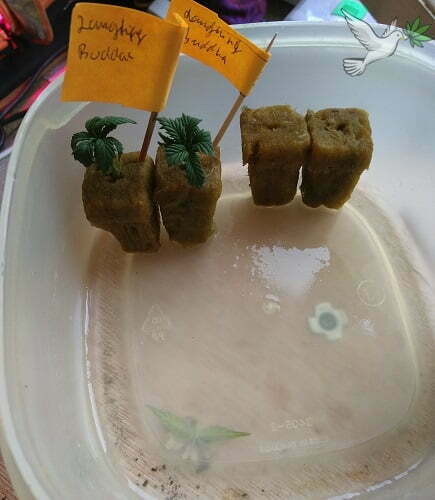
2 of the 4 cuttings made

4 cuttings in air-proof container
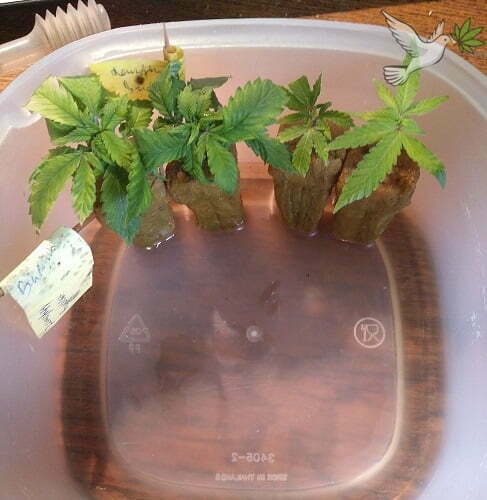
about 10 days later – 1 visible rooted plant, 3 pending (but still alive!)
At the time we’re writing the article one of the laughing buddha cuttings has grown a nice, strong, tap root. We’re about to set it into soil to let it grow.
The 3 other cuttings are looking ok, we’re going to leave them a couple more days in the container to make sure they’ve rooted nicely before planting them in soil
Laughing Buddha – About to start the flowering stage
Last grow report we had just topped this little one in order to prepare her for a scrog. As you can see below, the had grown nicely since. We defoliated her a couple times in order to keep these 4 main auxiliary branches.
Since the blue thai is about ready to flower, and we have successfully cloned her we’re going to flower her like this, can’t wait to see the first pistils starting to appear 🙂
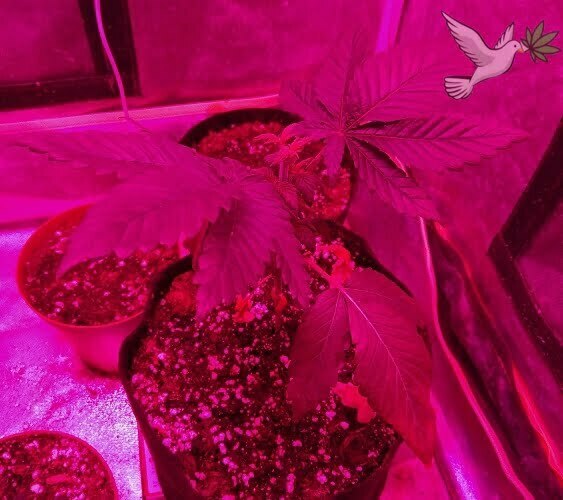
Freshly topped, first auxiliary branches growing in
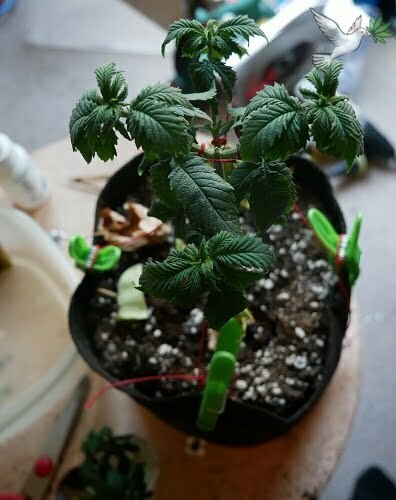
4 branches growing in
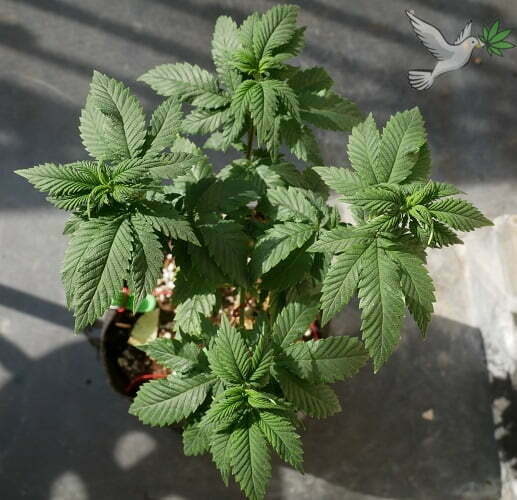
4 auxiliary branches grown in, flowing time approaching
Blue Thaï ScrOG setup
Sooooo, if you’ve followed some of our previous grows, you know we’re pretty big fans of scrogging.
The thing is, with the back to back pest issues we’ve been having for the past year it’s becoming problematic not to be able to take out the plants for inspection during the whole flowering period.
In order to get the best of both worlds we decided to make some individual scrog screens for 2 of our plants. We’re definitely loosing a bit of room, but we figured it’s not a real problem, it’ll allow each plant to have a little room to breath.
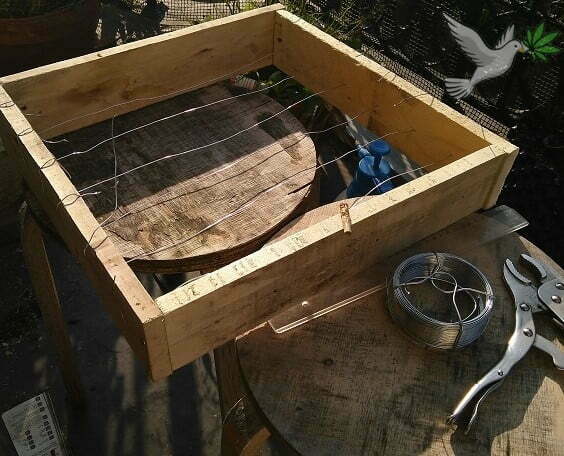
Frame of the net and first wires in
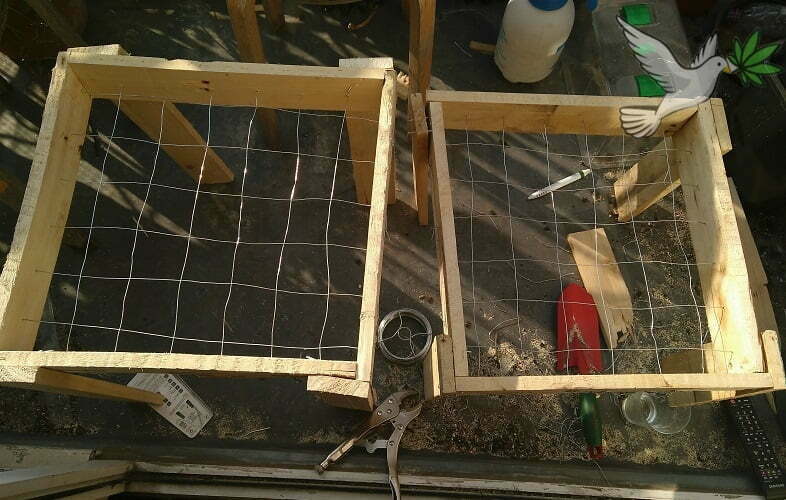
2 scrog nets ready to use
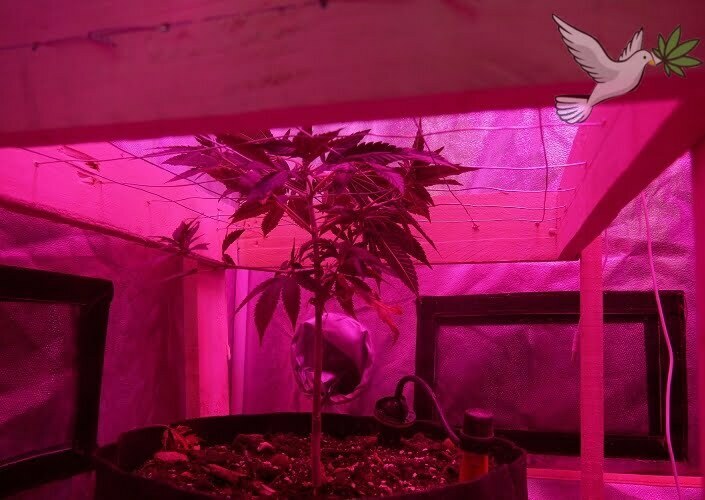
Blue Thai freshly installed on the screen
If you want to check out how we made the scrog net we documented each step over here, total cost ~5 bucks 🙂
With the screen ready we started weaving the blue thai. Once she’s covered about 60% of the screen we will change the photo-period so start the flowering stage hehe
Transplanting 3 little ones
On this 4/20 this little ones were ready to be transplanted 🙂 The laughing buddha and critical + will be flowered pretty soon. Since we just topped the sexbud we’re going to leave her a bit longer in the vegetation tent.
Once her auxiliary branches have grown a bit more we’ll place her into the flowering tent so that she can stretch and start growing some nice buds hehe
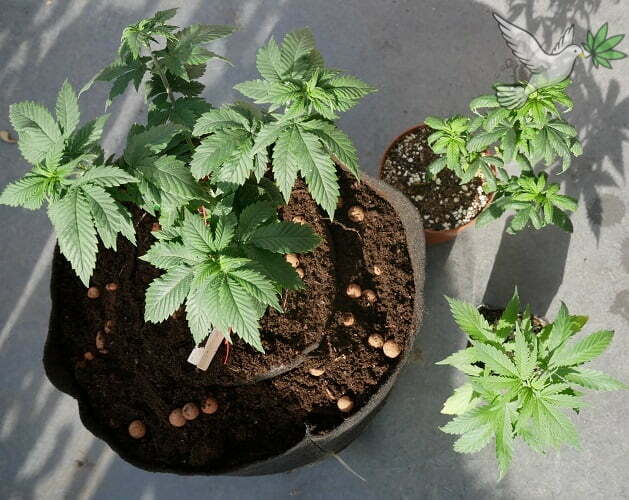
Freshly topped, first auxiliary branches growing in
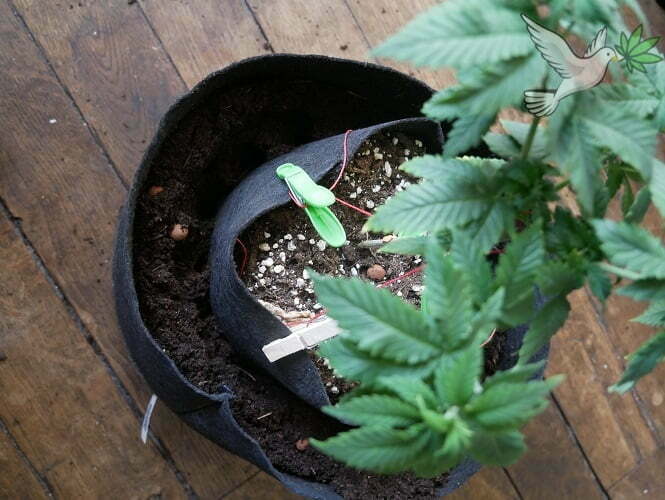
4 branches growing in
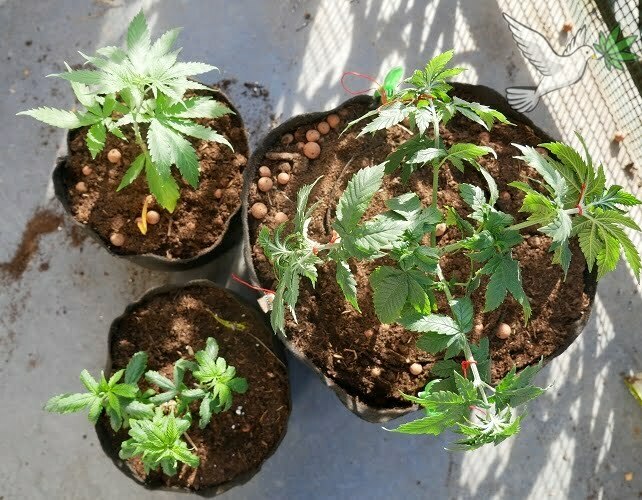
4 auxiliary branches grown in, flowing time approaching
Alright folks that all for this one! Hope you enjoyed it, I know we love sharing the growth of our babies as well as what we’re learning along the way 🙂
Remember, if you want to share your experiences, knowledge, or anything, you’re more than welcome to! Just contact us through the form or via instagram
Until next time,
be safe and grow easy
Hey there and welcome (back) to Free the Tree!
This week was pretty exciting, most of the trichomes have started to show, we decided to go ahead a cut down one of our Colas (way too early to do so), we started back building the buds aaaaand we finally got an image of a live, grown thrips (find pleasures in small things right ^^)
Let’s get into it
Trichomes turning milky
We’ve been watching the trichomes closely for the past couple weeks and they’ve been starting to get nice and milky, especially the ones on the side leaves.
You can see on the image on the right hand side that the trichomes are mostly milky with a couple still clear.
Since we’re looking for more of a upper effect we really want to harvest while the THC levels are at their highest, meaning when they’re all milky and have just started turning milky. Seems like harvest is coming up soon 😀
Important note: Something we discovered by the end of the week, but in order to measure readiness looking at the leaf trichomes isn’t reliable. You must look at the flower trichomes or the ones that are are the very small leaves sticking out of the buds.
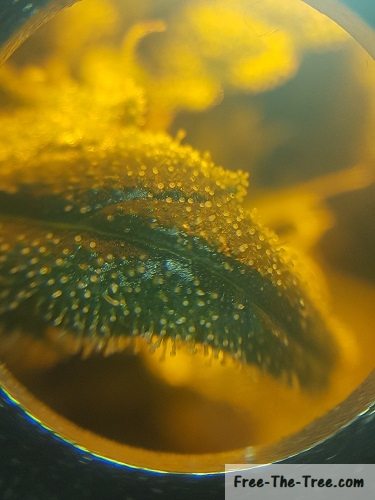
First Big Buddha Cheese Harvest
By the end of the week, after looking at many trichomes we decided to harvest a first cola.
We did this for two main reasons
- It seemed to be at that THC peak
- That cola was really pressuring the Blue Thai, which doesn’t have enough room and isn’t looking too great
Turns out, we really harvested her too early, as we said most of the trichomes are milky but there’s still many clear ones.
This bud definitely would have been much more massive if we had waited about 10 days before harvesting her… But at least we have a clear view of the development stage of the Big Buddha Cheese.

Harvested cola after pruning
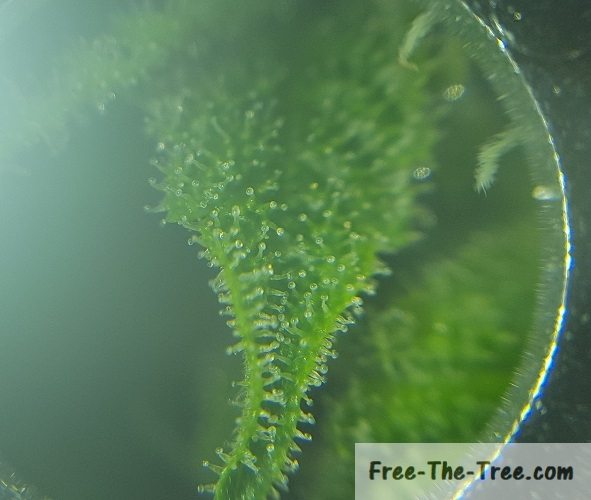
Clear and Milky Trichomes – Harvested too early
As you can see on the image on the right hand side some of the trichomes are still clear, we really cut this bud too early.. oh well it’ll be a soft taste of the rest of the BBC plant.
Back Building the buds
After cutting that the BBC bud we started looking into different ways to improve yield during the last weeks and crossed the “Back Building” technique. After reading into it seemed to be pretty effective, tested by many people within the community so we figured let’s try it out ^^
Basically the idea is to remove the top tip of the flower. The way marijuana flowers response is to stop growing in height and start getting thicker and fatter. Here’s a good video we crossed that shows how to do it pretty well.
Hopefully it’ll get the buds much fatter 🙂 keep you updated in the next reports
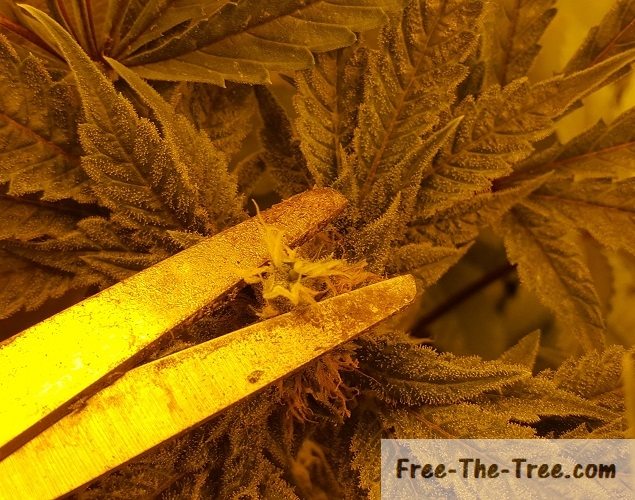
Back Building marijuana flower
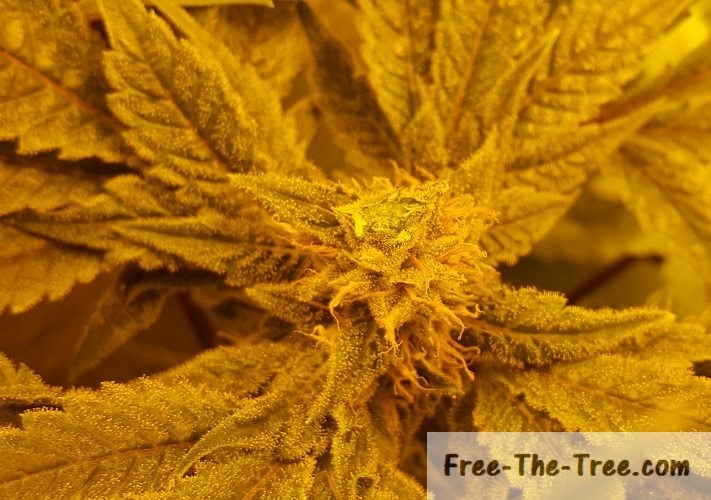
Top tip of the flower cut off
Thrips Thrips Thrips
While pruning the bud we harvested today we noticed one a couple thrips larvae and one adult thrips fall off.
Here’s two pictures of the adult thrips, if you want think you have a Thrips issue we’ve grouped everything together over here.
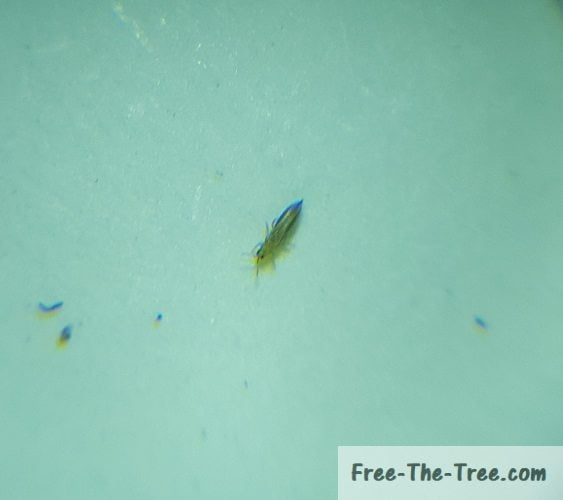
Front side of Thrips – Black streaks visible

Back side of adult Thrips – Looks whiter
Alright folks that’s it for this week.
Until next time, Be safe and grow easy!
Miss a couple episodes? Here’s all our other Grow Reports
Read up on our Indoor Growing Tips!
Hey everyone ! Long time no see…
We really haven’t been active on the website these past 2 months but we haven’t been off !
Although most our visible activity has only been on the Instagram account we also partnered up with United4Earth in order to group forces and fund the citizen lobbying tool.
We’re proud to announce that a couple days ago the crowdfunding campaign ended successfully, raising over $11.000 with 525 participants! 🙂
25 days of Crowdfunding on Ulule
The crowdfunding campaign lasted a little under a month and was, the least to say, intense.
United4Earth was mainly focusing on France for their efforts since there’s a rise for climate going on for the past couple months, most of the events went on overthere.

The 10.000€ needed to fund the first version of the tool was reached on Monday the 15th of Octobre, a couple days before the end of the campaign. By the time we reached the last day we had passed the target by over 1500 euros !!
What will the tool look like?
If you’ve followed us on Instagram you may have already seen some videos or screenshots of what the tool would look like.
Since then, things have evolved a bit, but the concept is the same ! Here’s a quick video that shows a citizen of South Carolina using the tool on United4Earth.
Get the concept? We’ll be able to do the same for Cannabis legalization on free-the-tree.org !
When can we start the citizen lobbying to legalize cannabis?
Now that crowdfunding campaign is finished the developers have started working on the project. The goal is have the bêta of the tool up and running on United4Earth by the end of November 2018.
We will need some time to test the tools and fix the bugs that will show up. With that in mind, the idea is to open up the tool on the subject of Cannabis between January and February 2019!
Want join the community now?
Welcome back to our Critical+ 2.0 auto-flowering and Fruit auto-flowering series!
If you haven’t been following up here’s a little recap.
A little over a month ago we germinated 7 marijuana seeds, 2 Critical+ 2.0 auto-flowering and 5 Fruit auto-flowering. Unfortunately one of those fruit seeds didn’t take so we were left with 6 babies.
During the early vegetative stage we had couple issues with the balance of our sprouts and early stem with about 2/3 of our plants.
After that the flowering stage got going waaaaay too early because the main root hit resistance.. Yeahwhat makes the an auto flowering plant go into the flowering stage is the root system… something we didn’t know and learned with this one! We’ve covered all that in our guide on auto flowering seeds if you want to know more.
So here we are, after the first days of the stretch, and you’re going to see that she’s totally changing, welcome to the teenage years!
Day 32 – Auto-flowering seeds entering the stretch
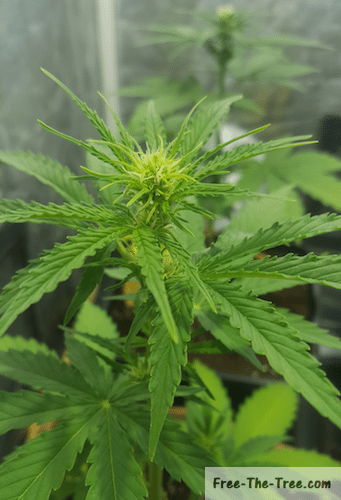
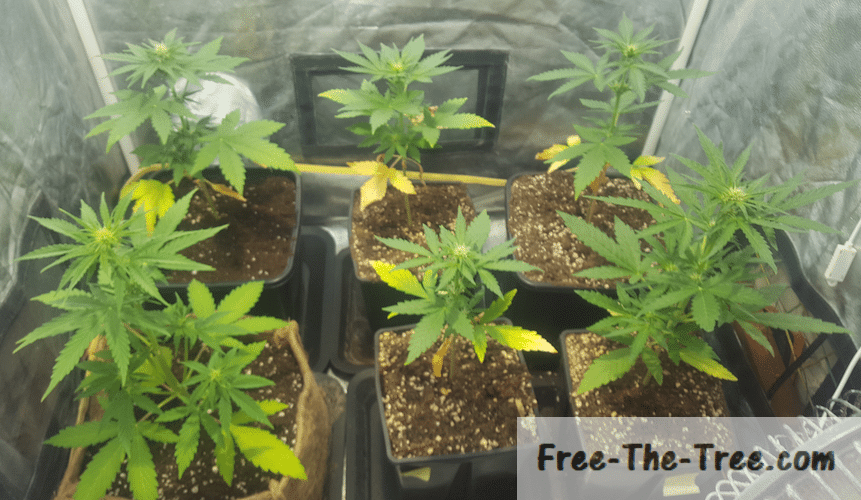
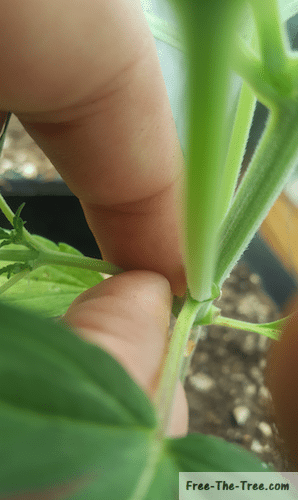
So during day 33 we started cutting (pruning) some branches and leaves. Normally you do this during the vegetative stage, but since we kind of got blind sided we’re doing this know.
We’re also having many deficiency issues as you can see with the colors of most of our plants.. Although it seems like the decision of lifting the lights about 15cm (5.9inch) did some good to them. Here’s a couple pictures of the leaves showing issues. We’ve got hypothesis’s on why it’s happening but still not sure… One we figure it out we’ll Update this section to let you know! (If you have an idea share in the comment section!)


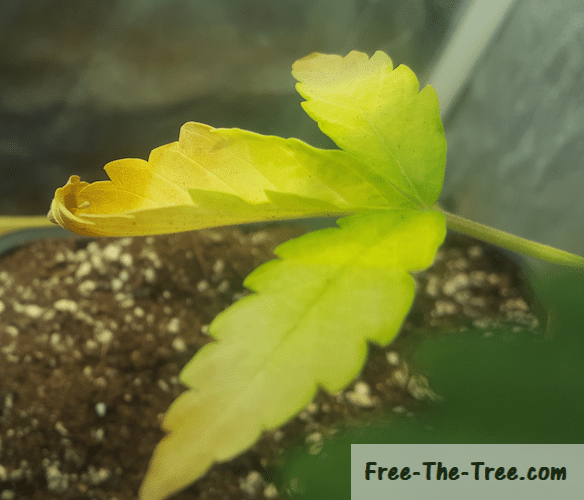
Spotting deficiencies during the stretch
So our suspicion here is Light burn. We hadn’t lifted our light yet since we put them in the grow room, it was about 20cm over head which isn’t that close, but they had been used to a light source that was further up so who knows it’s possible.
I know you might be telling yourself “that’s Nitrogen deficiency”. There are 2 things that go against that hypothesis:
- I’ve given them plenty, some of the plants with these deficiencies are actually also showing signs of nutrient burn
- The dead leafs aren’t falling of very easily, you have to pinch or cut them off to remove them from the stalk.
Now that second point is actually the one that hinted me off the most. Why? Because Nitrogen deficiency and light burn globally have the same signs, apart from 2 things. One of them being that with ND the dying leafs will just fall off, whereas with light burn they are hard to remove.
The only this that has me still hesitating is the fact that these signs are coming from the bottom of the plant, where normally light burn starts on top (second difference). But, these are also the main leaves receiving light, so it’s not totally crazy to think this.
In the pictures I didn’t show the next steps, but the leaf becomes all brown and dead, after which you need to pinch it or clip it off. This way to remove it is pretty unusual for a dead part of the plant.
Anyway, we brought the light up, hope it will do the trick.. they’re already not that big, loosing leaf mass is the last thing we want during the flowering stage.
This is a bit paradoxal with what I just said, but we’ve also been pruning some of our plants.
The one’s with the most deficiencies we’re cutting off all the side branches and pop corn buds, on the others removing the leafs in order to give direct light access to the branches below.
Pruning the marijuana leafs during the stretch
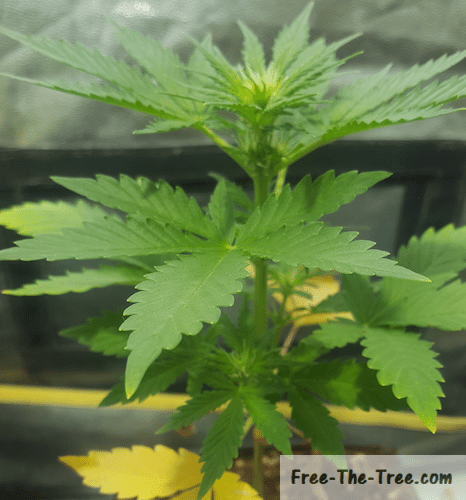

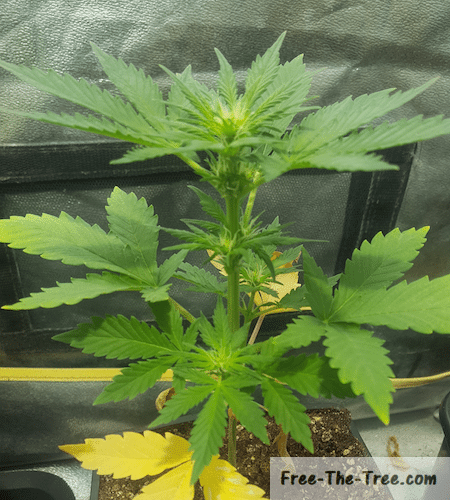
We’re going to go over the pruning (or cutting) of marijuana leafs and branches in 3 steps:
- How choose the leafs or branches you’re going to prune
- How to prune your marijuana plant
- What are we aiming for in this culture
In this example we’re taking a leaf as an example, but it’s basically the same thing with branches.
How to decide what to prune off your plant
During the stretch you really want to minimise extensive growth. The taller the plant, the more energy it takes to get the nutrients for the soil to the colas, as well as the “food” created by photosynthesis.
Keeping this in mind, if the branches you decided to keep don’t have direct sunlight due to a leaf making shade you need to cut that leaf. If you think it’s too risky because you don’t have enough leaf mass than cut that branch (or wait a little if you’re still in the vegetative stage).
Again, normally this is something best done during the vegetative stage since you can most likely recover, but we don’t really have a chance here.
Now that you’ve identified what you want to cut off, let’s look at how to do so.
How to prune your marijuana plant
- Identify the leafs or branches you want to remove
- Pinch at the intersection between the leaf or branch and the stalk of the plant. You can also decide to use a pair of scissors or clippers.
Whatever you use make sure you don’t damage the outer skin of the main stalk. - Clip the branche off
In the case where the branch doesn’t cut straight off and the other skin of the main stem is still attached, cut it as close as the stem as possible. Try to damage it as less as possible.
The days following this you will see the other sections of the plants grow more, the energy previously used at this spot have been reallocated!
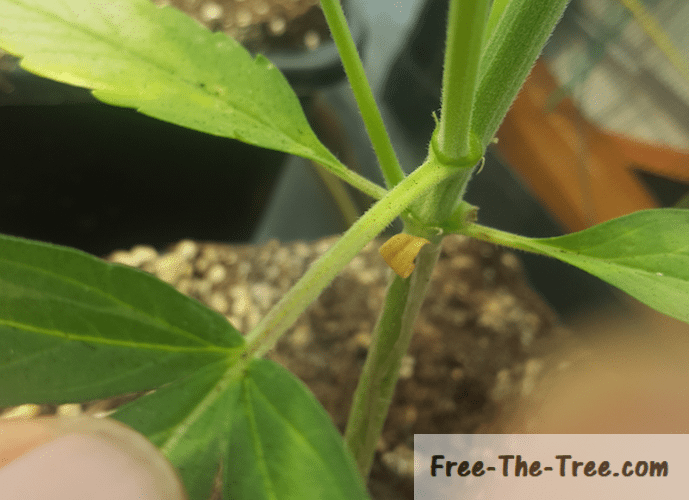

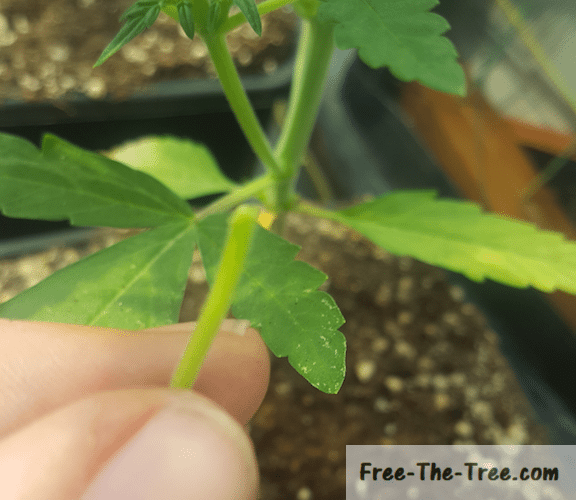
What are we aiming for in this culture
With 2 or 3 of our plants we’re decided to go for a one bud situation. The plants we picked only had 1 pair of small side branches and are the weakest ones. This will enable them to focus the energy they do have on their core flowers.
With the other flowers we decided to keep the main bottom branches, hoping that they will also produce a good amount of buds. We’ve remove all the “popcorn buds” or branches not receiving any direct light, hoping the cola buds will finish out to be nice and dense.
This means that on half the plants we had to mainly cut branches off, keeping the leaves for photosynthesis. On the other half we cut mainly leaves so that the main branches can have access to a direct source of light.
Globally we’re already aware that our harvest won’t be too crazy, this early flowering kind of screwed us.. But it’s alright, we learned something and could share it with you guys!
Day 33 – Nothing special to report
On this day nothing special really happened, so we’re going to share some pice with you guys!

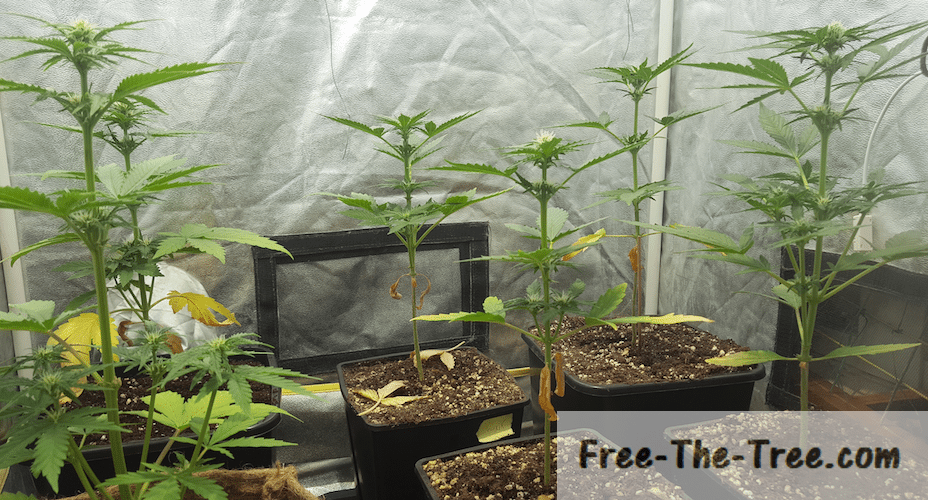
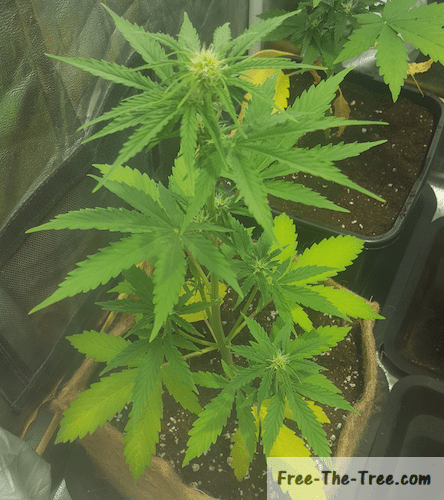
Day 34 – Changing to a Sodium Bulb
So we’ve entered the flowering stage for a couple days now and decided to change the light bulb so the sodium based one. The main difference between both is the light spectrum they emit. The vegetative light is more of a white/blue light whereas the Sodium based one if is more in a orange/infra red spectrum.
I’ve been reading around that during the stretch it can be good to keep the white light in order to reduce the spacing between the nodes, but honestly I don’t feel like doing more testing with these one’s, one yield isn’t going to be crazy, we’ll keep that test for the next run around!
Here’s a couple pics after the light change
P.S: remember to unplug your light before hand! I shocked myself, it hurts believe me!
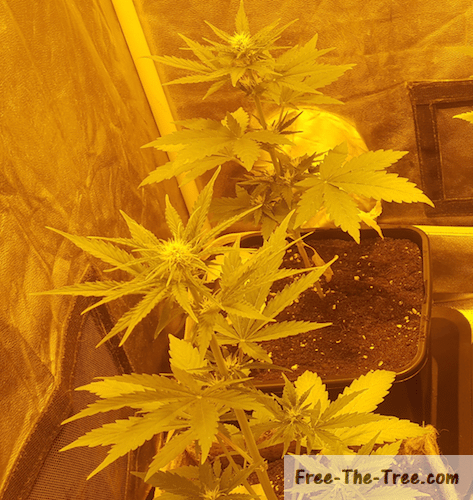

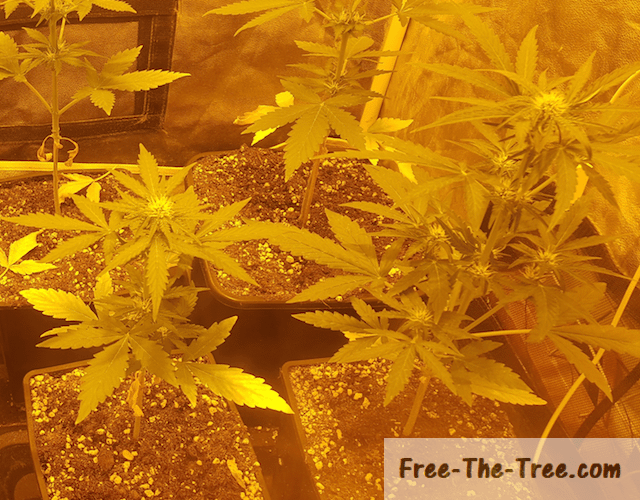
I don’t know if you guess which one’s we’ve decided to go for a one bud or not off these pics, we’ll let you know in the next article!
We’re also going to go for another round or pruning, but for the flowers this time. We want the energy of the plants to focus on the main flowers on the top colas, not the one’s further down the stem that have little chance to make anything worth it.
Until next time, be safe and grow easy!
Check out our previous articles on our Critical+ 2.0 and Fruit Marijuana Strains
Hey there and welcome our weekly grow report!
Here we are in the 5th week of the flowering stage and it hasn’t been much of a smooth road ^^
That said, these babies are still looking pretty nicely, their smell is getting stronger and stronger and seeping into the rest of the house.
This week was actually a pretty smooth one and we were able to get some preeeetty awesome pics hehe, lets get into it 😉
Trichomes fully formed
We’ve bee keeping a pretty regular eye on the trichomes all over the different plants and we’re pleased to see that they’re now globally all fully formed, still mostly clear no the THC production hasn’t started yet but things are looking nice 🙂
Here’s a couple pics, as always you can click on them to see the full version
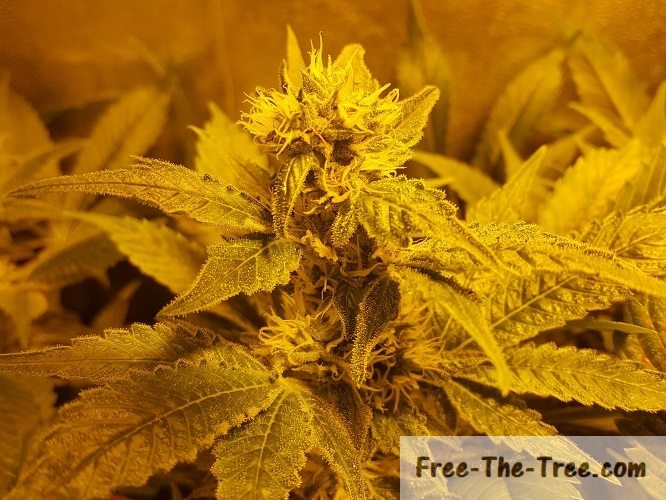
Flower full of trichomes

Close up on Pistils and flower trichomes

Close up on Pistils and flower trichomes
Aren’t these little things just beautiful? 🙂 In the picture all the way to the right you can see there full form and color, stem and the clear balled tip; those little guys will be full of THC soon enough hehe
Uneven Canopy
We’ve been saying over the past couple grow reports that a couple of our buds were too tall, especially the Cheese and, consequentially, the Blue Kush; We finally got some pics that really illustrate this disparity!
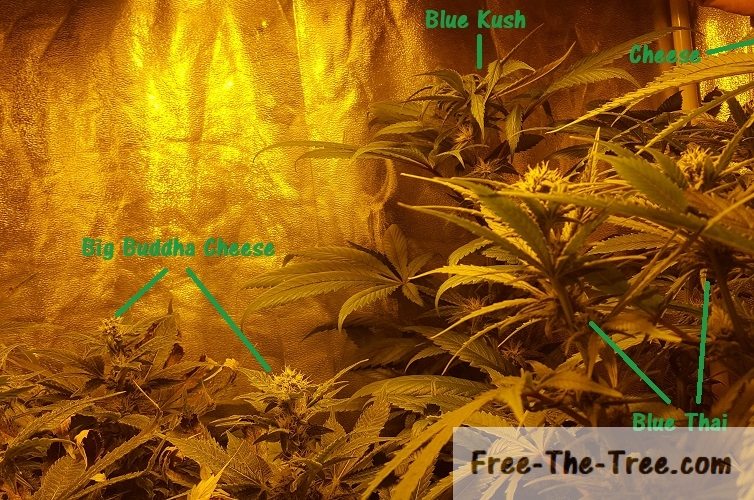
Huge Size difference

2 Plants much taller than the rest of the canopy
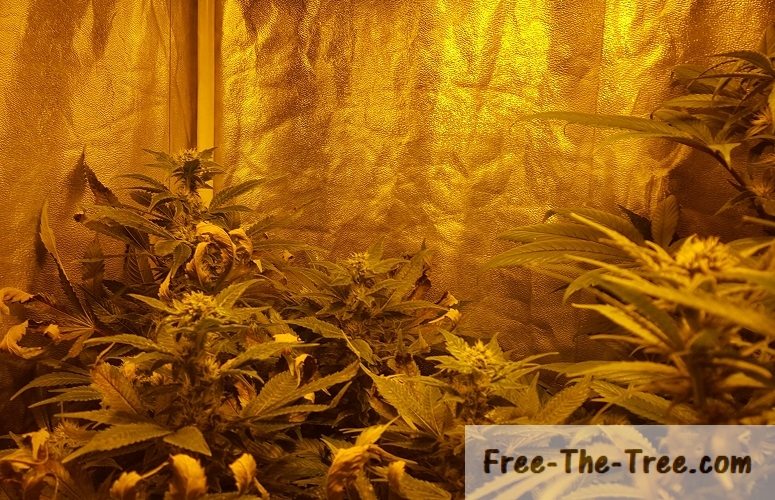
Big Buddha Cheese side is pretty even
Now keep in mind that cheese plant has been supercropped, she’s actually much taller than the Blue Thai next to her.
You can also see the Apex of the Blue Thai is suffering, looking all flat. I think it’s too hot for her so close to the hood so we decided to lift the right hand side of the hood as well as get the extraction hose near her in order to extract the heat right there.
Hopefully this will solve the issue..
Weed Buds developing nicely
This week the flowers have grown well, especially the Big Buddha Cheese.
As you can see in the images below Blue Thai is still between the buddlets to the flower, while the Big Buddha cheese is further along with long buds.
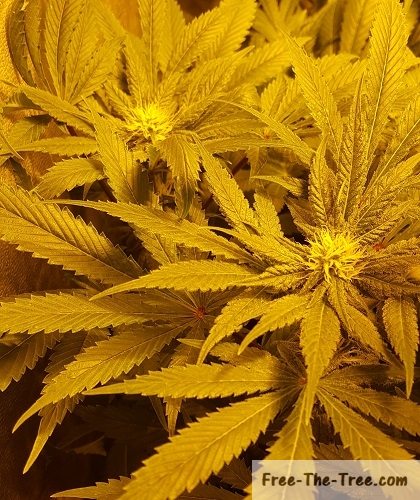
2 Blue Thai Buds developing
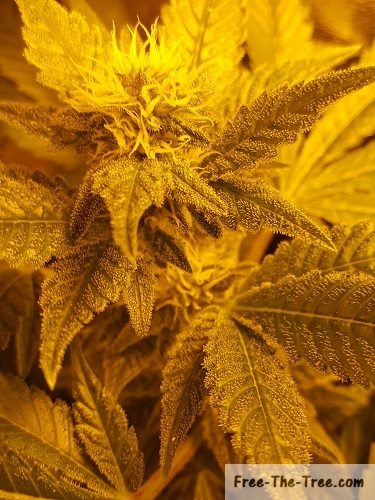
Big Buddha Cheese flowers and trichomes growing
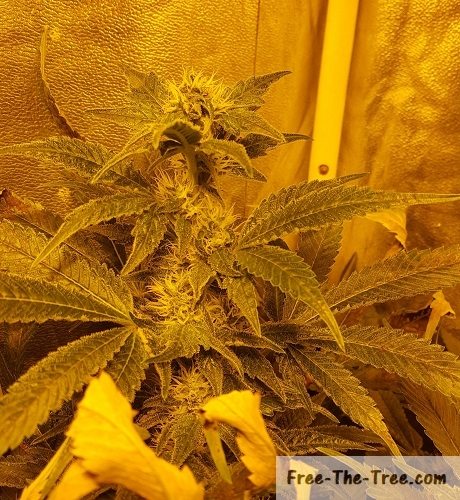
Main Big Buddha Cheese full of flowers
I think we’ll need to need to start flushing the Big Buddha Cheese a while before the other plants, which isn’t ideal since we’ve installed an automatic watering system.. We’re going to have to personalize it and set up switches in order to water the BBC separately.
Alright folks that’s all for this one!
Until next time, be safe and grow easy 😉
Don’t want to go yet? Check out our other Grow Reports
Check out all our Indoor Growing Tips
Hi there and welcome to the last grow report of the series!
If you’ve been following these, sorry for the time it’s been since the last report, we’ve been working hard on getting the Price and Strain comparison tool usable and on the (soon to come) crowdfunding campaign!
We want to get the V1 of the Communities Lobbying Platform up and running by September 🙂
Let’s get back to the grow report though: this past month has been pretty full of events, we had time to harvest, dry and start curing the buds and even smoke a little since the last grow report!
In total we harvested about 250g of dried buds, pretty happy with it, but it’s not to say we didn’t make a bunch of mistakes along the way.
Let’s get into these last steps of our babies lives:
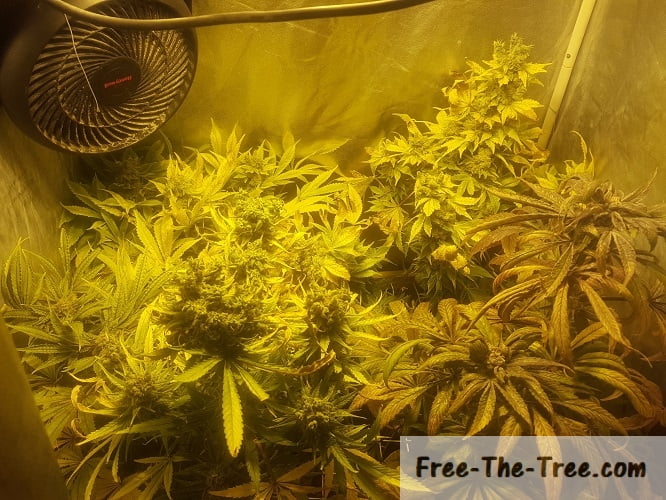
Grow room at the beginning of the Week
The Last Week – Harvesting Gradually
Since we had different strains in the front of the room, and couldn’t get well enough to into the back to be sure for the Big Buddha cheese plants we decided to harvest gradually over the course of about 10-15 days (started in previous grow reports).
Harvesting the Big Buddha Cheese Plant
We really had about 3 rounds of harvesting over the week with the BBC, first we cut a couple buds then went for the finish.
As they say, a picture’s worth a thousand words, so here’s a couple thousand words worth of bud harvesting :
Round 1 & 2
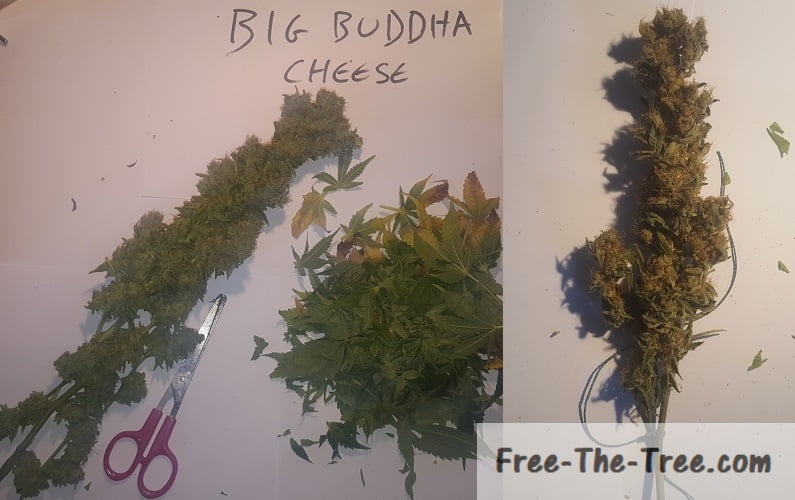
Buds harvested at the beginning of the week

Colas harvested a day or 2 later – Before pruning

Bud After Pruning
Here’s a quick picture during the middle of the week, these are all the first BBC buds and the Cheese plant drying.
After this pic some of the buds were ready to get into the jars to start curing.
Curing enables the buds to continue drying slowly. It’s really important as it helps remove the moisture, affecting the potency of your plant. Check out our full article on curing.

First Buds Drying in a Dark Area
Main Big Buddha Cheese Harvest
Let’s get to the real harvest for the BBC, took us about 4 hours to clean up all the buds and get them to dry. Takes a lot of time to get some nice, tasty, flowers in the end

Flower before pruning the leaves
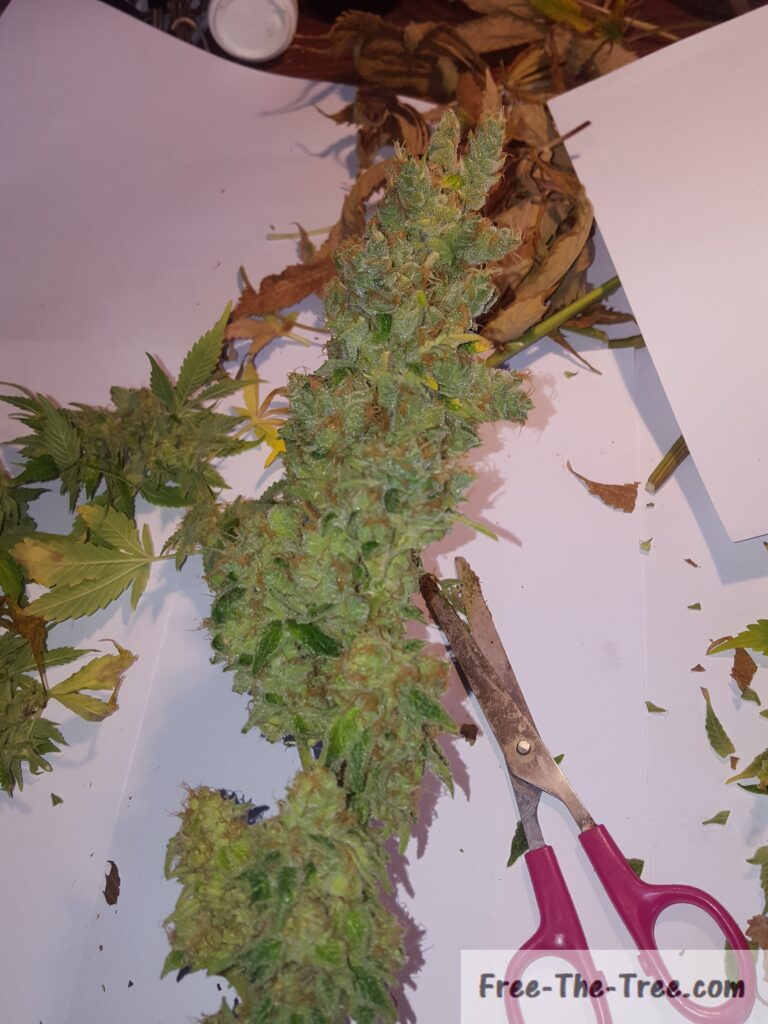
All leaves removed, ready to dry

Light Exposure during Night Hours created some funny looking Apex’s
Light Exposure during the Flowering stage
This is something we hadn’t really covered since I thought it was linked to the Calcium deficiency we had. After talking with a friend she shed some light on this.
See that picture above on the right? How the flowers are growing in separate ways instead of forming the usual, cone-like, flower? This is linked to the fact that light must have been leaking into the grow room at night, stressing the plant.
Let’s get back to the Harvest 🙂
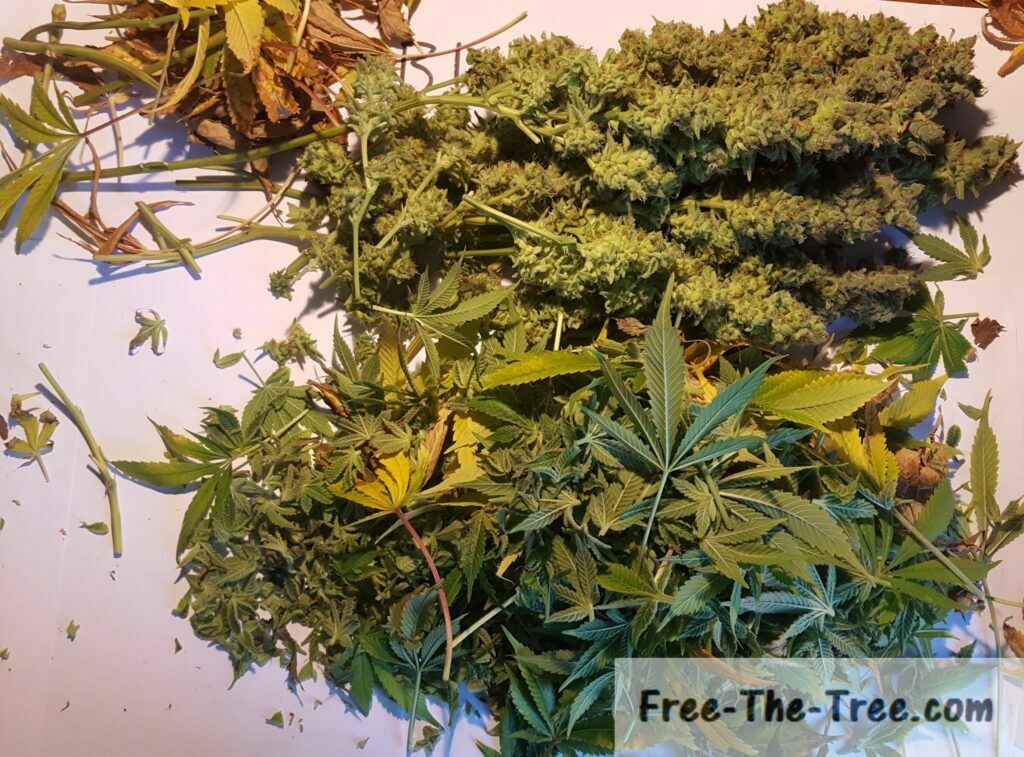
Stack of harvested BBC Buds and Leaves
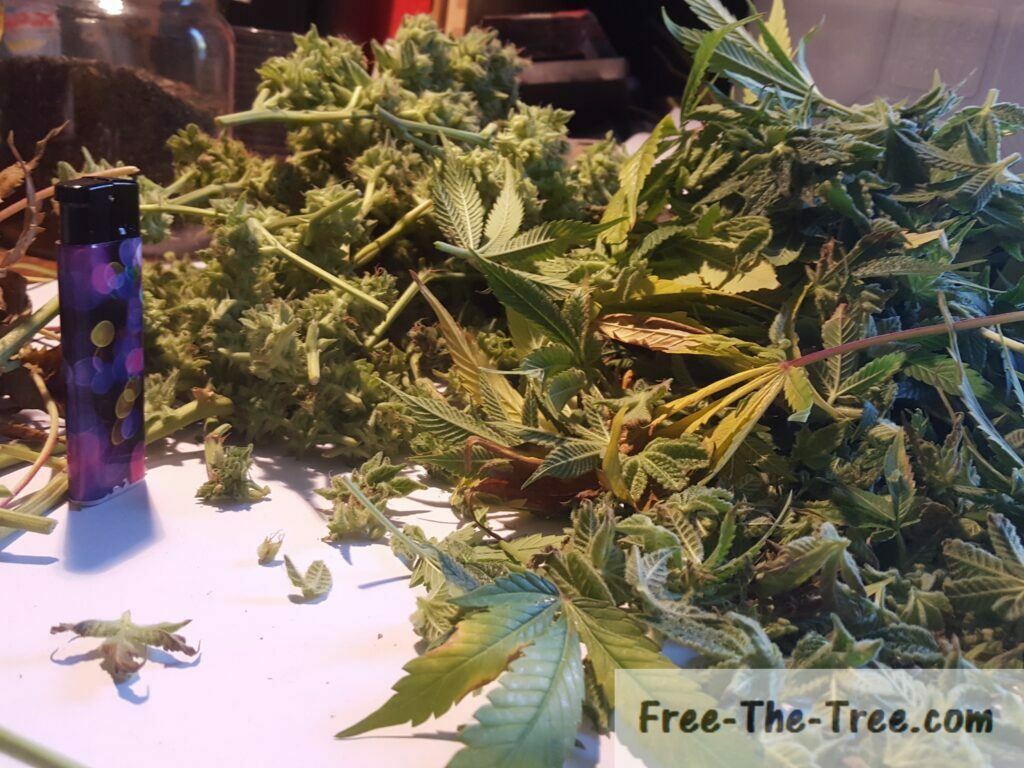
Horizontal view of the stacked buds
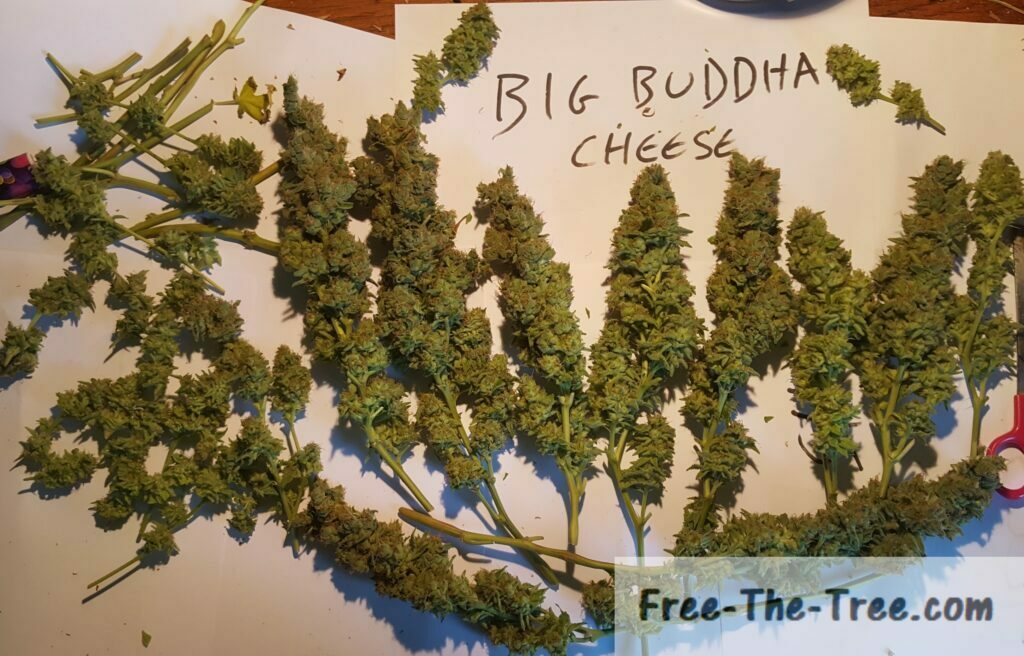
Main BBC Harvest – 10 to 15 Colas ready to dry
Once all the buds were nicely pruned, we attached a string at the bottom of the stem in order to hang them up side down to dry for about 10 days (until the moment where, when folding the stem, it cracks, without breaking).
Harvesting the Cheese Plant
Our Cheese plant really was a tree ^^ Appart from topping her about 2/3 weeks ago due to her height we harvested her at once, her trichomes were nice and milky, think it’s one of the ones we timed the best.
Her’s what she looked like out of the grow room (as always, click on the images to have the full view)
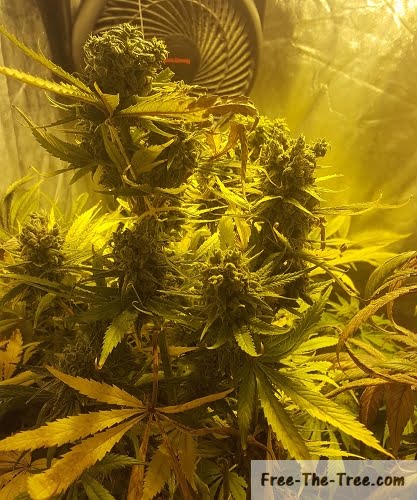
Cheese before harvest
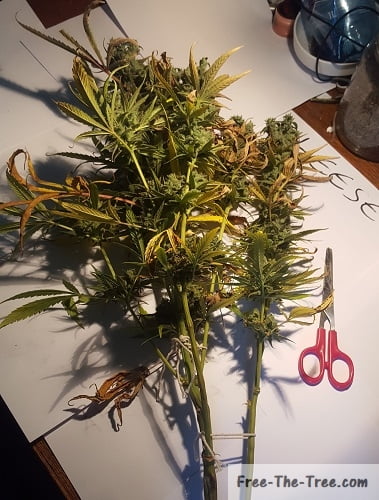
Freshly Harvested Tree
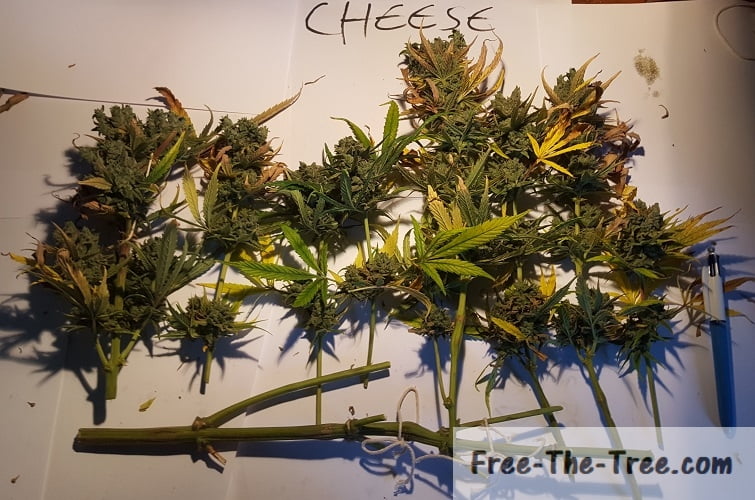
Branches cut from the tree and ready to be pruned
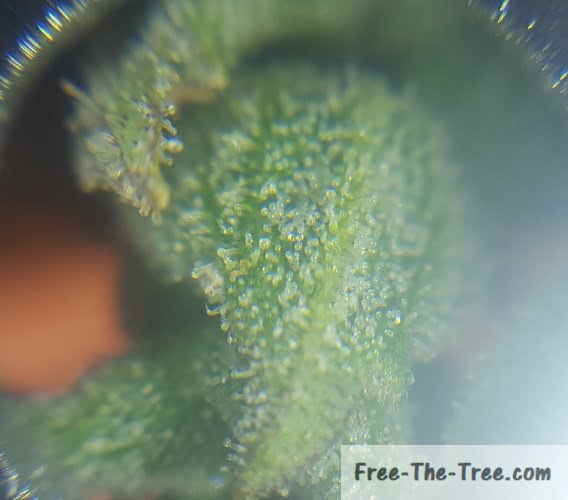
Whole bunch of nice, milky trichomes
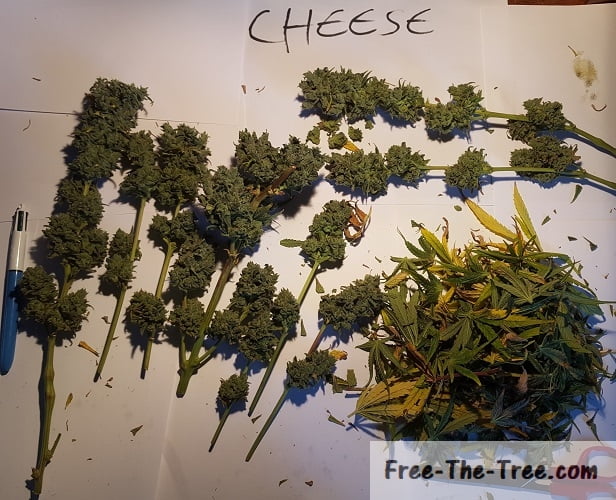
Buds pruned and cleaned, ready to dry
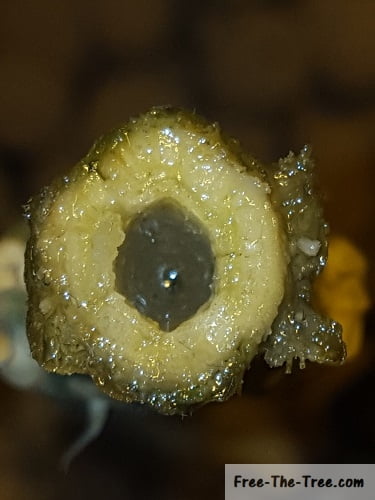
The sap kept flowering for a couple days, showing that the roots were still active!
It’s really too bad she had stretched as much as she did, I really think that she could have produced much more buds if she wasn’t as close as she was to the bulb.
We def should have scrogged her like the others in order to reduce her main height. Good to know for next round ^^
Harvesting the Blue Thai Plant
This little one was pretty small, since the cheese stretched it basically hid half the plant for getting a direct source of light so we weren’t expecting much.
Her smell is crazy though, full of spices.
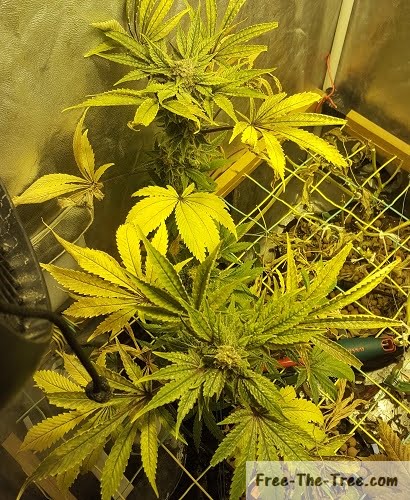
Blue Thai plant freshly harvested
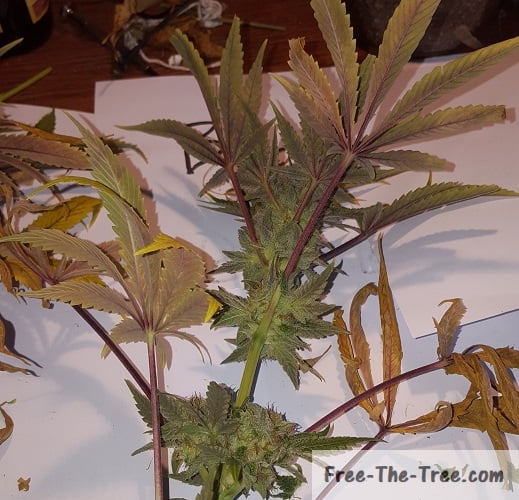
Branches cut from the tree and ready to be pruned

Small Blue Thai bud with purplish color
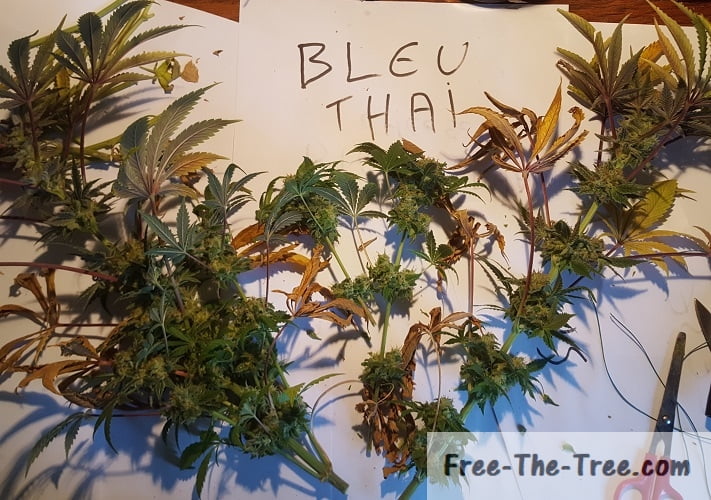
Each cola’s cut, ready to start pruning
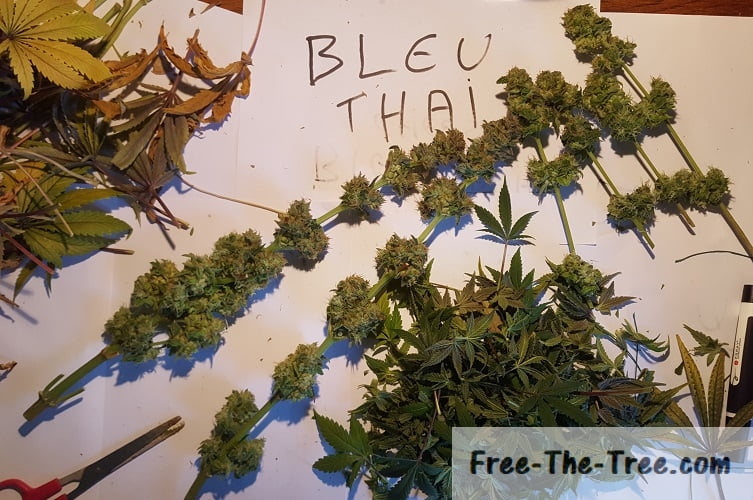
Pruned and ready to dry
As you can see the flowers aren’t that dense around the stems which is unfortunate, letting that cheese plant stretch so much really did damage to the yield of this little one.. (and to the blue kush up next)
Harvesting the Blue Kush
The Blue Kush is a pretty beautiful plant, especially since we were able to get temp differences over 10°C between day and night hours, allowing the plant to get that purplish/blue color. Unfortunately, she also stretch hard due to the Cheese.. Competition for the light source doesn’t joke around ^^
As you’ll see in the images below, she really built up her stem size, producing only a few scares buds 🙁
She really suffered a lot more from the heat than the Cheese plant

The Blue Kush’s last instants in the tent – You can see the heat stress on the Apex
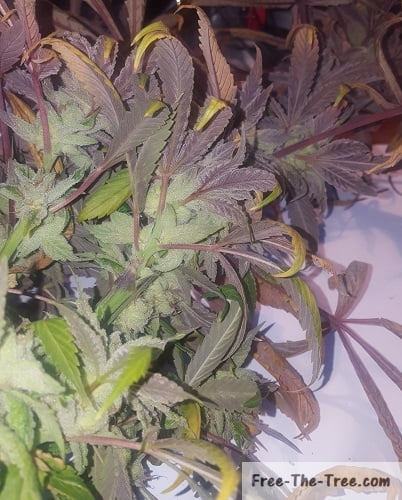
Freshly harvested Blue Kush Cola wearing her Beautiful Purple dress
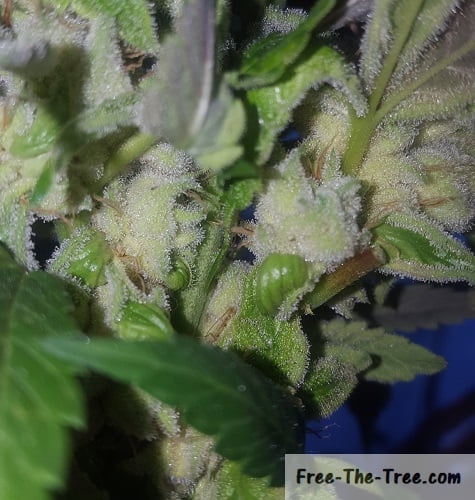
Focus on bud full of Trichomes

The 3 Blue Kush Cola’s harvested. More leaf and stem than bud

Pruned and ready to dry
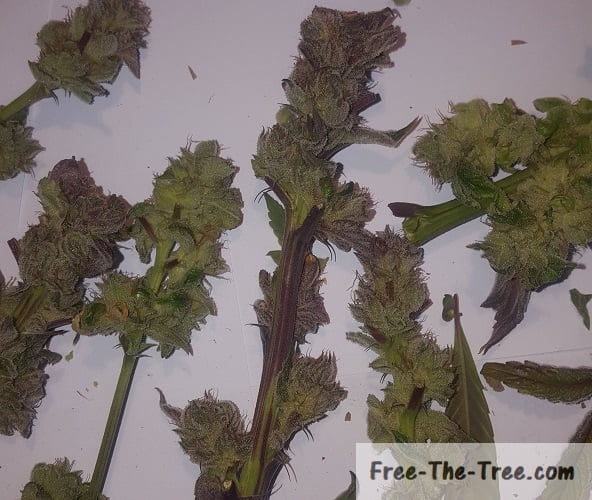
Close up on some of the purple flowers
Between the stretch for light and the heat stress generated from being so close to the light this “little” one really didn’t produce a lot of buds, although she really was beautiful.
I don’t feel as bas as the Blue Thai since we’ve germinated 3 seeds of this one for the next round, we’ll get another crack at her 🙂
Remaining Stems & Roots
Before we get to drying and curing of the buds, check out the nice stems and root systems these babies had developed
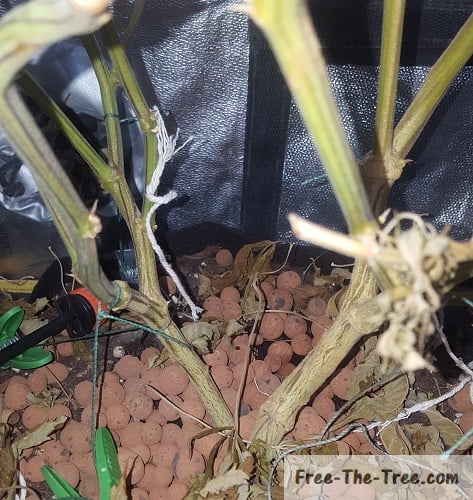
V Stem used as base for SCROG
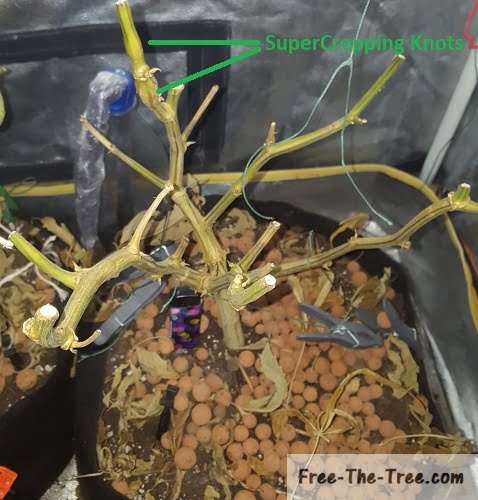
2nd Scrogged Big Budha Cheese Plant
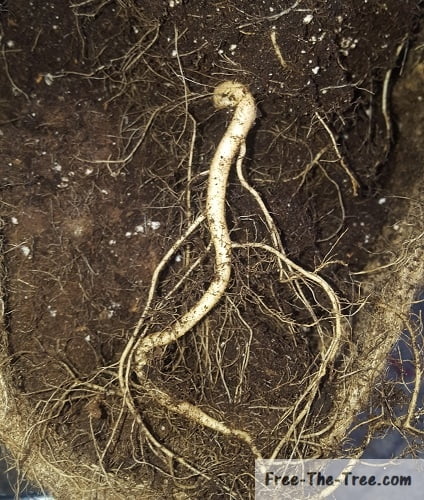
Main tap root (yeah, same one that broke the seed shell ^^)
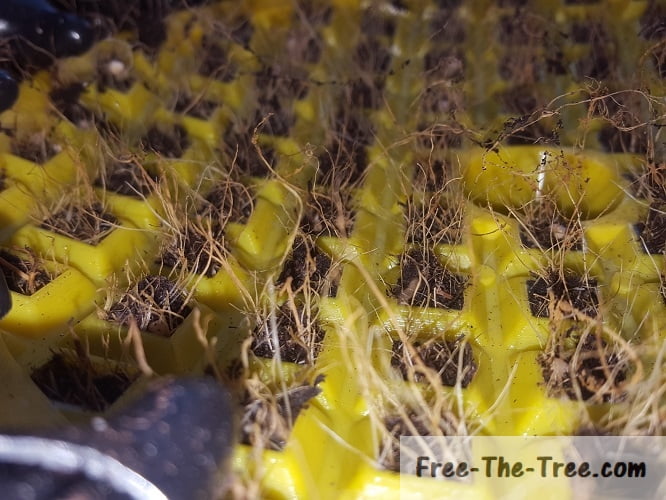
Naturally pruned roots at the base of the Air pot
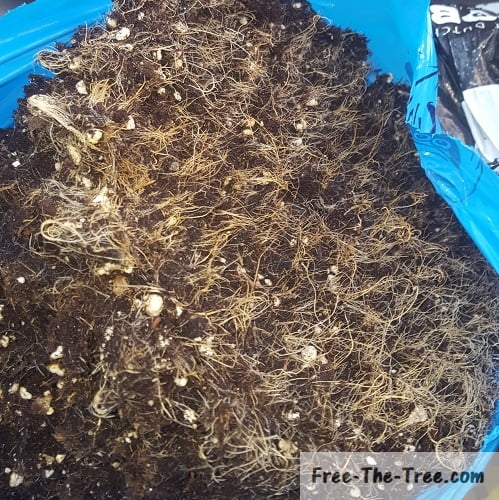
Root system developed when using an air pot
Aren’t the root systems awesome? Between the thick tap root and the thousands of mini roots, no wonder they kept producing sap even days after harvest.
The Blue Kush had even grown so much into the fabric bag that it tore when we tried removing the soil, crazy ^^
Seeing this I definitely see why it’s an issue to be using plastic pots, and definitely won’t ever be using them again.
Drying and Curing the buds
Now that all our plants are harvested and pruned we’ve done about half the work, the most crucial steps of the whole process still lie ahead.. Drying and (especially) Curing your buds.
We did a whole article over here if you want all the details, here we’ll mostly just show you the pics of this round’s drying and curing, since we had a bit more than we could handle we had to get inventive ^^

Cheese and Big Buddha Cheese buds drying in cupboard
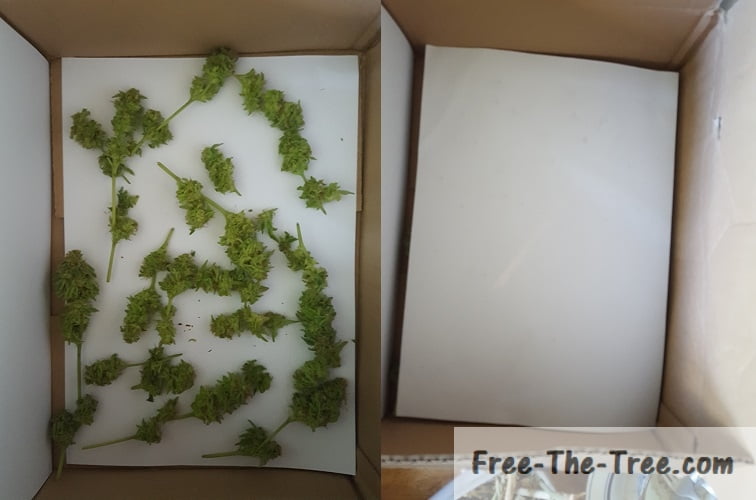
Buds drying between sheets of paper in a cardboard box
If you can, definitely avoid the cardboard box solution, the buds at the bottom may finish flattened due to the weight of the buds on top. If you must go for this, rotate regularly the layers of buds.
The important here is to keep your buds in a dark and dry space. Personally I do this until your hear a little crack when bending the stem, at which point they go into some jars to start the curing process 🙂
Key points during the drying process:
- Keep your buds in a dark area; Light will attack the trichomes
- Keep the buds in a dry space.
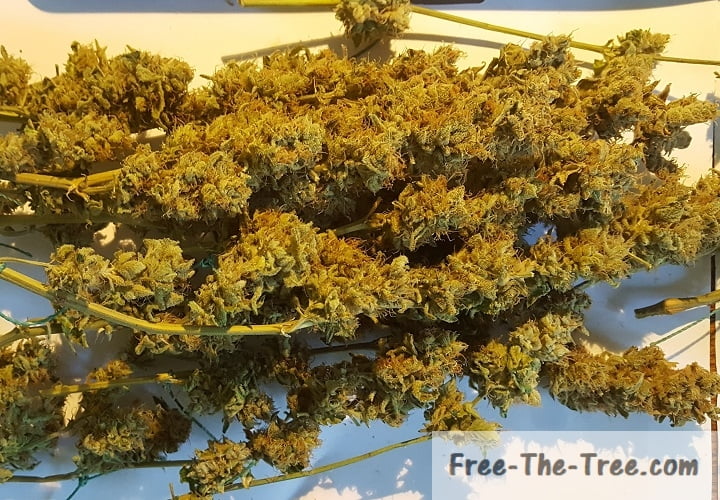
Buds done drying – Ready to weight and cure
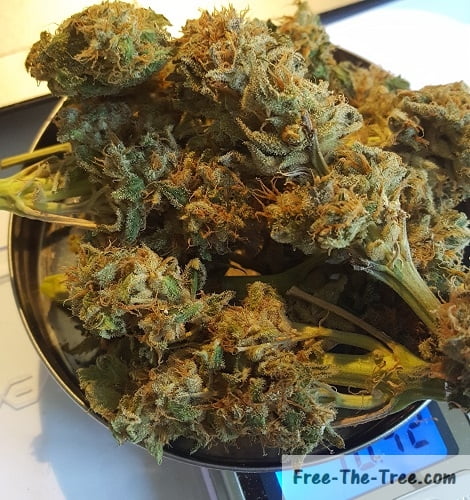
Blue Thai buds on the scale
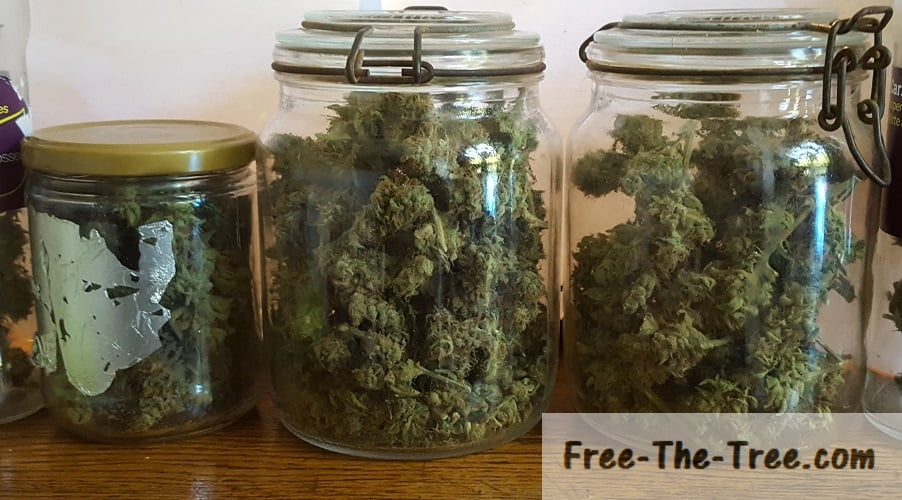
3 of the Big Buddha Cheese jars
Now that your buds are in the jars the process is almost over!
The flowers should still be pretty humid, so for the next 2 weeks you’ll want to open them at least a half hour a day.
Once they start to be crispy, you can add a humidifying packet (~50% humidity) and open them every other day or so.
Key points during the curing process:
- While the buds are still humid, open the jars regularly.
- Store in a dark area. Just as it’s true during the drying process, light will attack trichomes.
- Regularly rotate the buds inside the jar. Since the ones on top will dry faster, you’ll want to even it out.
- Curing can go from 2 weeks to 2 years, just like wine taste and smell will improve with time.
If you go for a long term cure, remember to add humidifying packets. if you don’t the buds will be so dry that they break like dust.
Before we wrap up this final grow report of the series we wanted to go over the main teachings that came to our mind while writing this piece, so here we go
Key Teachings of this Grow
- You must nurture your soil
We all agree that trashing your soil every other grow isn’t a long term solution. That said, plants suck out all nutrients from the soil and the nutrients that are given generally only contain NPK, whereas the plant actually needs over 20 macro and micro nutrients which got us thinking.. how do we get this working long term?
After a bunch of research we found alfalfa and nettle manure which feeds the soil with all these nutrients. That discovered, we decided to plant a bunch out side and start making our own to regenerate our soil, we’ll keep you posted! 🙂 - Thrips are a bitch
Yeah, these suckers followed us since the end of last grow, throughout this one, and we still have signs in the next one.
If you have signs of these suckers, nuc’em!!! - Keeping a flat canopy is key
If you’ve been following this grow you’ve seen that since the stretch our canopy is far from even, and as you saw, especially with the Blue Kush and Blue Thai, this had a very significant impact on the final yield of each plant. - Don’t wait too long to harvest!!
By waiting too long the trichomes start to deteriorate too much and the THC&CBD levels actually go way down. I think we weren’t too far from that with the Big Buddha Cheese - Super Cropping seems to work very well
Alright folks that’s it for this one!
Hope you enjoyed the last post of this series, see you soon with the first months worth of the our 3 Blue Kush’s and 1 Critical plants that are currently nearing the stretch 🙂
Until next time,
be safe and grow easy
Hey there and welcome (back) to Free the Tree!
This week we finally got enough soil to transplant the Blue Kush plant which started showing some Phosphorous issues which got us a little worried.
Apart from that we also finally received the Neem Oil to start application on the plants and get rid of these nasty little Thrips; Let’s get into it.
Blue Kush Phosphorous issues and Transplantation
We had definitely waited way too long to transplant this little one, the roots started coming out the bottom of the pot, the veins of the leaves were turning purple, safe for the underside…
She also had totally stopped growing which really had us worried. He’s some images, but before that check out our article on transplanting a weed plant if you want to know more.
Blue Kush Phosphorous issues
So this was the first time it had ever happened to us, the plant had stopped growing, the veins and the bottom side of the leaves were turning purple.
Here’s a couple pics, as always you can click on them to get the full view.
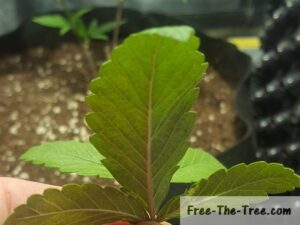
Leaf turning Purple – Signs of Phosphorous issues.
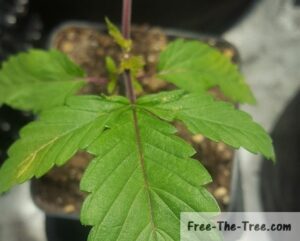
Main vein turning Purple and stopped growth.
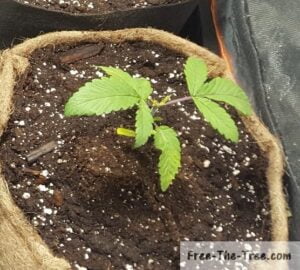
Growth starting back up after Transplantation.
Transplanting our Blue Kush
We definitely waited waaaay to long to transplant this little one. The main reason why was that I didn’t have enough soil so really couldn’t..
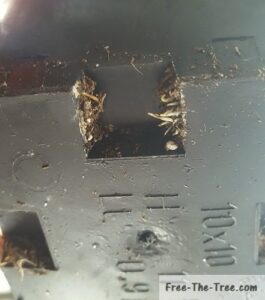
Roots starting to stick out of the bottom of the pot.
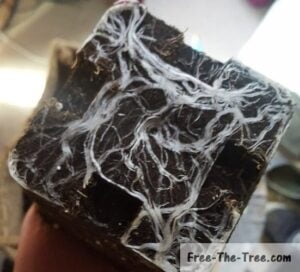
Well developed root system of the Blue Kush
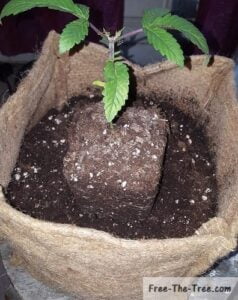
Well developed root system of the Blue Kush
As you can see with in those 2 first pictures the roots were definitely blocked and compressed, which easily explained why the plant had stopped growing and the Phosphorous issues.
Since the roots of the plant is her only way to get nutrients from the soil to the top of the plant, by having them so compressed there was no way she could develop well.
During the couple days following the transplantation she started showing signs of growth right away which definitely reassured us.
Thrips Treatment continuing
During this week we’ve been spraying the plants about 15 minutes before lights out every other day. The objective of this is to kill any survivors or newly hatched Thrips that could start the infestation back up.
Since the first treatment we’ve only seen 1 larvae on the plants so it seems to be working pretty good. Really hoping that this is the end of this infestation, but just to be sure we’ll be spraying neem oil every couple days for the next 10 days.
We grouped together all the info on how to kill Thrips over here if you want to know more.

Bottle of Organic Neem Oil

5 Plants at the end of 4th week
Alright guys that it’s for this one, until next time
Be safe and grow easy!
Don’t want to go yet? Check out our other Grow Reports
Check out all our Indoor Growing Tips
Hey there and welcome (back) to Free the Tree!
This week the flowering stage has officially started with the appearance of the first pistils 🙂
These 5 plants really grew a lot during the stretch, especially the Cheese and the Blue Kush (bottom middle and right) so we’re fighting an un-event canopy.. Apart from that they’re just beautiful!
Let’s go through the main events of the week, if you want to skip straight to a section here’s what we’re going to cover:
- End of vegetative growth
- Results of Super Cropping
- Automatic Water Run
- Switch to HPS lights
- First Pistils appear
End of Vegetative Growth
During this second week of the stretch we kept seeing strong growth across the board but, as we said in the intro, especially on the Cheese and Blue Kush strain.
Since the start of the stretch all the plants grew at least half their size except the Blue Thai. She’s a bit more shy which is a little bit of an issue canopy wise.
Here’s a couple pics of their evolution this week, as always click on them to see the full version.
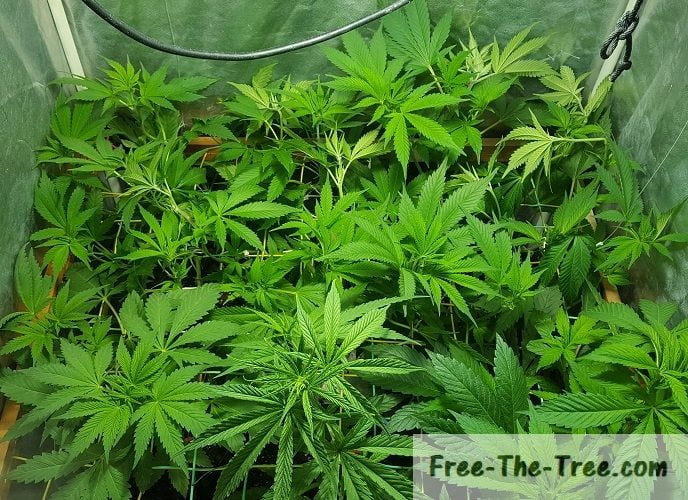
Start of the Second week – Room left in some area’s of the grow room
(Super Cropping just done)
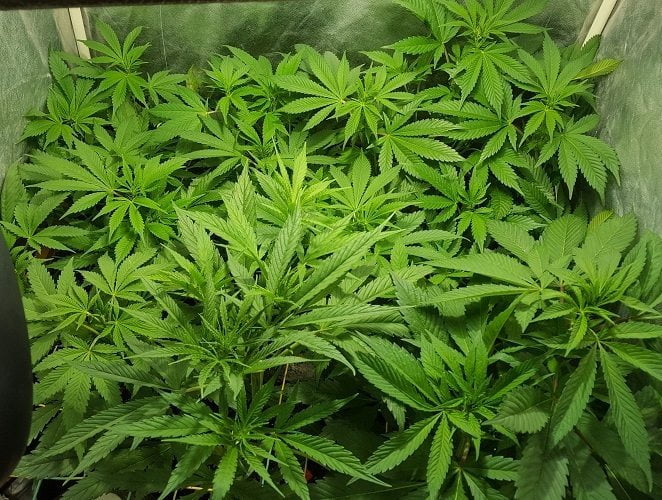
Mid way through week 2 – Grow Room is full
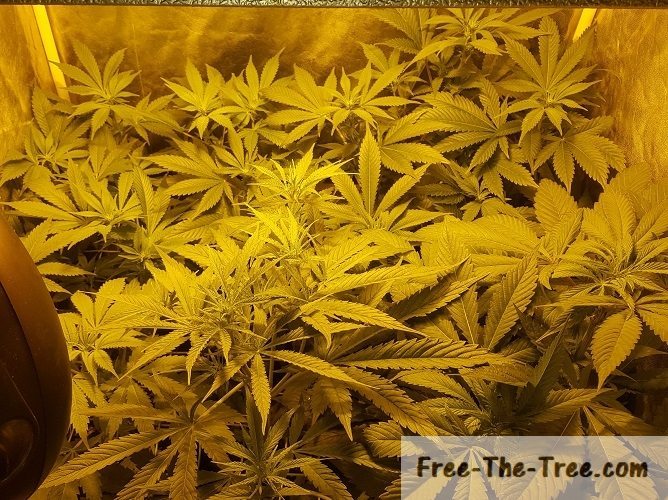
End of the Stretch – Vegetative growth has ended and first pistils are showing.
Just in one week it’s pretty crazy how much they’ve grown no? And compared to where the beginning of last week it’s even crazier! I love this plant haha
From now on they’re going to focus on developing those nice flowers that we love so much, some exciting weeks are ahead of us!
Results of Super Cropping
Last week and at the beginning of this one, we super cropped a bunch of the colas that were too tall.
There were 2 objectives for this, the first evening out the canopy, the second was so strengthen the stems and creating knots so the plant can store more nutrients within the stems.
Here’s how the Cheese plant reacted to it

Cheese plant super-cropped
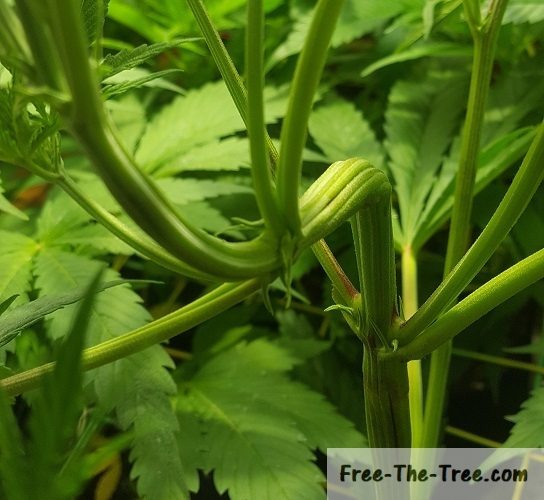
String holding stem removed a couple days later
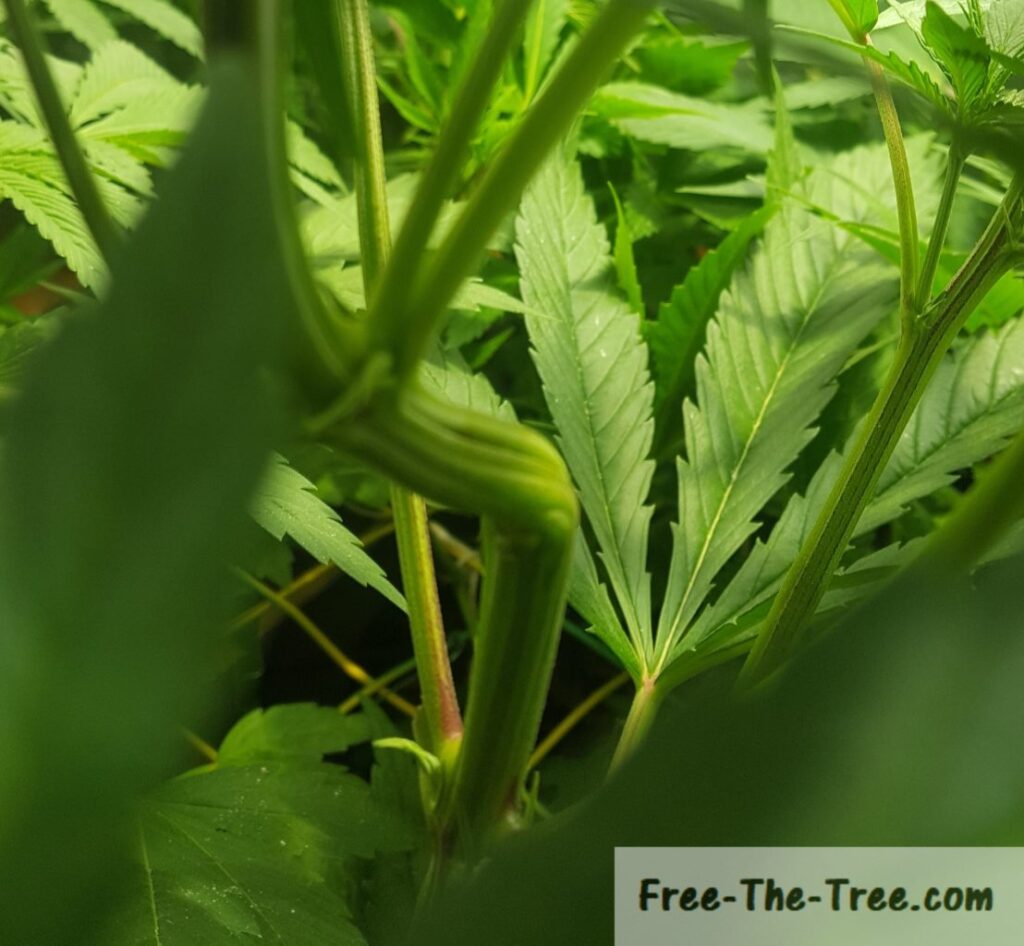
Colas standing back up – Knot starting to be visible
During the time that the main stem was super cropped the side branches grew massively, we pinched them a little so that they would strengthen also. I feel like this plant is going to give a niiice yield 🙂
Automatic Watering
We haven’t mentioned this in our previous posts but for the past month or so we’ve been watering our plants with our home made drip system and honestly it’s been wonderful!
It takes about 5 minutes to prepare the mix and then the the drip system waters the plant. We’ve been serving about 13L of water over about 6 hours of time. No water loss and the medium is well irrigated, the plant’s have been loving it! and honestly, so have I.
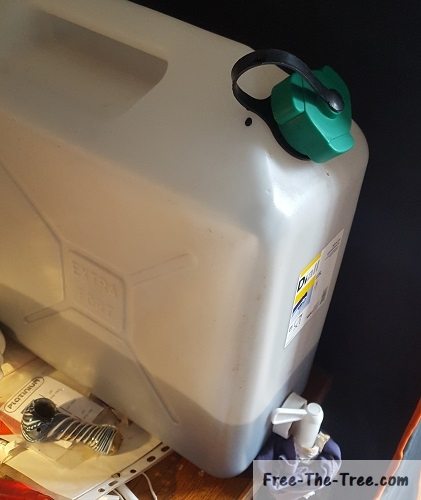
Water and Nutrients flowing into the grow room
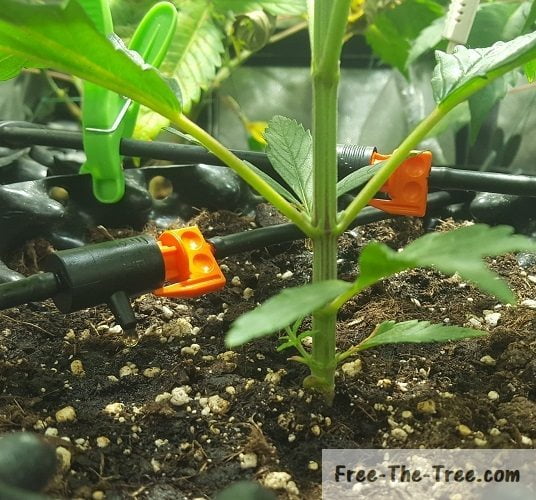
Drips slowly irrigating the soil
With this system in place, I don’t have to choose between taking the time to water them well (about 2hours) or quickly water them to be able to get back to business or whatever. We’ve done the later many times in our previous grows and you can definitely tell on the plant when the soil isn’t well irrigated.
It’s a win-win, I save time and the plants get a nicely watered and nutrient full soil on a regular basis.
Changing to the Sodium Bulb
I think this time around we waited a little too long to change from the Metal Halid bulb.
This time around we changed it the last day of the stretch, which might explain why we haven’t seen any pistils until now.. Next time we’ll definitely get it in there at the beginning of the second week of the stretch in order to avoid over-vegetating our plants.

Changing from HP to HPS bulb
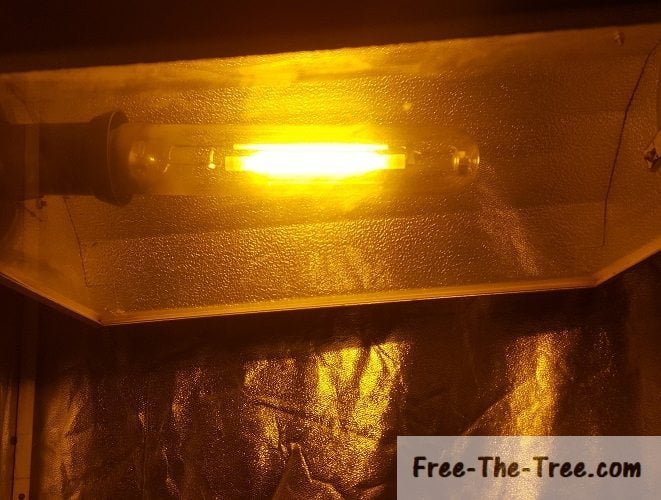
High Pressure Sodium bulb installed in an Air Cooled Hood
First Pistils appear
We’re finally in business! About 2 weeks after changing the photoperiods to 12/12 the bud sites have clearly showed up 🙂 How exiting!
This time around it really took them a while to grow, which I know for a fact isn’t normal for the Big Buddha Cheese and the Blue Thai. I really think it’s linked to the change in light, since the redder HPS light pushes the plant to flower.
Here’s a couple pics of these first signs of the flowers
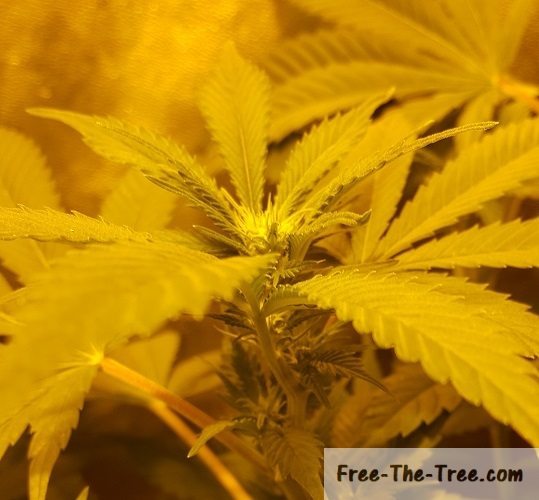
First Apex pistils growing

First pistils of another colas appearing
Alright folks that’s all for this one!
Until next time, be safe and grow easy 😉
Don’t want to go yet? Check out our other Grow Reports
Check out all our Indoor Growing Tips

